How To Update Footer In Wordpress
Since a WordPress footer is so useful, at some point, you must learn about the footer, how it works, what's possible in terms of editing it, and how to remove preset footer content that'due south not relevant to your brand. That'due south why we want to show you how to edit a footer in WordPress, along with a full explanation of a footer'southward benefits and what can go into one.
Website footers have a long history of containing whatever information doesn't fit inside a website'southward main card. From links to support documents and social media pages, diverse elements go rather well in a footer.
Let'southward become started!
What Is a WordPress Footer?
Footers aren't sectional to WordPress. Most website builders and content management systems offer the ability to include a footer. However, WordPress offers its unique footer functionality, along with a preset footer design that generally comes with the theme you install.
A WordPress footer sits at the base of your website. It's a static content area that shows up at the very bottom, regardless of which page a user lands on. Although not as visited as the header, the footer is notwithstanding extremely of import to provide users with social media buttons, client support links, and contact information.
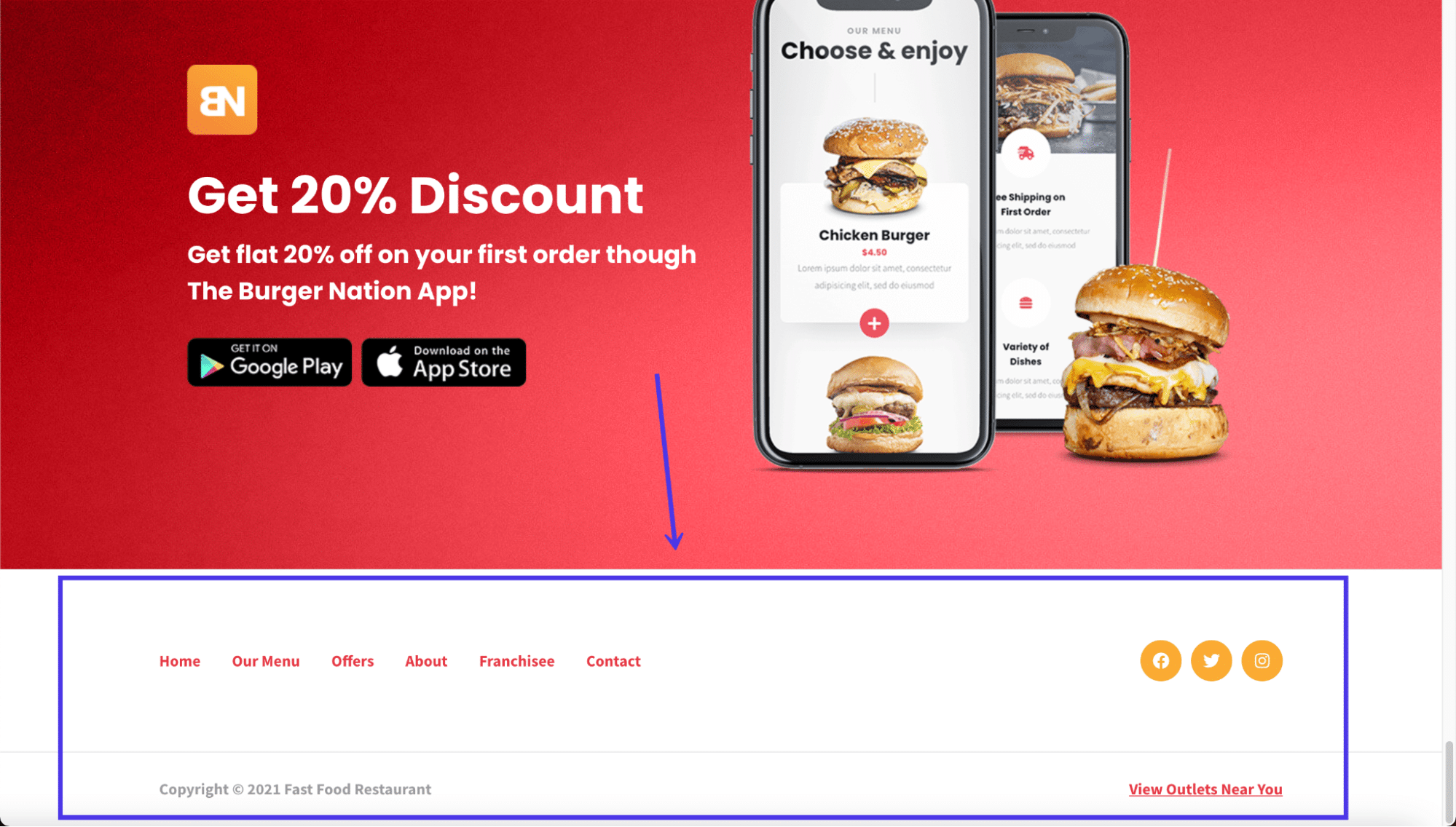
Overall, if you make a website on WordPress, you can await to run across a footer placed in your design by default. WordPress has a core file built into its system specifically to manage the footer (footer.php).
Footers come in all shapes and sizes, and you can edit them to include different colors, fonts, and backgrounds. Yous can also insert content elements inside the footer, such as blog mail service lists, security badges, and even forms and images.
The footer is like the decision to your entire website. It shows essential links and information for those interested in and dug deep into your content. Finally, the footer completes the overall design of your site, much similar the final slide in a slideshow presentation or the conclusion to a speech.
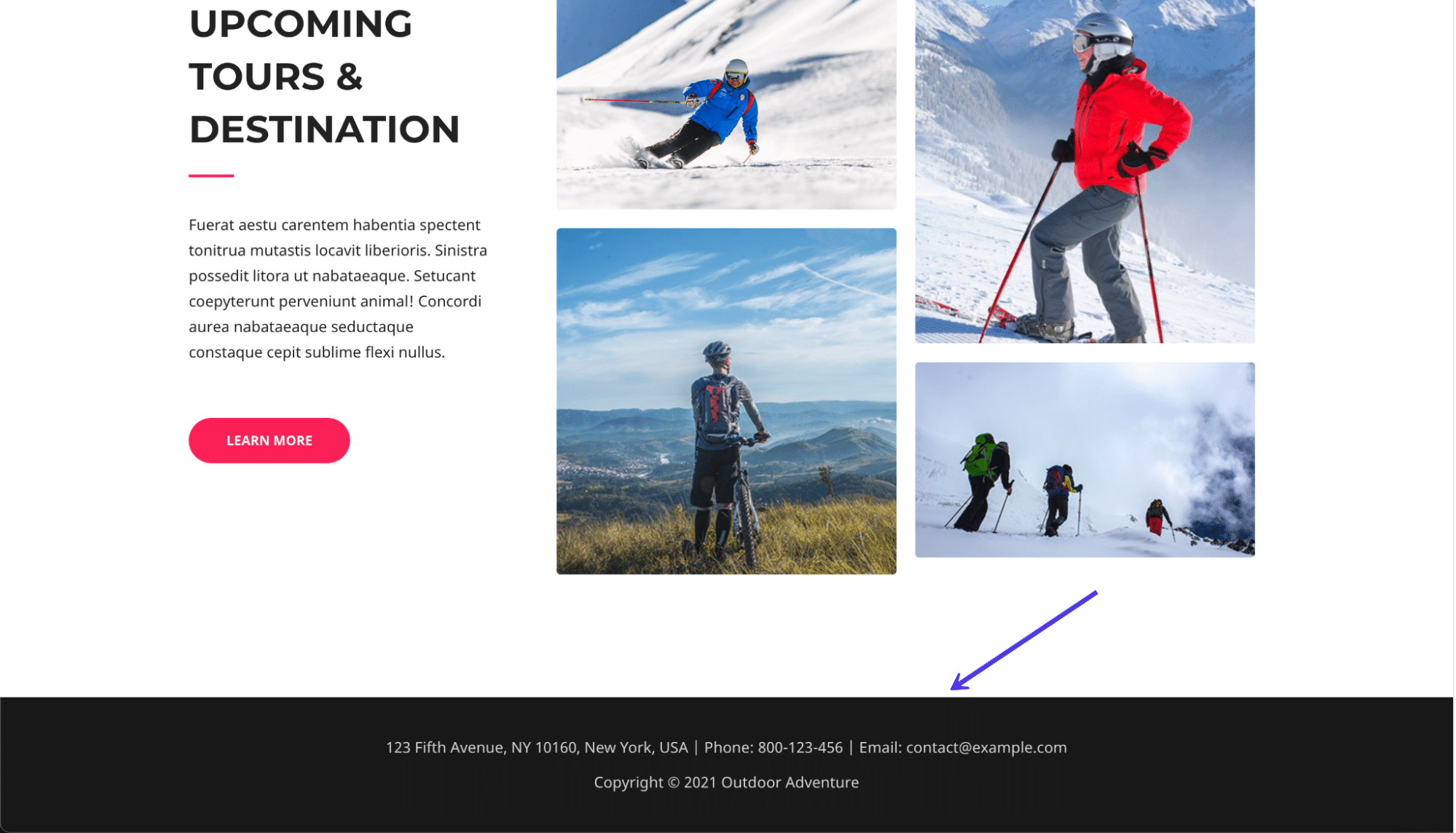
Reasons To Have (and Edit) a WordPress Footer
It'due south tempting to forget about your footer or get out it as the last detail you design. Many people even want to remove their footers since they don't see much value in them. This isn't the greatest plan. The footer does accept value, even if it's non viewed or clicked on as much as your principal menu or principal content areas.
To give you an idea of what makes a footer valuable, here'southward a list of all the reasons to have one and learn how to edit a footer in WordPress to fit your brand.
- The WordPress footer offers a static module shown on every page of your website, making information technology more visible than a standard page that disappears when someone clicks away.
- It completes the website'due south pattern, both visually and in your WordPress files. Information technology tells WordPress where to end its lawmaking and indicates to users when the content ends. Not to mention, it makes for a cleaner interface.
- Many internet users have come to expect specific links and content in the footer, then they'll go directly to the footer to discover them. Call back support links and social media buttons.
- The footer provides more conversion and engagement opportunities, similar a call to activeness at the cease of a blog post. You tin can add together forms, links to other content, or even a company tagline.
- It'south a place to include important links that may not make the cut for the main menu.
Now that we know the benefits of using a footer, the big question of what to place in the footer comes into play. All themes differ, but information technology's common to come across a "Powered by WordPress" message in the footer after installing a new theme.

Other times, theme developers might include their own premade designs or messages about who fabricated the theme.
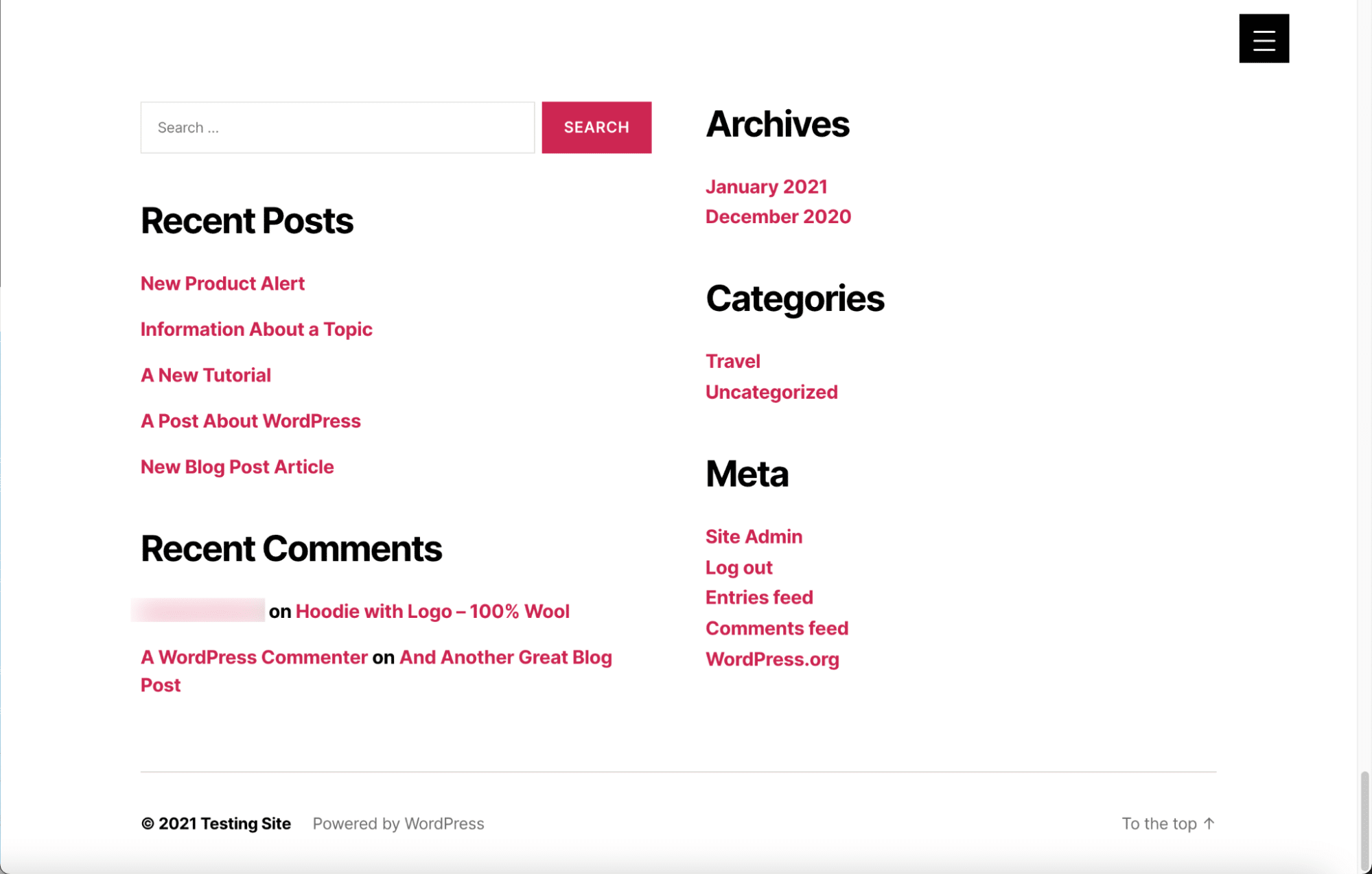
None of that's bad, but the goal is to customize your WordPress footer to link to your valuable pages, include content related to your brand, and clear out the default content similar messages from theme developers or WordPress. Information technology's also wise to adjust the styling to match your branding with custom fonts and colors.
And so, what are some elements to put inside your WordPress footer?
- Forms for users to subscribe to your newsletter messages or web log updates
- Links to customer support resources, like FAQs, knowledgebase manufactures, and forums
- Icon links to download digital products similar apps and podcasts
- A list of upcoming events
- A list of recent blog mail service articles
- Links to loyalty and affiliate programs
- Links to advisory pages, similar an Nearly Us or Career page
- Badges and icons to promote your reputation, by awards, or site security
- Social media icons that link to the pages
- A total sitemap for easier navigation throughout your website
- Legal statements like copyright claims, privacy policies, and terms and weather condition
- Contact data such as your address, locations, phone number, and business hours, or a contact form
- A search box for improved navigation
- Any other additional pages that don't fit in your main bill of fare but notwithstanding demand a place on your site
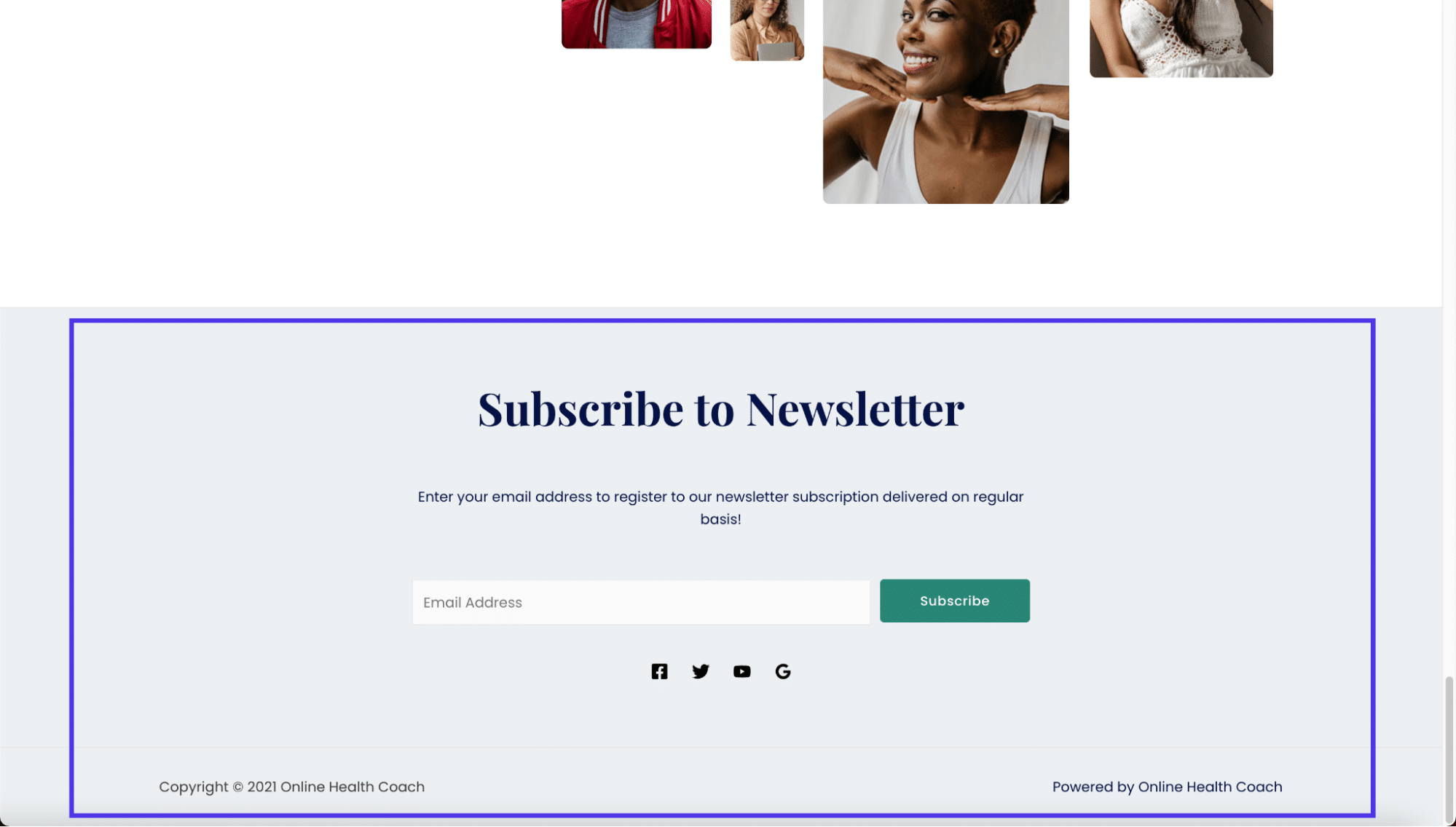
How To Edit a Footer in WordPress (Self-Hosted Version)
In that location are a scattering of tactics to edit the footer of a WordPress.org (self-hosted) website. In the following sections, nosotros'll talk about editing a footer in WordPress using the theme customizer, widgets, plugins, and lawmaking. Equally a bonus, nosotros'll discuss managing the WordPress footer with a visual page builder like Elementor.
Edit WordPress Footer with Theme Customizer
The fastest and about efficient way to edit a WordPress footer is by utilizing the built-in WordPress Theme Customizer. The Theme Customizer settings vary depending on your chosen theme, merely the customizer itself is e'er located in the exact location on the WordPress dashboard.
To brainstorm the process, go to the dashboard and click on Appearance and then Themes.
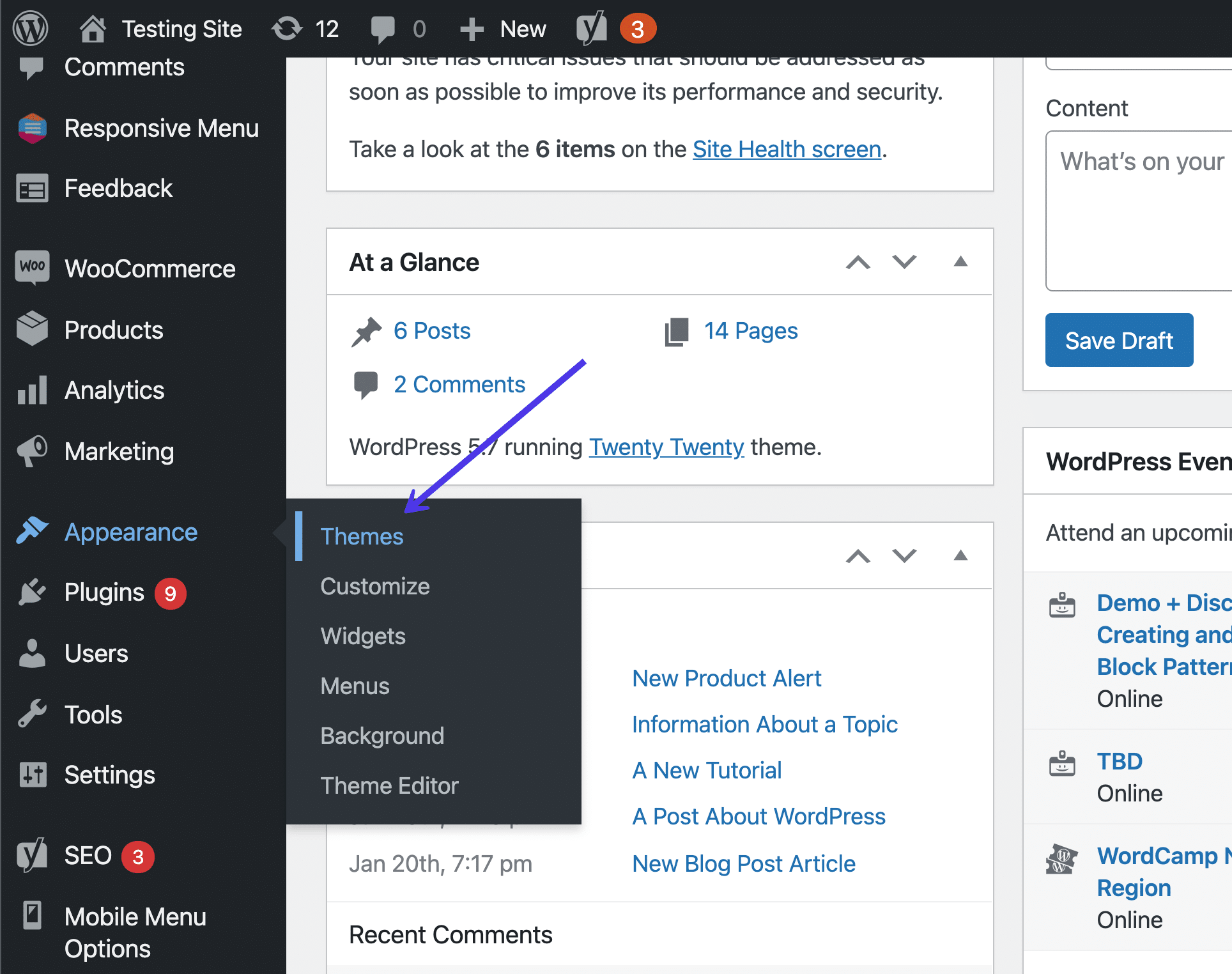
So, click the Customize button underneath the currently active theme.
Feel free to swap out themes to see how the footers alter from theme to theme.
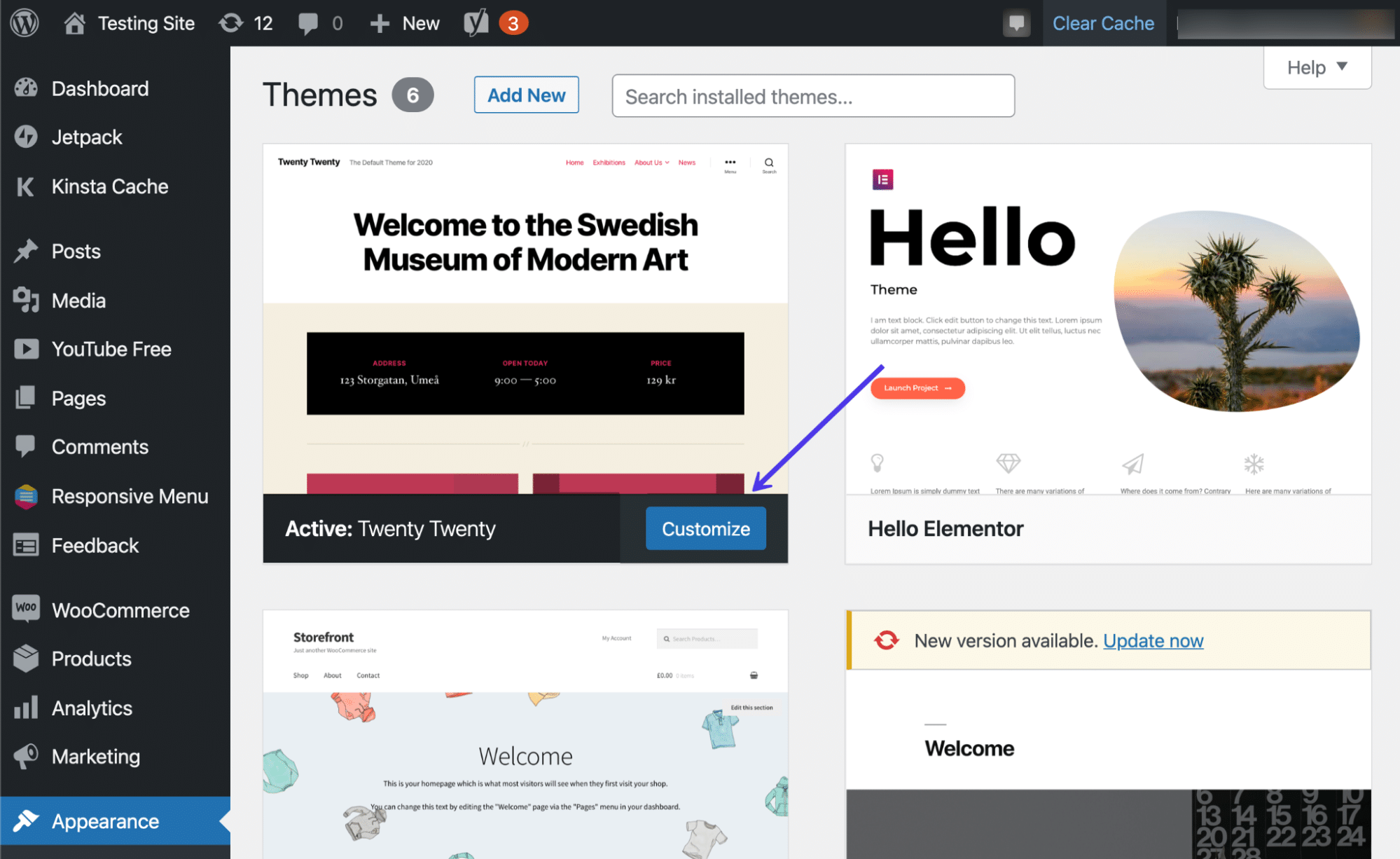
Every bit a slightly faster alternative, you can too click on Advent > Customize, which brings you lot directly to the WordPress Theme Customizer for the agile theme.
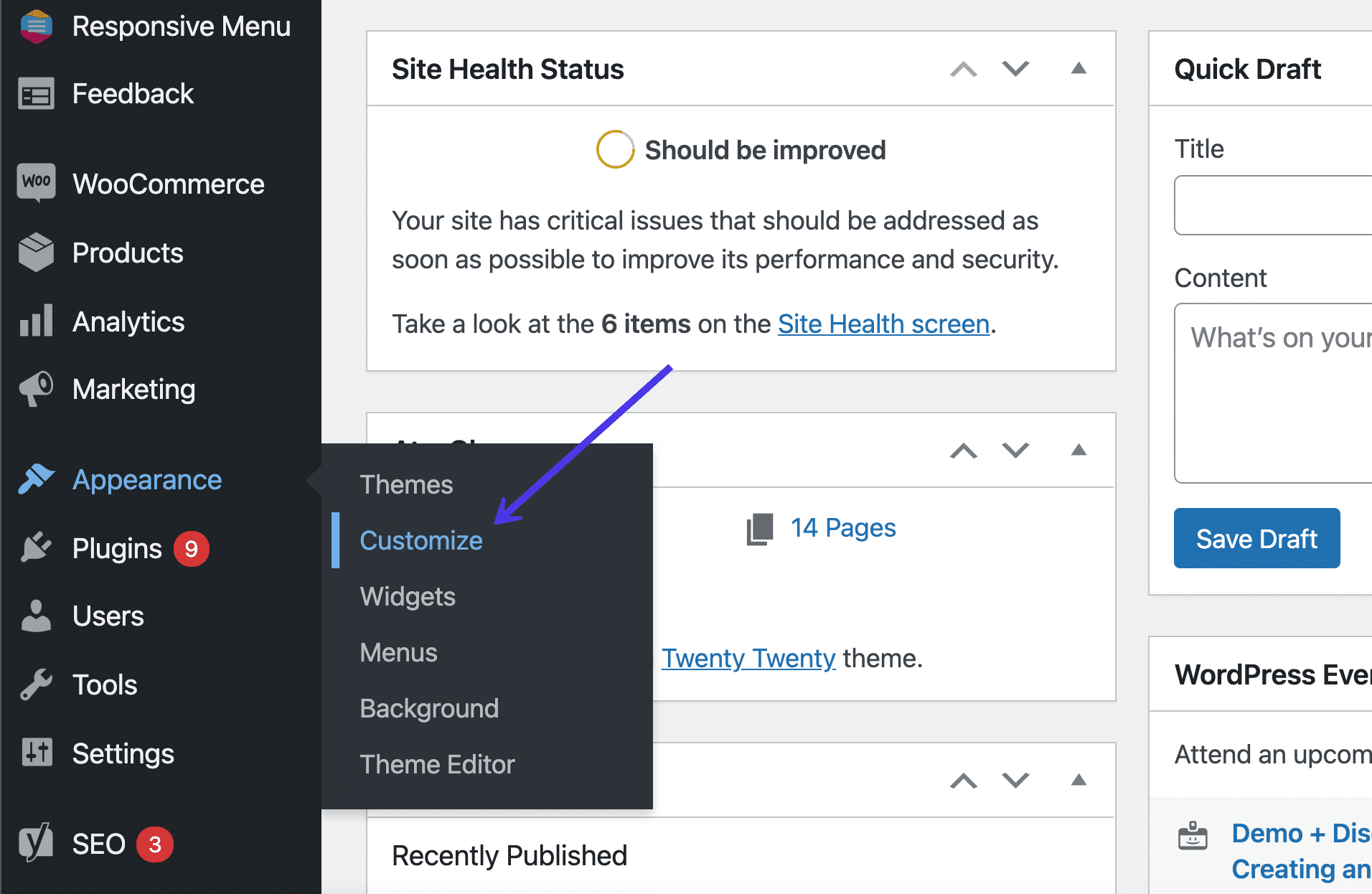
The WordPress Theme Customizer presents a visual of your website on the right side and several carte items on the left that lead to settings and customization tools. Once again, every theme has varying customization options, and then your screen may look a niggling unlike than what's in our screenshots.
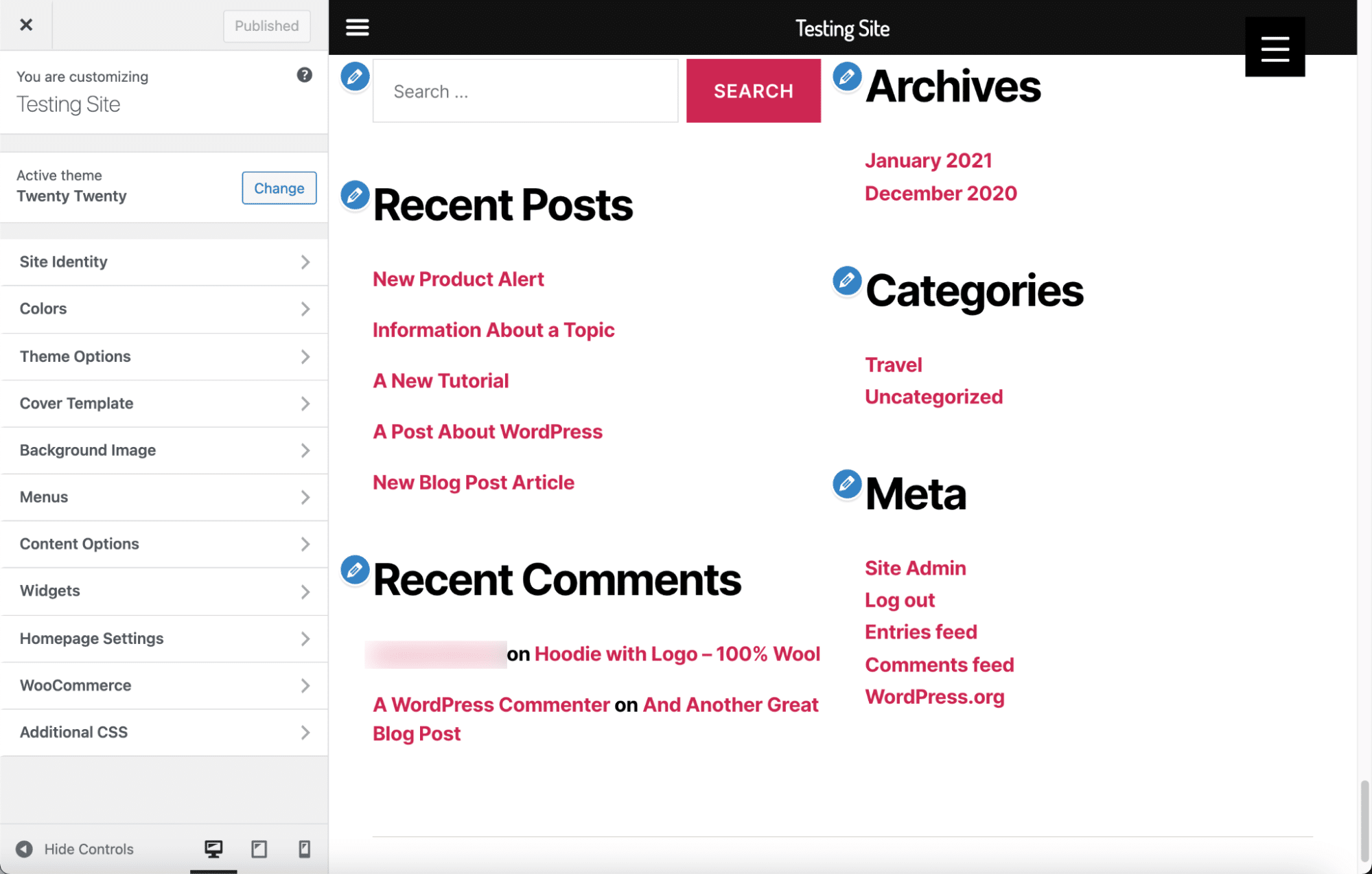
A wonderful place to commencement with your footer customization is with the colors.
Our current theme has a Colors button, making information technology easy to identify where we need to get.
Select the Colors button if that'south available in your theme.

Cull the Select Color push under the Header and Footer Background Color field.
Apply the color picker to exam all types of colors and see which ones lucifer your brand or await good towards the cease of your page.
With this particular theme, any color modifications actually accommodate the font colors as well, making them look clear regardless of the background color.
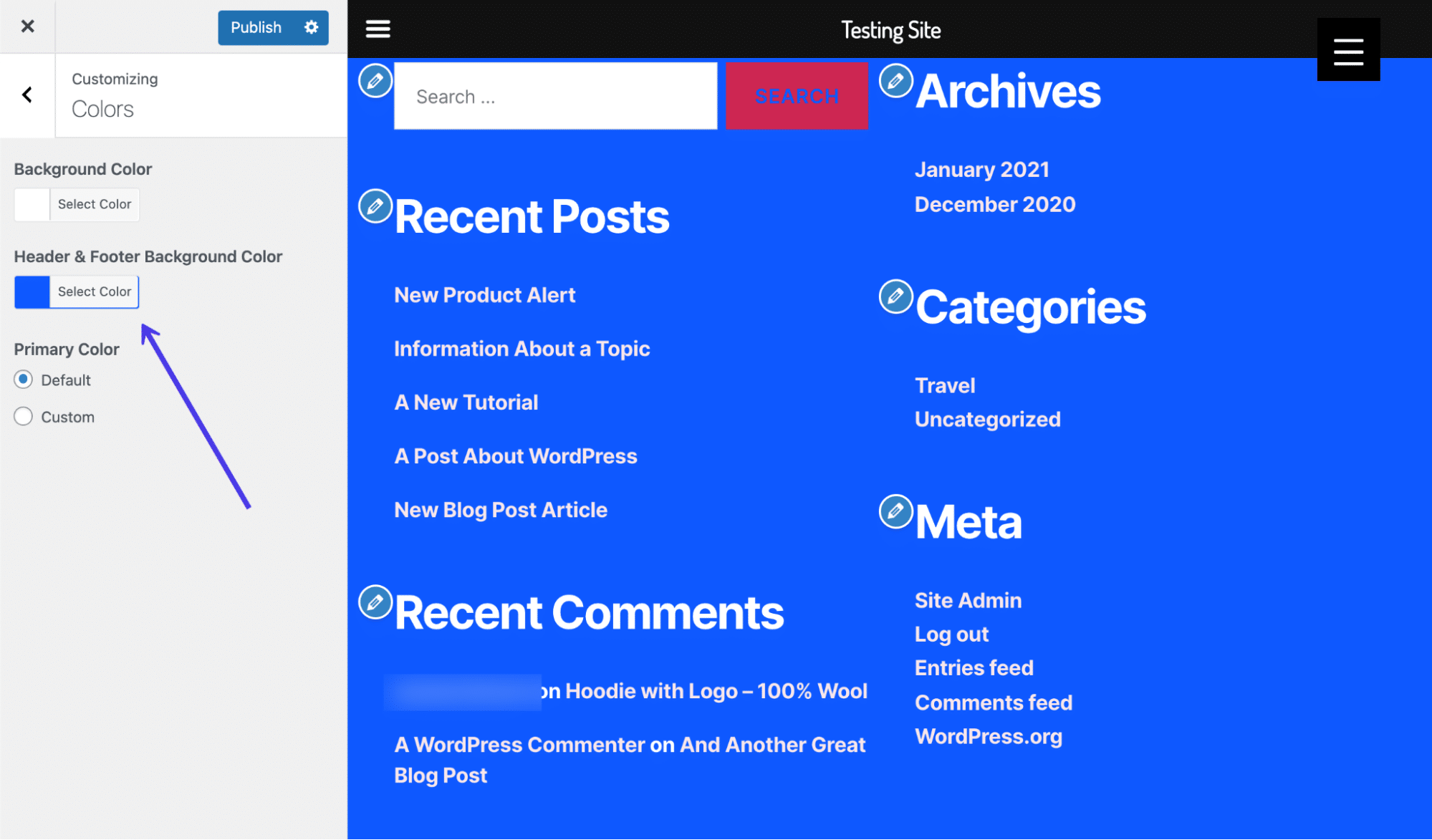
As you can see, a darker WordPress footer colour automatically changes the font colors for links, headers, and paragraph text, eliminating the need for you to do that on your own.
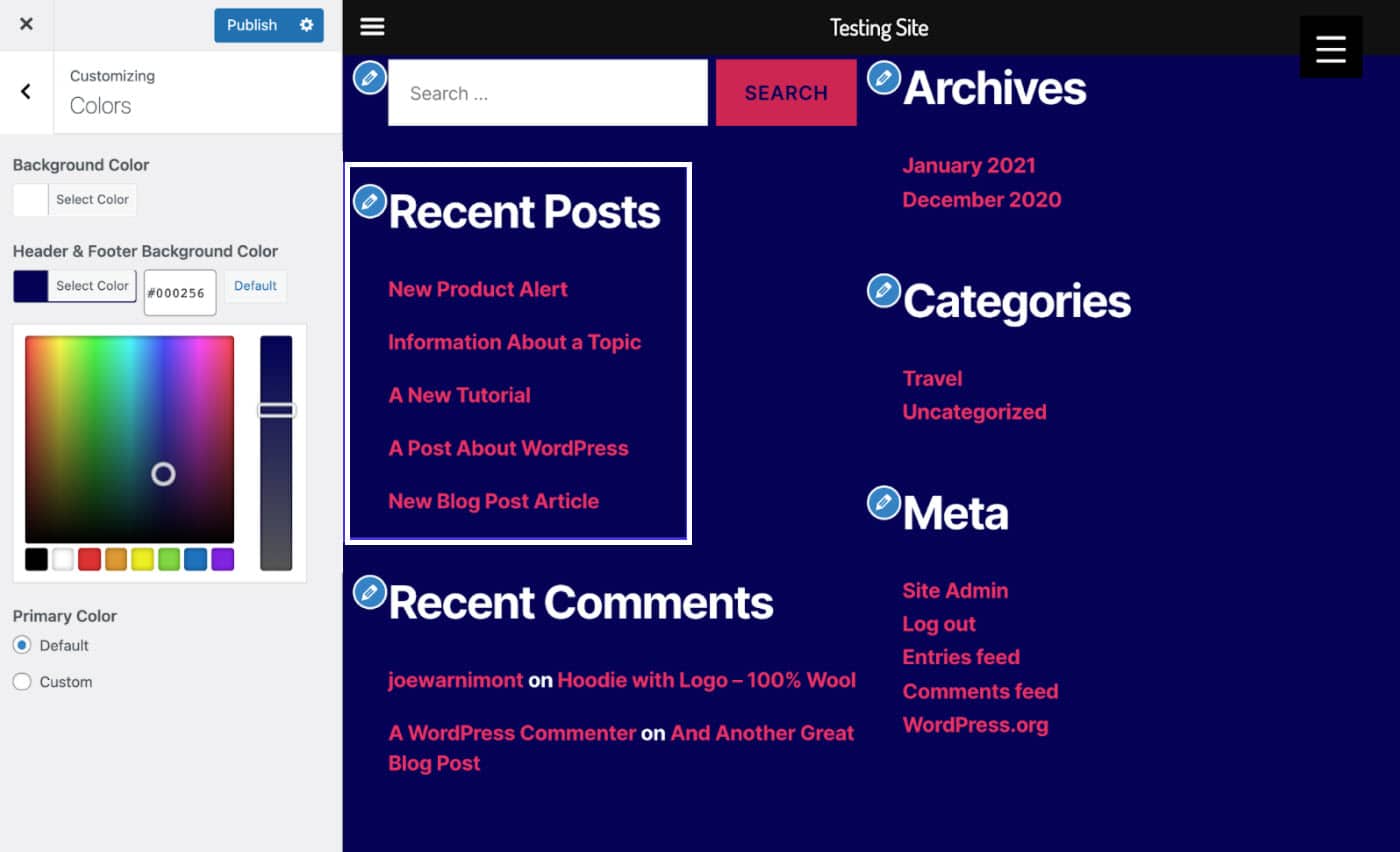
Now allow's endeavour some other theme. In this case, we've swapped out the 20 Twenty theme for the Storefront theme.
Certain plenty, the WordPress Customizer for the Storefront theme displays buttons non shown in the Twenty Twenty theme.
Therefore, your theme dictates how much command you take over the footer in the WordPress Customizer. Some themes are better than others in this respect.
For the Storefront theme, we accept a Footer tab. Click on that to run across what'south available for customizing the footer.
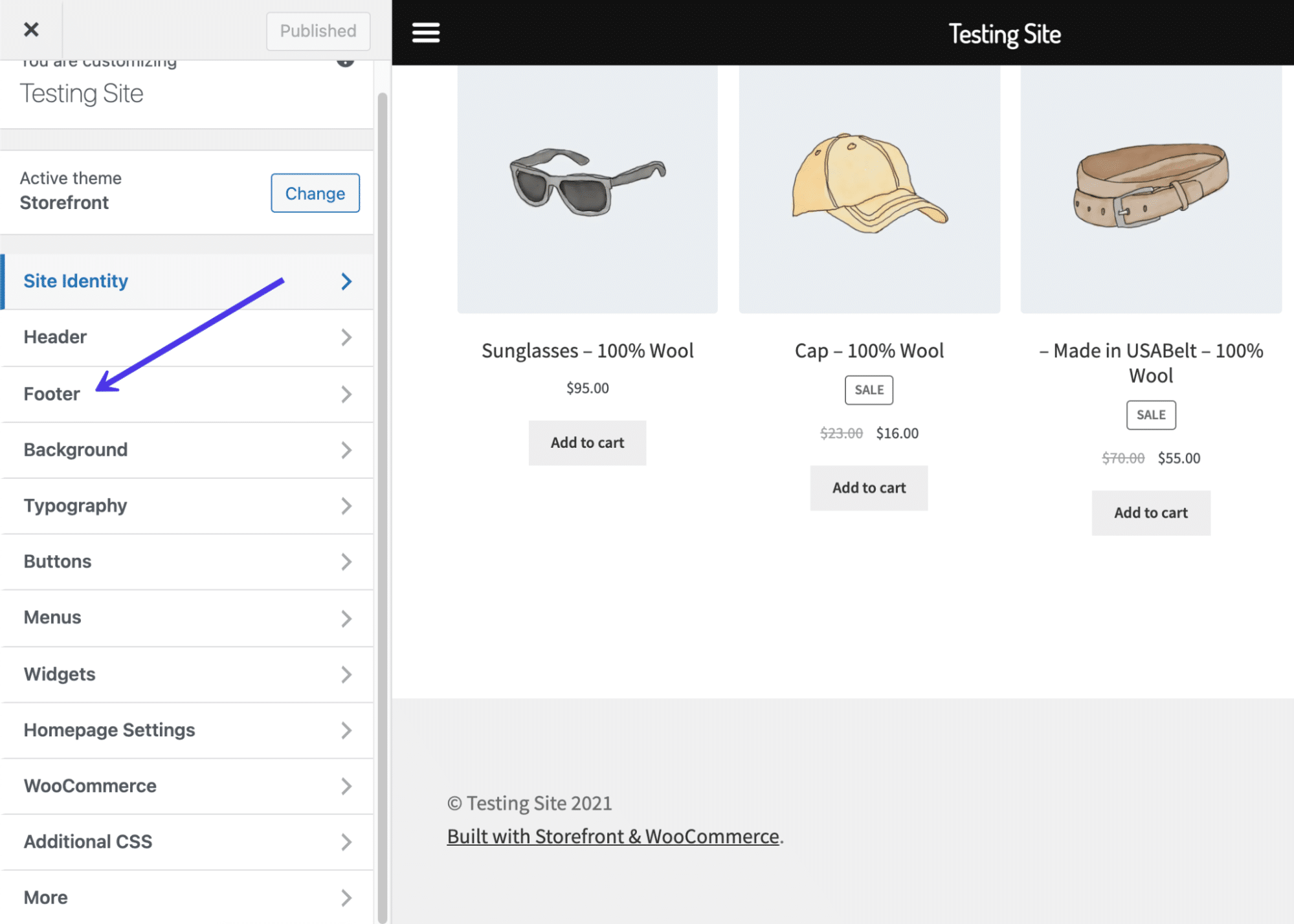
Unlike the previous theme, Storefront doesn't automatically alter text and link colors when you adjust the background colors. However, yous are able to control all of these colors on their own, with fields for the Background Color, Heading Color, Text Color, and Link Colour.
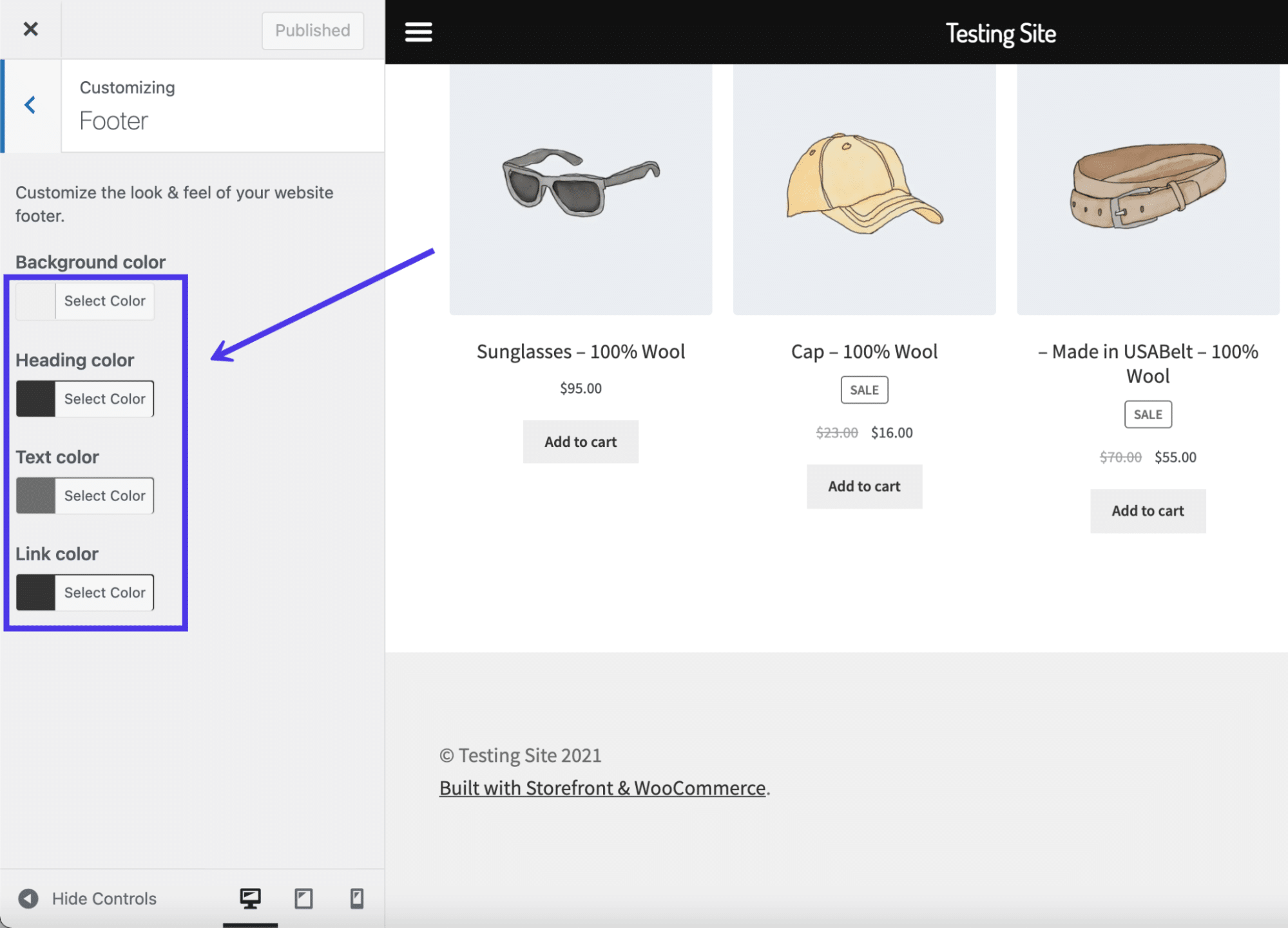
Footer colour settings
A quick selection reveals the results in our WordPress footer preview. After this, you lot should click on the Publish button to see the new footer colors on the front end.
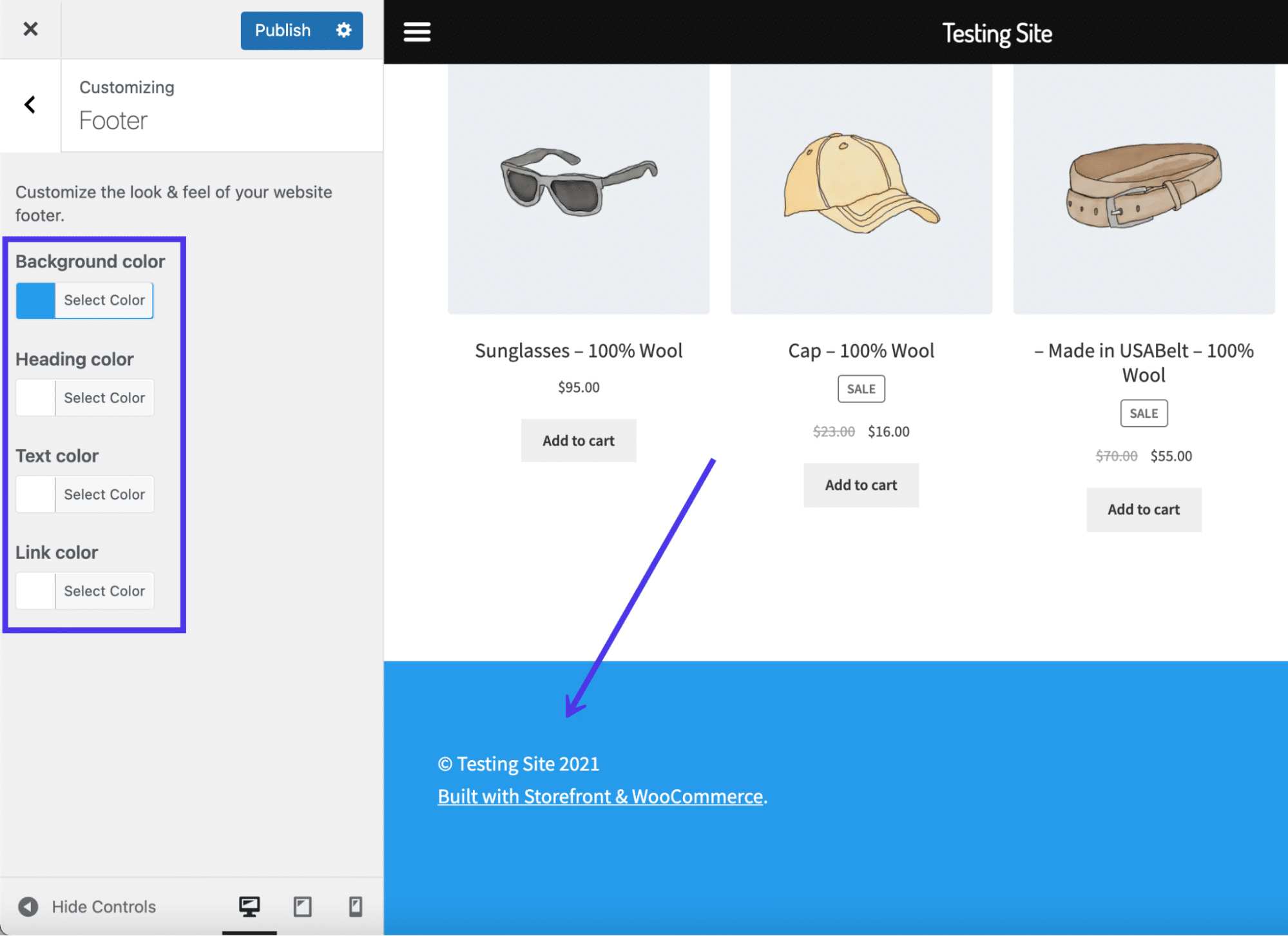
But what near the links and text elements presented by default in the footer?
Over again, the chief method to adapt the footer content is in the WordPress Customizer. In the coming sections, we'll explain how to add and remove text and link content from the footer using 2 methods: as carte items and as widgets.
Adding Widgets to Your WordPress Footer
One fashion to edit the footer content is by adding widgets. WordPress widgets have many functions, along with several locations for them to get, including the sidebar and footer, provided your theme supports that.
Back in the WordPress Customizer, await for the Widgets tab.
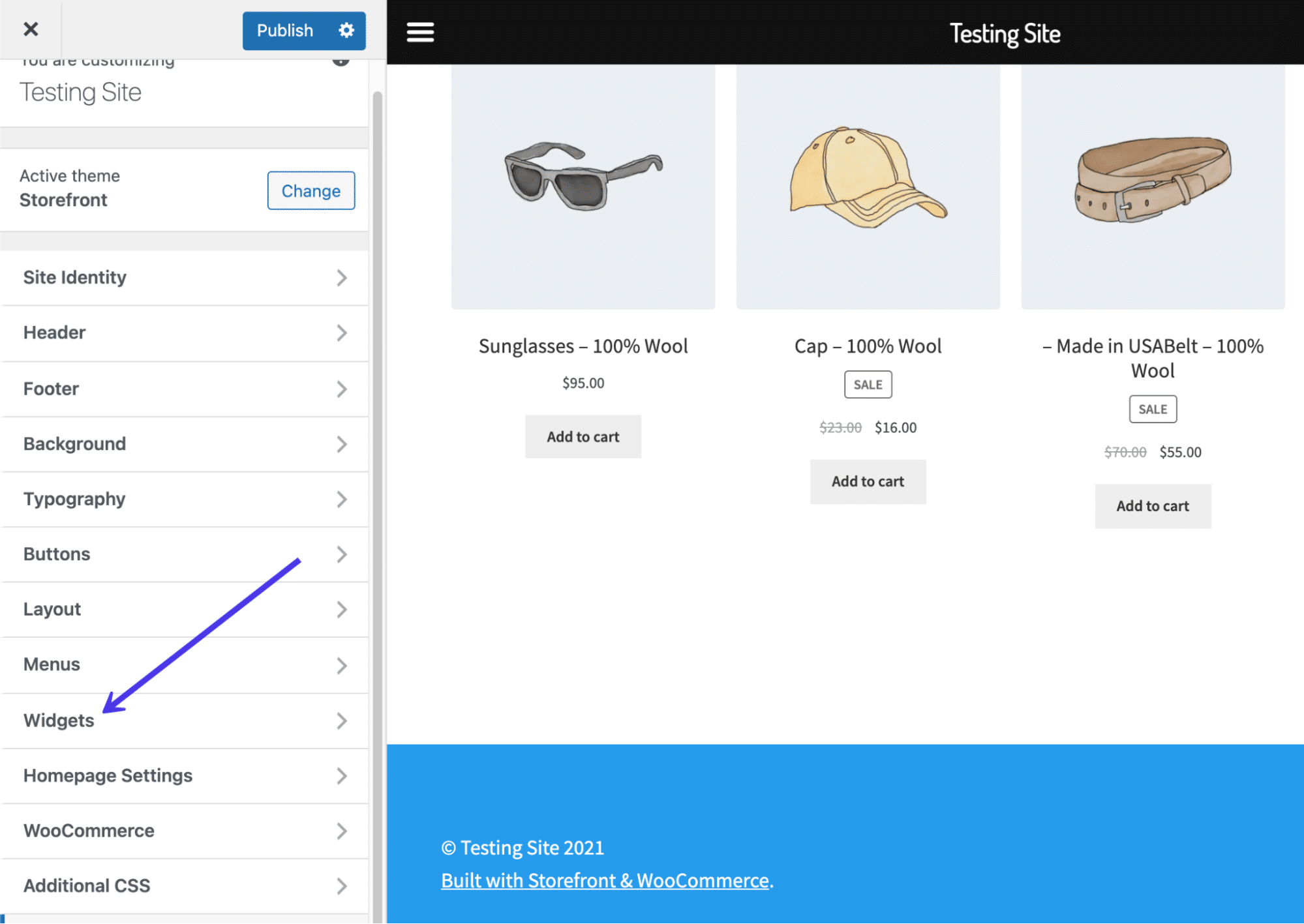
Peruse the listing of areas to identify widgets on your website. You may see options for regions like the sidebar, peak bill of fare, and bottom menu. Hopefully, your theme besides includes the footer every bit an surface area to place widgets. If not, there are other ways to edit your footer, though if you'd rather go with widgets, consider switching to a dissimilar theme that allows for widgets inside the footer.
This theme actually provides four widget locations in the footer, bundled in 4 columns stacked adjacent to make a beautiful format that fits as much content inside the footer equally possible.
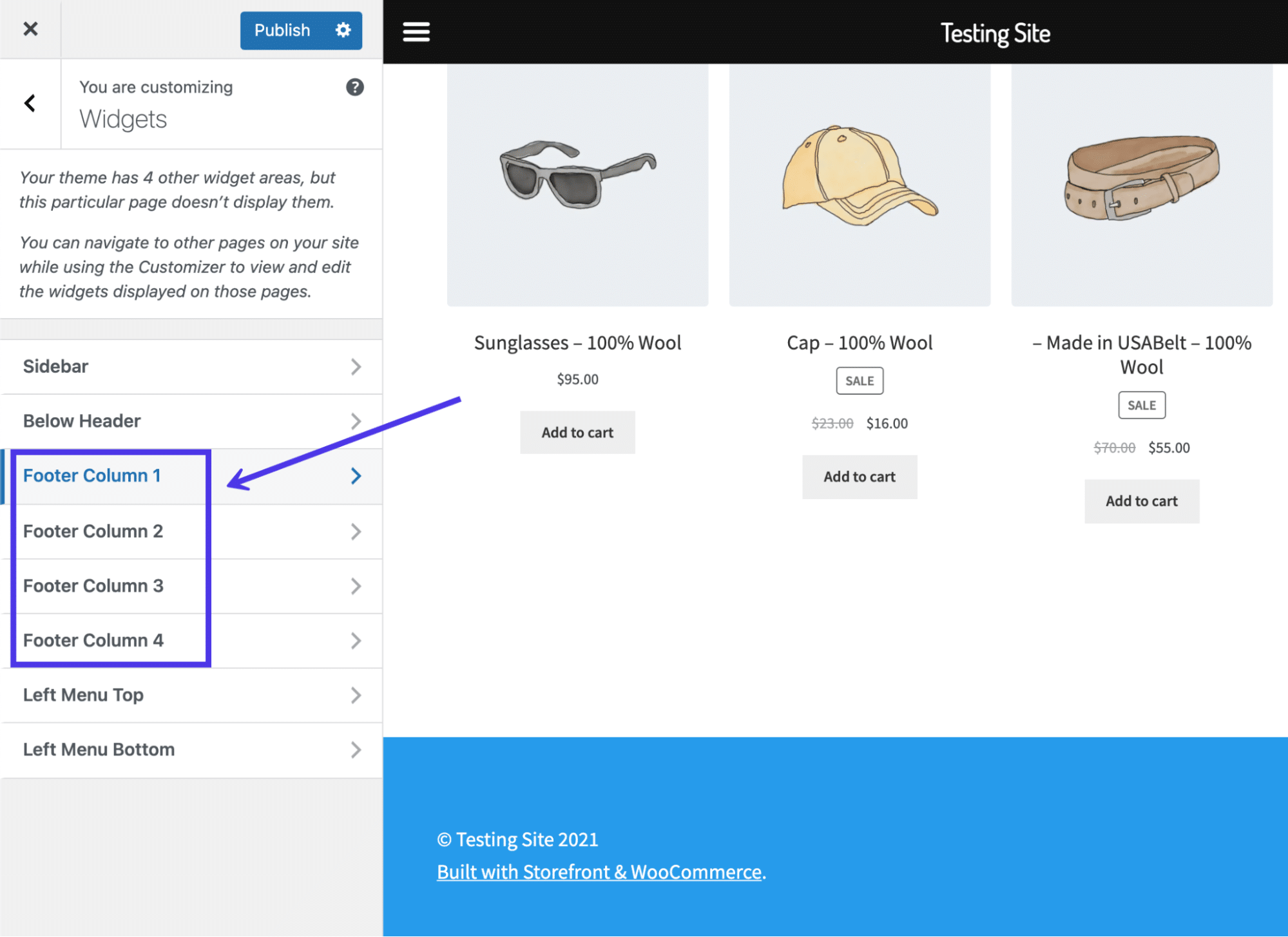
Click on whatsoever of the footer widget locations to reveal an area to Add A Widget. Click on that push to evidence a slideout view of all available widgets on WordPress and the theme. Once again, y'all may see a completely dissimilar set of widgets, considering some themes include their own widgets, or you may accept installed an extension or plugin to add more widgets to your dashboard.
Common widgets range from Archives to Audio and Custom HTML to Product Filters.
All you accept to do is select the widgets to add together to this particular widget expanse. They'll testify upward on the left-hand side for you to reorganize and configure their individual settings.
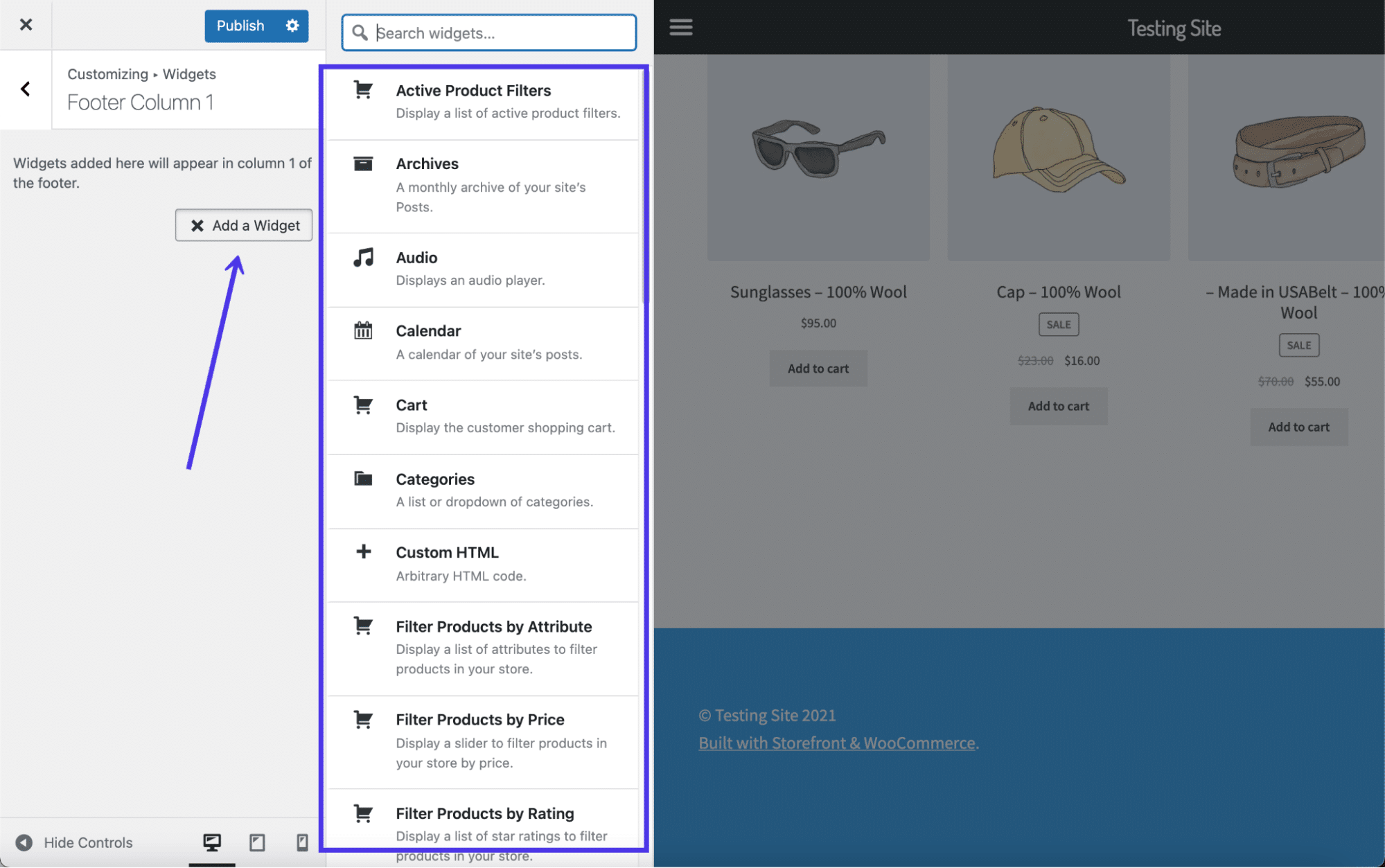
After some quick work, we've placed several widgets in three of the footer column modules, including a main menu, a list of recent posts, and a few of the products from our store. You'll also notice nosotros added a search bar to make navigation a little easier for our users.
Ane important area to notation is the widget settings section. Each widget has its ain settings on the left, so be sure to walk through those fields and make them await exactly as you want.
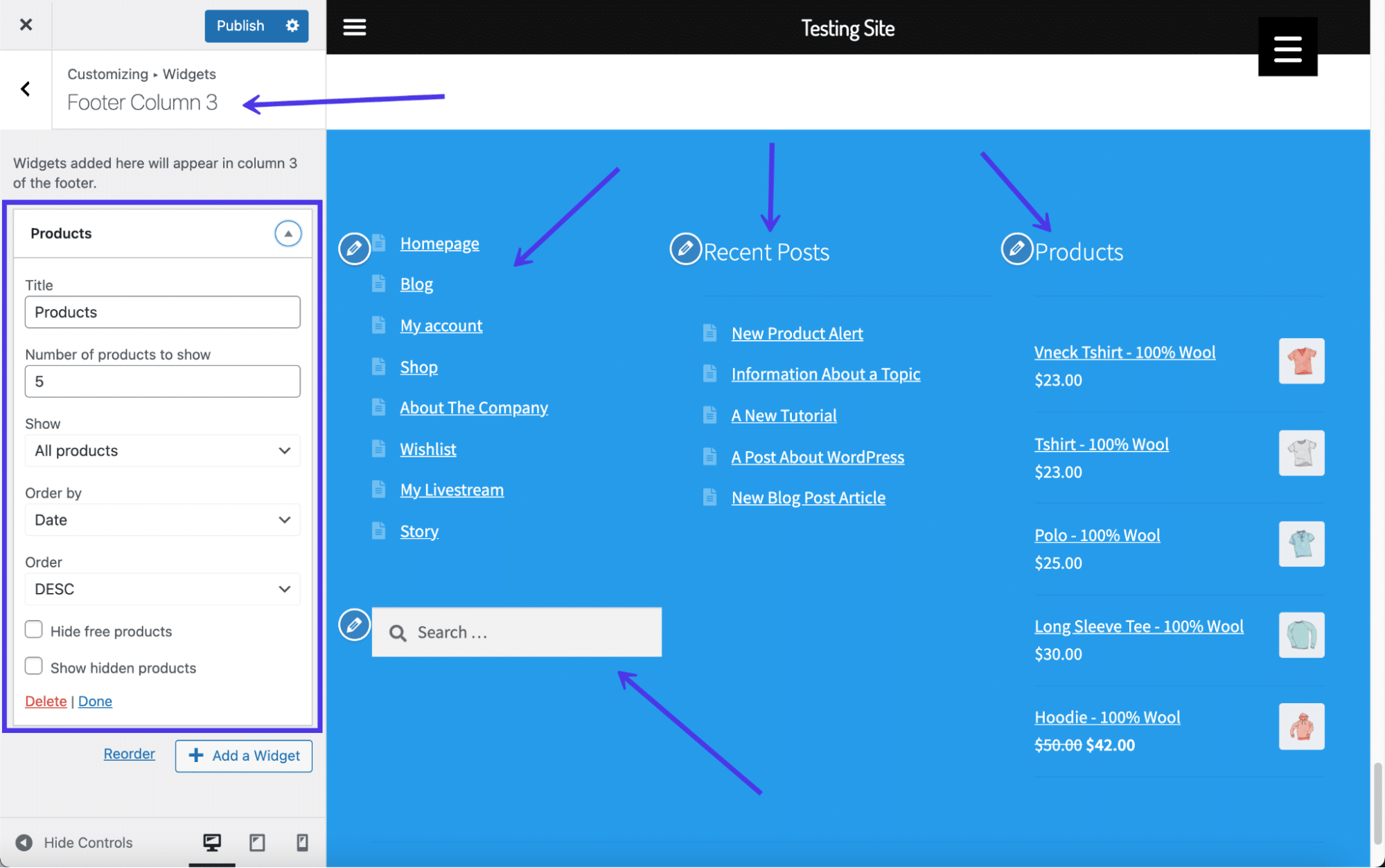
As you may learn while browsing through the theme settings, not all themes take means to add menus directly to the footer area using the standard Add Menu setting. Our theme hither, for case, has spots to activate menus as primary, secondary, handheld, and mobile menus, but nothing for footers.
We'll embrace menus in the next section, but we wanted to explain a quick workaround to add a menu with a widget, just in instance your theme doesn't support menus in the usual manner.
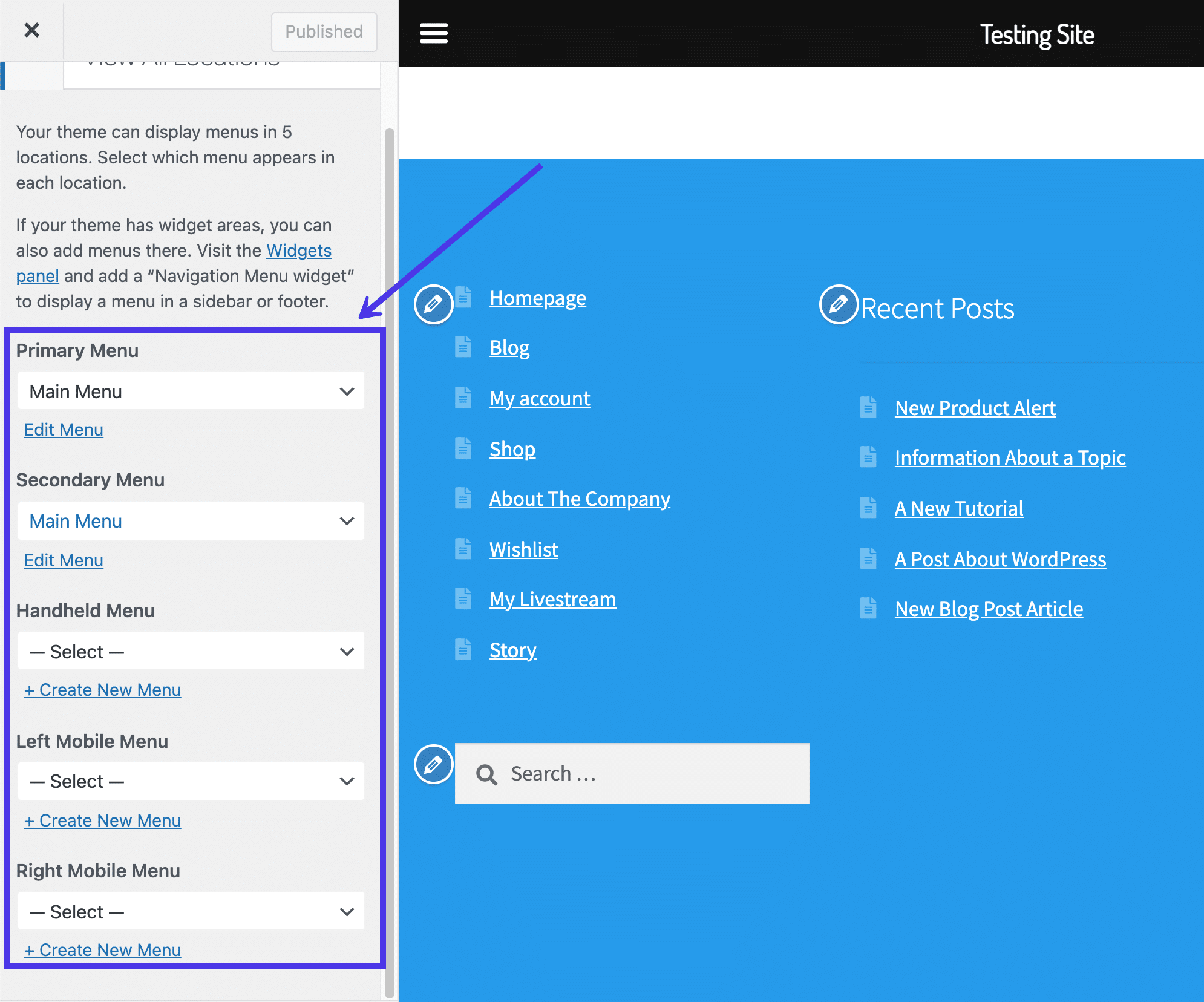
Substantially, all y'all have to practise is go to one of your widget footer modules and search for the Navigational Menu widget. Here, you tin click on a dropdown field to view all created menus on your website. Feel gratis to generate a menu specifically for your footer (in the Menus department of the dashboard) and add together information technology every bit a widget in this section.
As an alternative, opt for the principal menu, or whatever menus you've created. They should all show up in the carte du jour widget dropdown.
Later that, the carte du jour of your pick shows upward in the footer, equally long as you've added the Navigational Menu widget in the right footer area and clicked the Publish button. Yous tin can even type in a championship for that carte if y'all'd like to explain what the following links comprise.

How To Insert Custom Text, Images, and Code as Footer Widgets
Many WordPress widgets offer pre-configured lists of content, like the Recent Posts widget or the Search Bar.
However, sometimes you may want to edit the WordPress footer to include entirely custom content, such as simple text, images, or a bit of lawmaking, to create something completely new.
WordPress provides a widget for each of these.
All that's required is to go to the Theme Customizer > Widgets. Then, choose the widget area that reflects where y'all desire the widgets to become in the footer.
Click on the Add A Widget button and search for "image".
Add the Image widget and customize the title. Click on Add Paradigm, then consider including a link to the image likewise. You can edit the paradigm size past clicking on Edit Image.
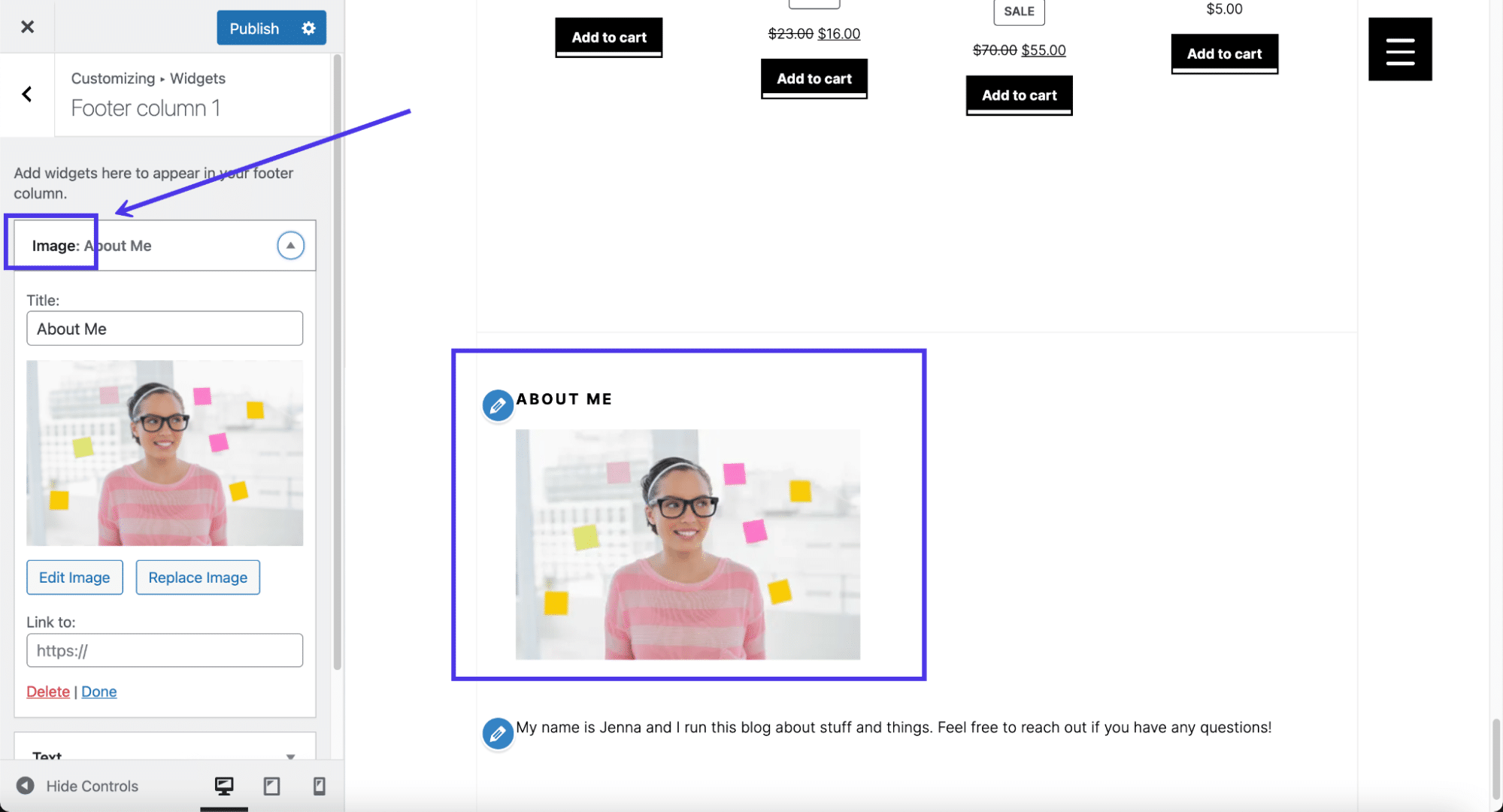
Next up, search for "text" in the widget library.
Add the Text widget to your footer and type in annihilation you lot want. It likewise has a title field along with a visual editor, much like you receive when making a blog post or page in WordPress. We've tried inserting images through the Text widget (since information technology's technically possible) but many themes don't let it.
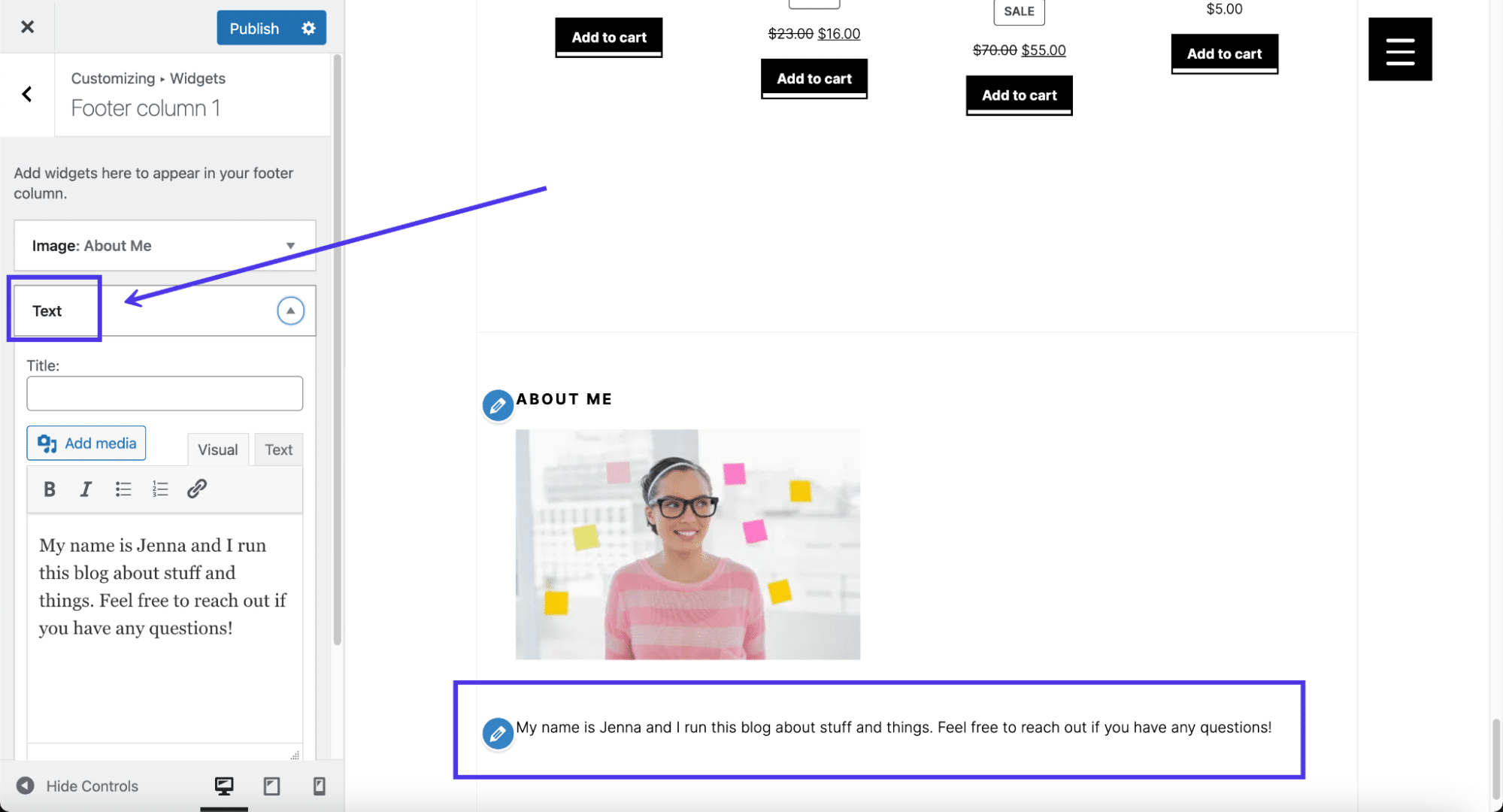
Finally, you may find that using a Custom HTML widget is the best grade of activity, particularly if you want full control over the footer blueprint or to contain a unique design for something like an e-mail signup form.
For that, search for "HTML" in the widget library and choose the Custom HTML widget.

Paste or type in your custom HTML and keep an eye on the right-side preview to ensure information technology looks the way it's supposed to. You lot may also have to add together some CSS styling to make it announced the fashion you want.

As always, remember to click the Publish button at the end.
Adding Menus to the WordPress Footer
You brand menus in WordPress by going to Advent > Menus. In one case you've established a menu, information technology's fix to add, at least the locations supported by your called theme.
It's likewise possible to create your menu inside the WordPress Customizer, and then it simply depends on where you lot feel almost comfortable adding new pages and links to your menus.
Every bit a reminder, non all WordPress themes allow for menus within the footer. In fact, some of them simply have one or two carte du jour locations, so yous'll take to check to run into if your theme supports menus. If not, refer dorsum to the previous department for a workaround that uses a widget to incorporate a menu in the footer.
If using a theme that allows for menus in the footer, go to the WordPress Customizer and click on the Menus tab.
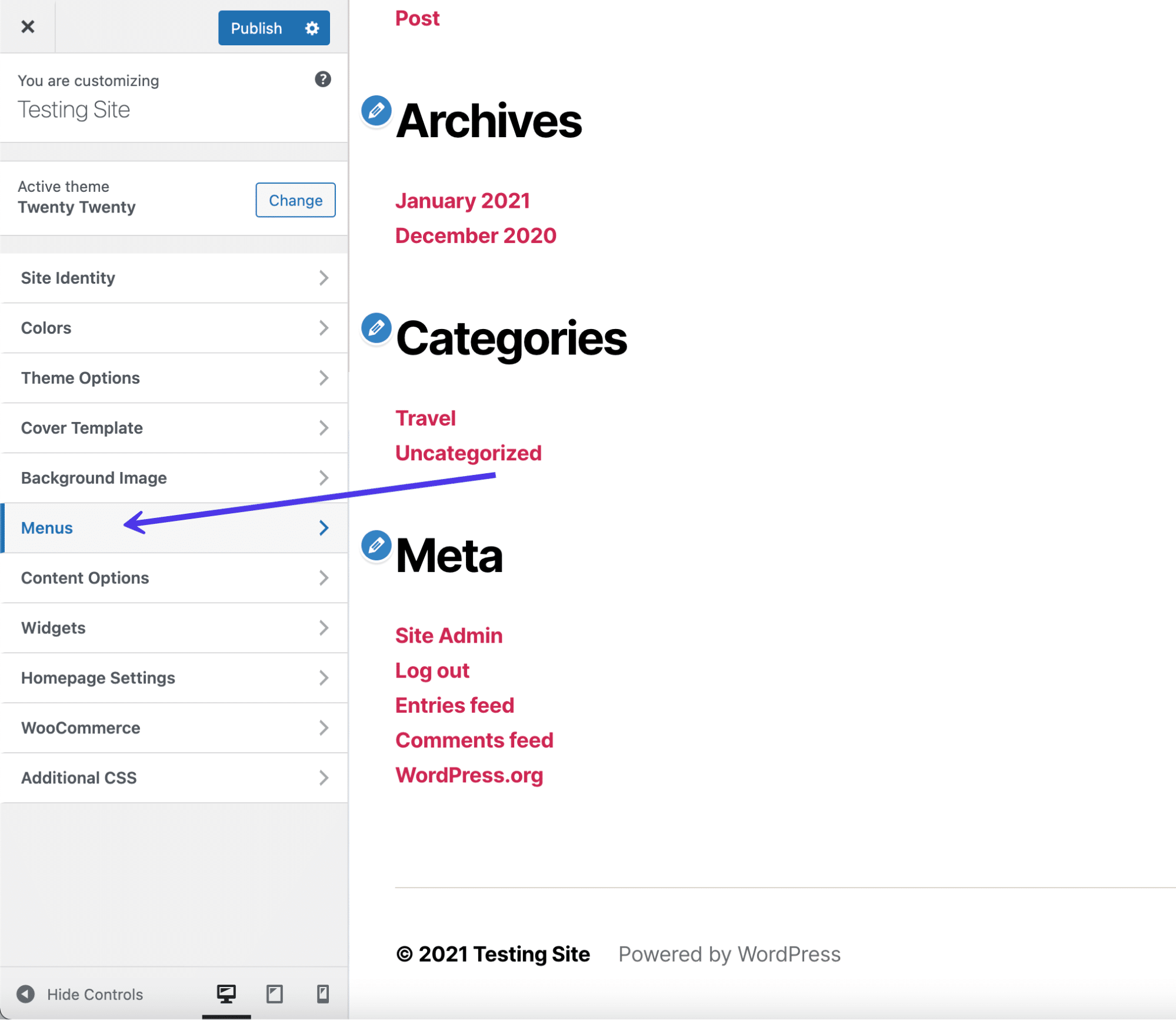
You'll most likely come across an empty menu page with several buttons to determine on. 1 of the buttons lets you select which menus to reveal and where to show them. The View All Locations tab shares where menus are supported on your theme.
Finally, the Create New Carte du jour button works much like the standard menu creation panel in the dashboard, except it doesn't require you to leave out of the Customizer.
Click on the Create New Bill of fare button. If you already have a menu ready to go, you can add together it to the footer by going to View All Locations.
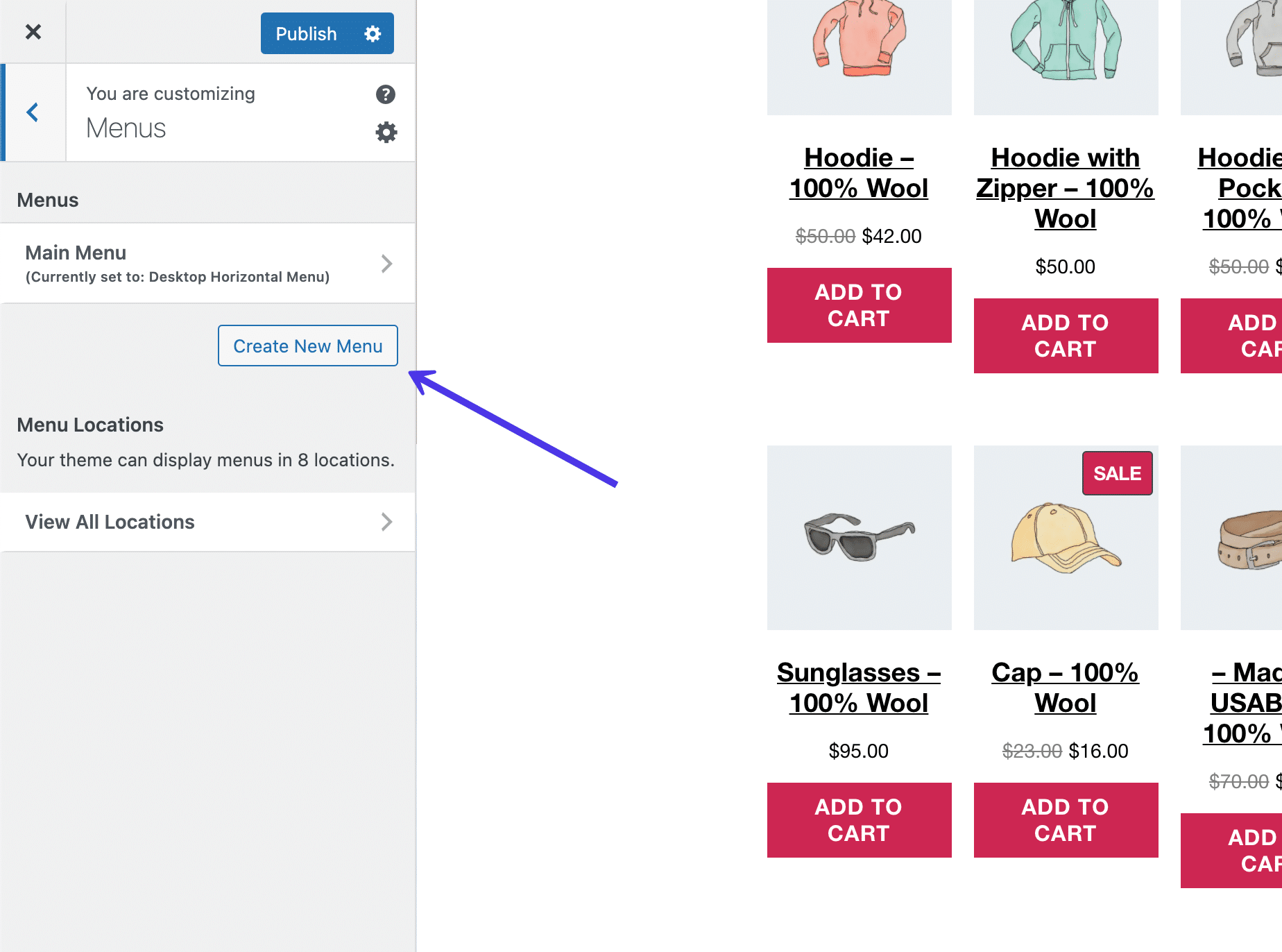
Proper noun your menu (in this instance we'll go with the obvious Footer proper name) and check the box called Footer Card. This tells WordPress you want the Footer menu you lot create to show upward in the Footer location. They're divide things; 1 is the actual card and the other is the region of your website where the menu goes. You're more than welcome to switch the proper name of your footer menu if yous find information technology a bit disruptive.
Click on the Adjacent push at the bottom of the panel to proceed.
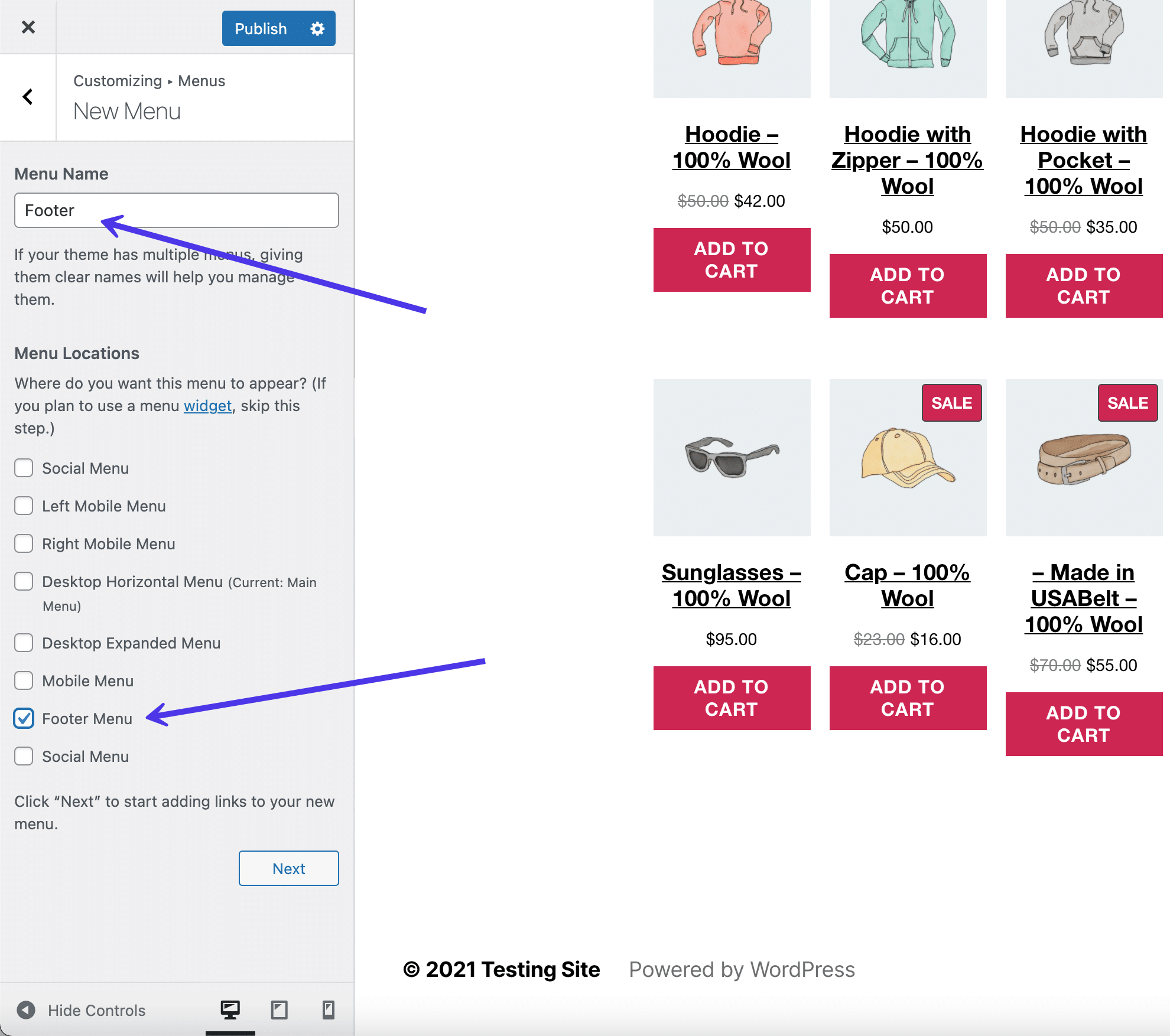
Now you lot have a carte du jour named Footer, but it lacks whatsoever buttons or links to make it a truly functional menu.
Click the Add Items button to beginning placing links and buttons to pages in your menu.
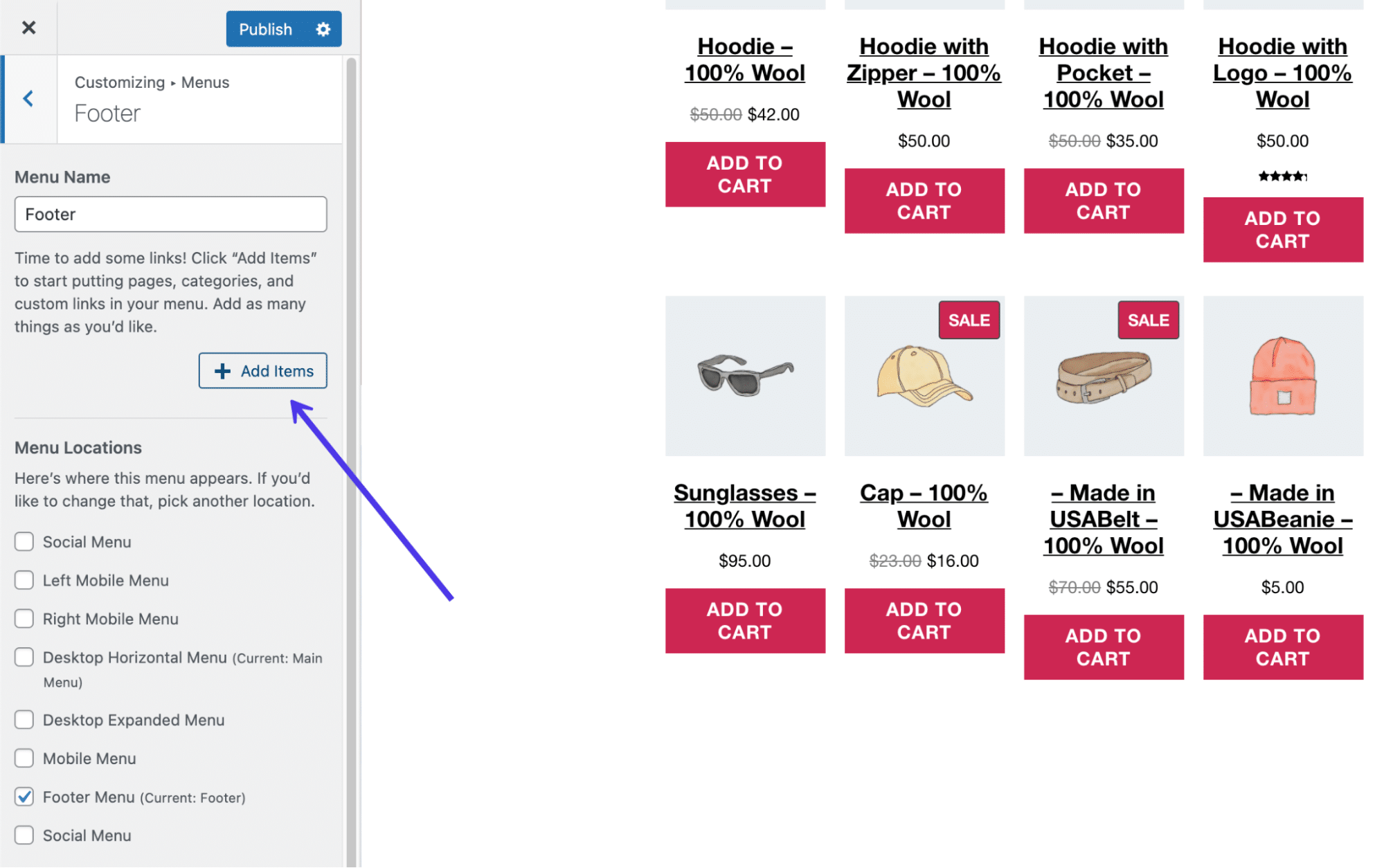
A new slideout panel appears with all the options to add together to your carte du jour. For example, you tin include custom links to internal or external pages, posts from your blog, pages from your ain site (already created pages), products, tags, and categories, along with any other types of content pages you may take.
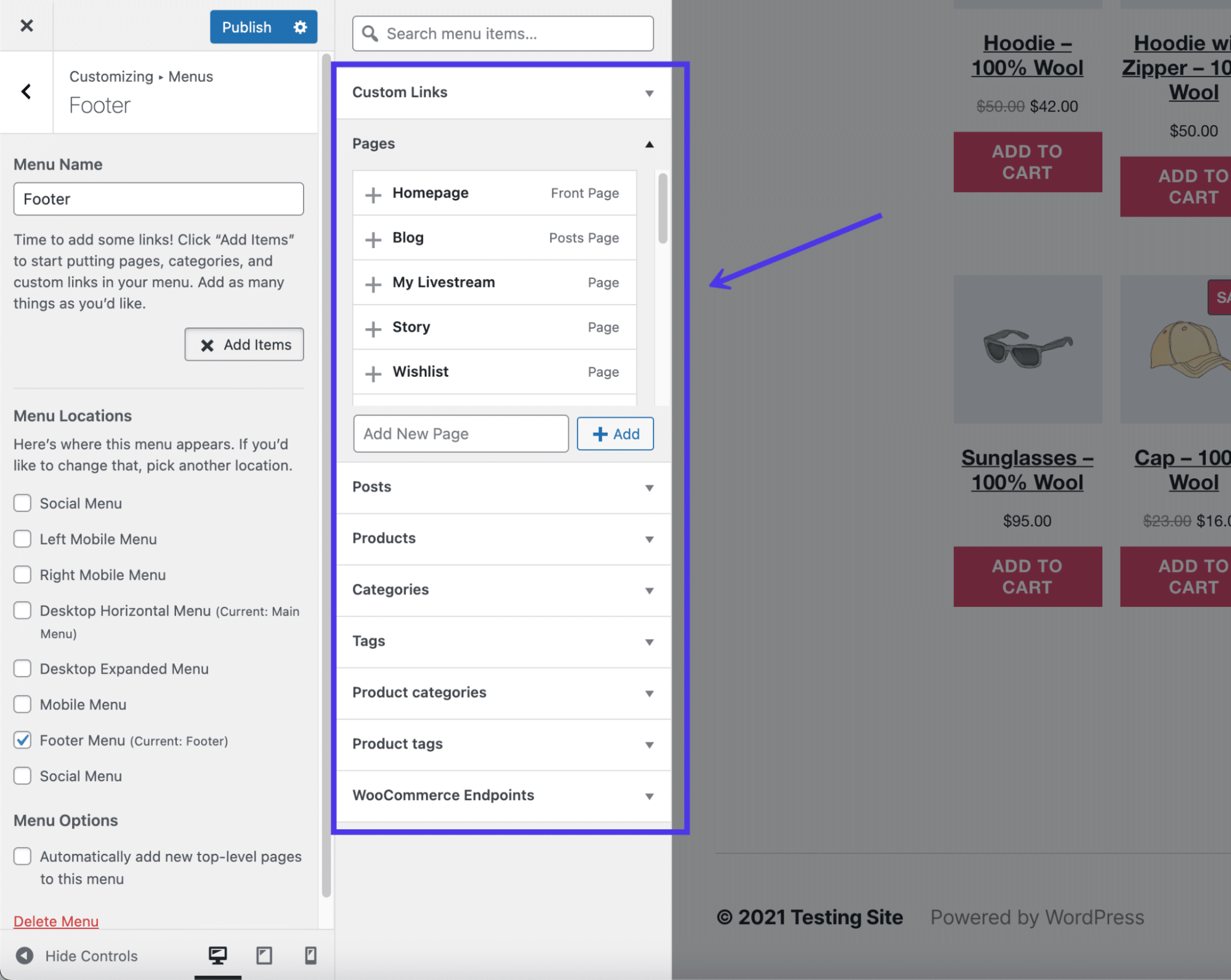
Each bill of fare item you cull gets placed and shown in the menu panel, where you're able to reorganize them and click on each one to edit their individual settings. For this example, we've added five links to pages throughout our website, including the blog, a livestream page, and an Nearly The Company folio.
Refer dorsum to our list at the beginning of this article for ideas on what to include in your footer.
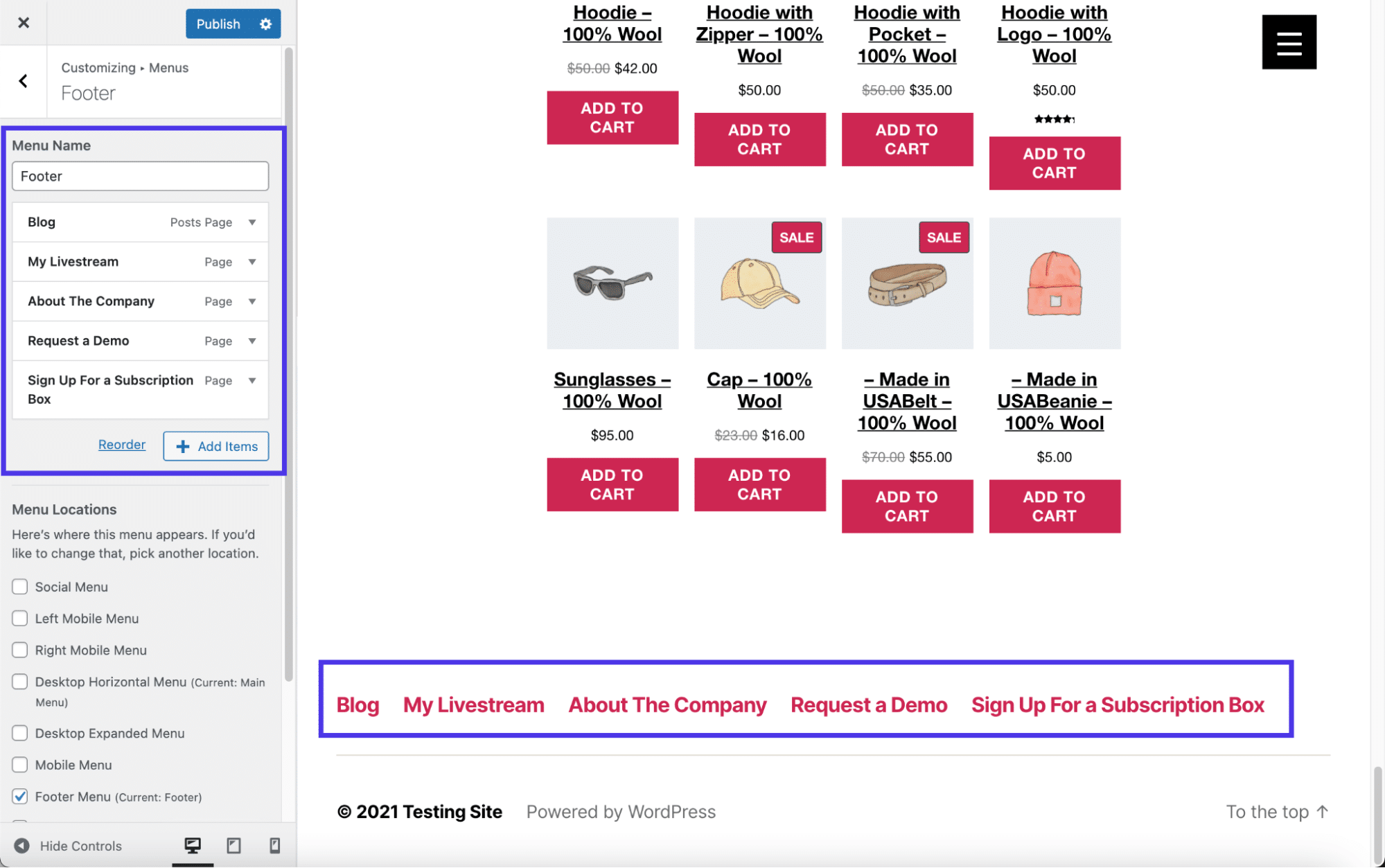
Edit Footer in WordPress With Plugins
WordPress already has born tools to modify your footer, but the extent to which you tin edit your particular site's footer relies on your theme of choice and whether or not you want to mess with any lawmaking.
Equally y'all'll learn further down in this article, removing the default "Powered By" text requires yous to tap into the footer.php file and remove some code. Therefore, it'southward clear several aspects of footer editing may be out of your reach if you don't accept the experience or willingness to mess with code or find a new theme.
That's where WordPress plugins come into play. Quite a few plugins offer footer editing and expansion features to remove the need to edit code manually and sometimes to brand quick changes to your footer, like with colors and columns.
WordPress footer plugins we recommend include the following:
- Footer Mega Grid Columns — This plugin fixes any issues you have with a theme where the footer lacks a grid format with three columns. Some themes only offer ane or two columns, while other times a footer gets entirely stripped from the theme. Footer Mega Grid Columns adds a footer widget to not only brandish three columns just boosted ones if needed.
- Remove Footer Credit — Utilize this plugin to completely remove the footer credit placed there by WordPress or your theme developer. You lot as well have the selection to blazon in your own HTML code to create a footer credit or a bit of content that's more than suitable for your site.
- Header Footer Lawmaking Manager — This plugin has a slight learning curve, merely it's an ideal solution for intermediate WordPress users who would rather have access to footer and header coding areas in the dashboard, as opposed to opening up the site files. You can add an unlimited number of styles and scripts to the footer, which often comes in handy for showing data later every blog post or page.
- Footer Doodle — Employ this plugin to insert a widget for copyright information or for your trademarks. This is a rather useful solution for placing details about your company in the footer area, including things like links, business organisation hours, phone numbers, and more.
- Footer Text — Every bit one of the simplest ways to modify your WordPress footer, the Footer Text plugin activates a frontend and backend editing console to change what'southward in your footer. It comes with a WYSIWYG (What You See Is What Y'all Get) editor, so it'south possible to format your text and potentially add items like pictures.
In the following sections, nosotros'll explore how to utilise some of these plugins for tasks like calculation social media buttons or inserting custom code into the WordPress footer.
Manually Edit the WordPress Footer With Code
A more technical style of editing your WordPress footer involves tapping into the footer.php file and editing its contents.
Y'all must have experience with coding — or be eager to acquire — in lodge to brand this method useful for you, simply in that location are some minor tweaks that all beginners tin can handle (mainly just removing preset text in the footer). Accept a look at our guide to adding header and footer code for the most detailed data.
To access the footer.php file, link to your WordPress site files by using an FTP customer. We too recommend checking out this commodity on how to use SFTP to link to WordPress as SFTP is more secure than FTP.
In one case connected to your WordPress site files through your FTP client, locate the /public folder. Click on /wp-content and then /themes to reveal all themes currently installed on your WordPress dashboard. Note which theme is active on the site and open the folder for that one.
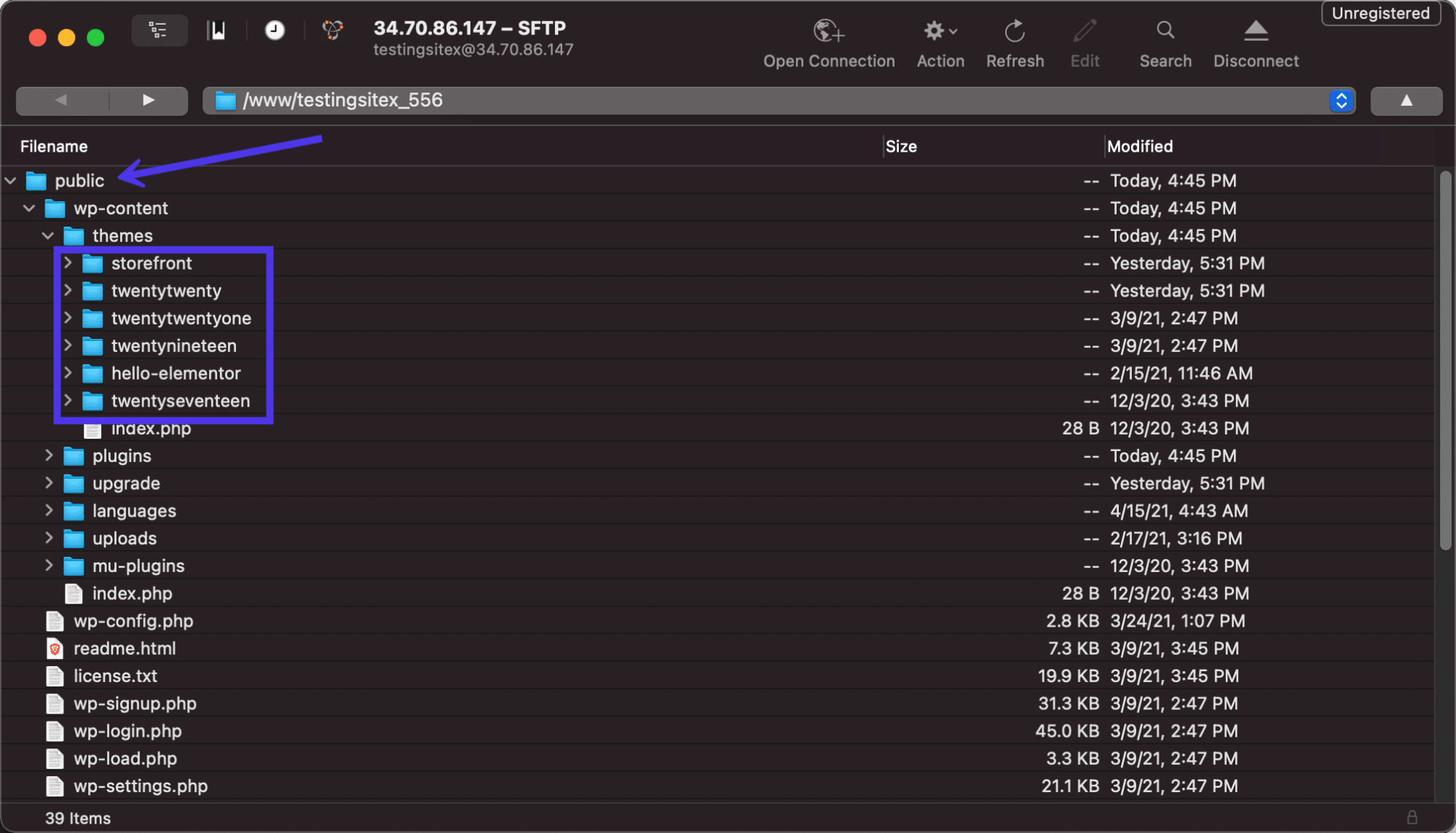
All WordPress themes have a footer.php file somewhere in the theme folder. Scroll through the batch of files to locate that footer.php file.
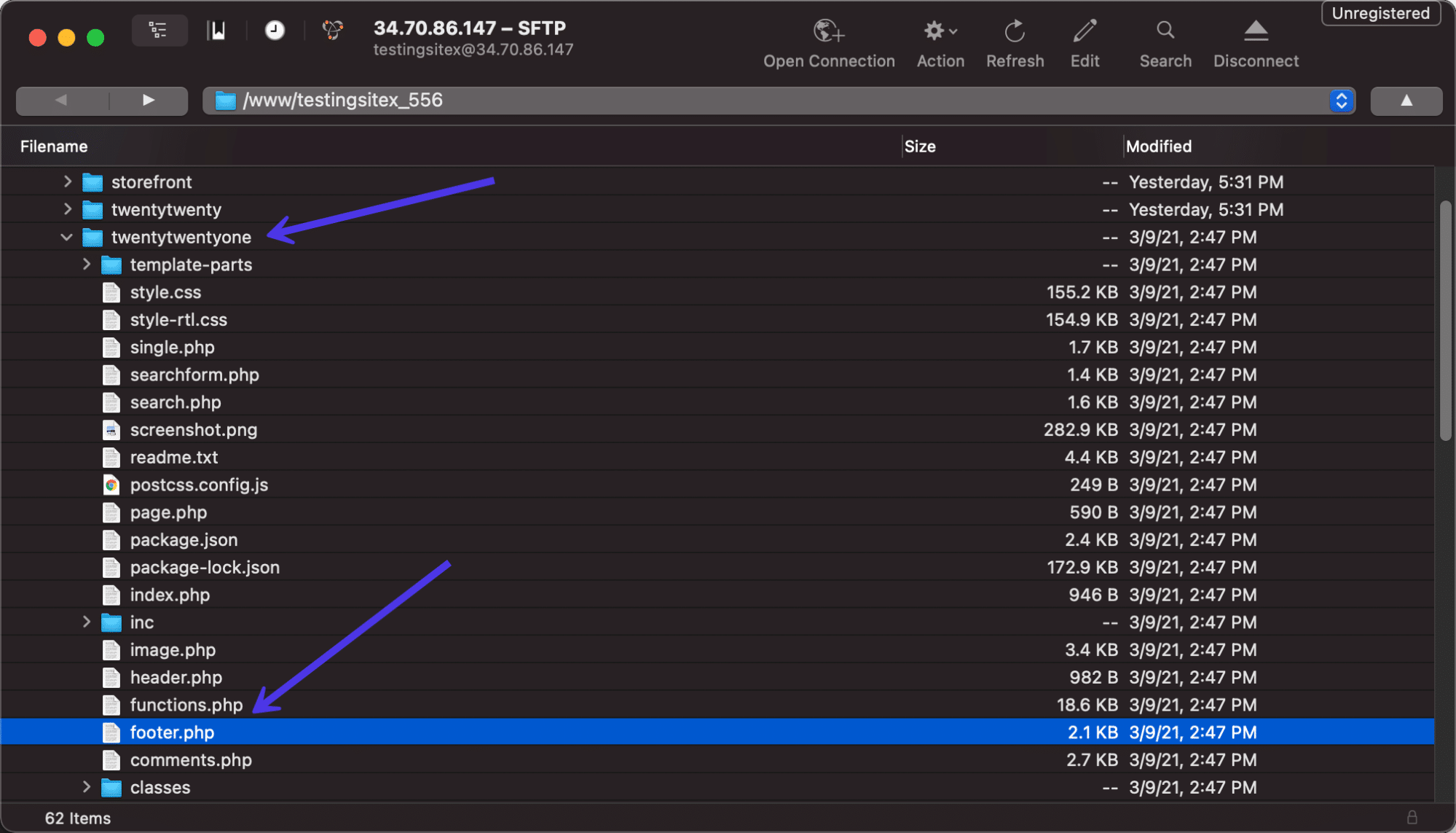
Open the file with the editor of your choice. Once in in that location, you tin can edit the current code or add together new content depending on what yous're trying to achieve. The get_template_part department is frequently modified to insert new bits of text, only we'll exit that up to yous since every footer is different.
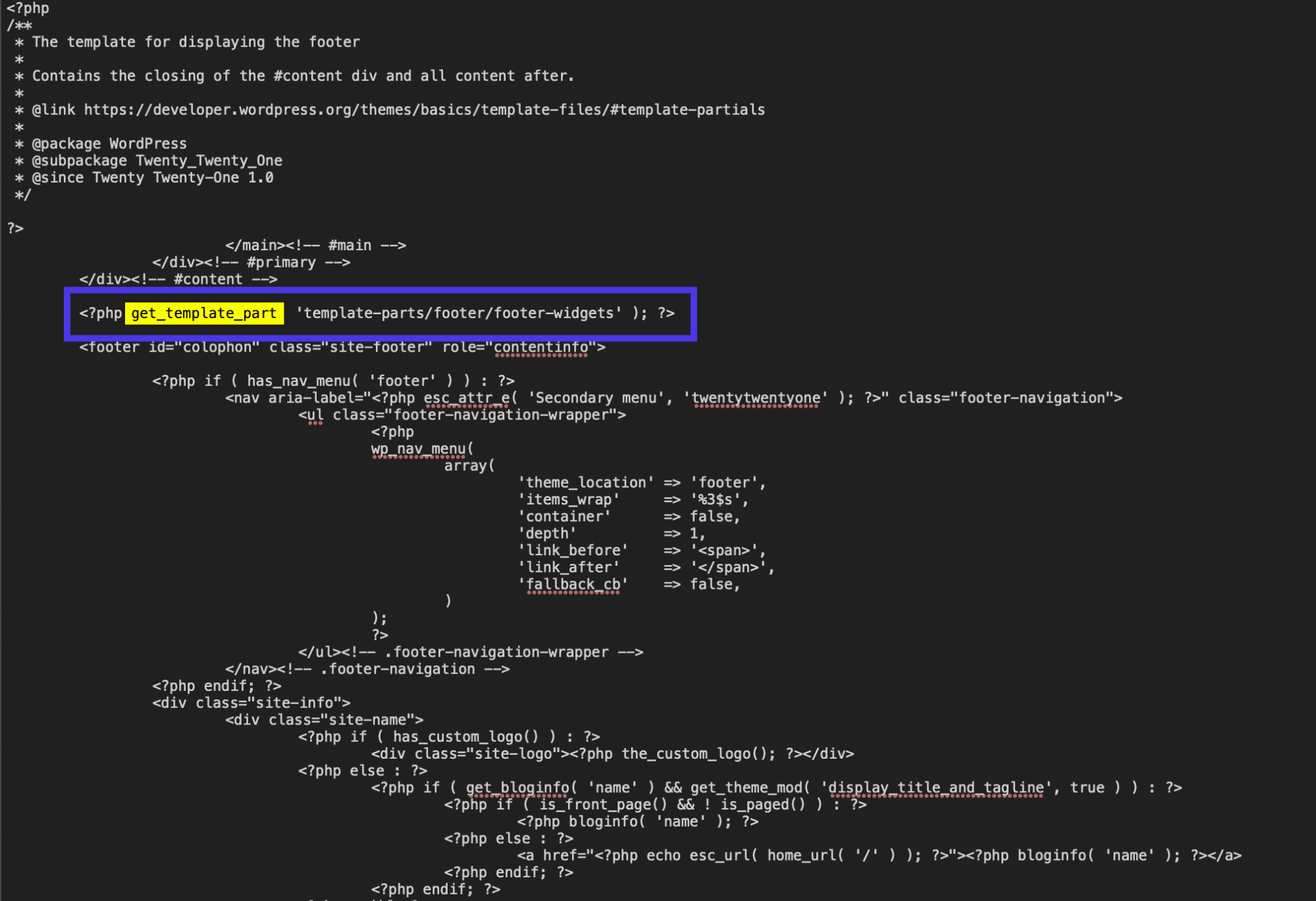
As an alternative, you tin can edit the footer code by using a plugin that displays a visual field for the footer.php file. This way, you don't accept to install an FTP client and link it to your website. It's too a more intuitive, beginner-friendly procedure that remains available on your dashboard at all times for future edits.
To make this happen, install and activate the Header Footer Code Manager plugin.

Once it's been installed, click on the HFCM tab that appears in the WordPress dashboard. Then, name the snippet, choose where you lot want it displayed and set the location as Footer.
The most important part is the Snippet/Code field, which you'll fill in with whatever code y'all want. Some people use this plugin for things like verification or tracking codes that don't show up on the front end. Notwithstanding, it's also available for yous to use for typing in new text and gaining almost complete control over the content in your footer.
Make certain y'all click on the Salvage button to see the results.
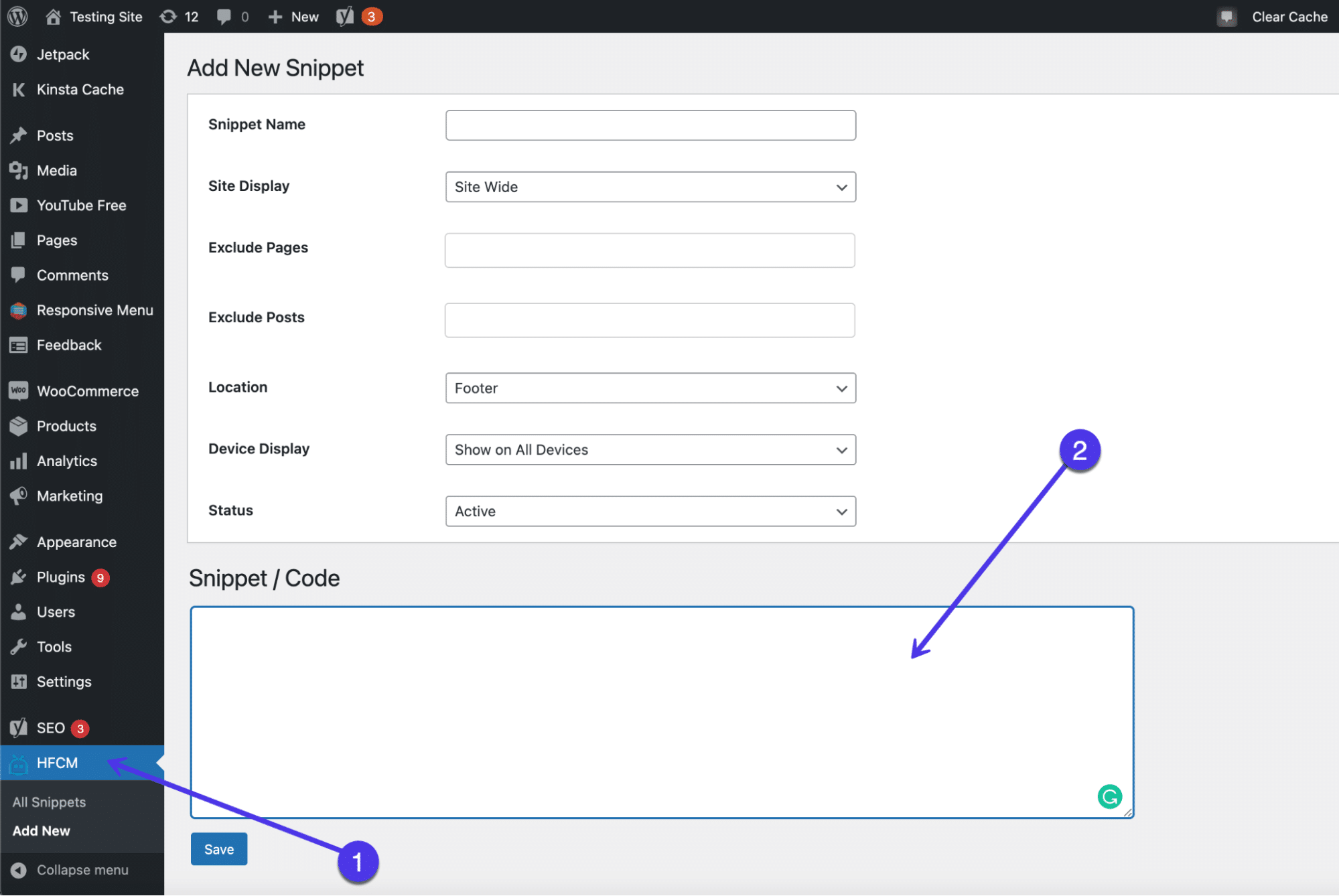
Use a Page Builder With Footer Designer
A bonus mode to alter your WordPress footer, without the need for code or many of the standard WordPress footer tools, is with a page builder. Not all page builders offering footer editors, so it's of import to bear some research and ensure that either your current page architect offers it or the one you lot plan on buying has footer features.
Regardless, this is a relatively basic feature for a folio builder, so it's a adept idea to only go for a page builder if you plan on customizing your entire site with it.
A few other page builders offer footer editing, simply our favorites include Elementor and Visual Composer.
To create a custom footer with Visual Composer, y'all must have the Pro version. In that location are some workarounds to edit the lower role of your website with the costless version, but the truthful drag-and-driblet builder for the footer requires an upgrade.
In one case installed, click on the Pages push in your dashboard. Scroll through the pages you want to edit and select the Edit With Visual Composer link on any of those pages.
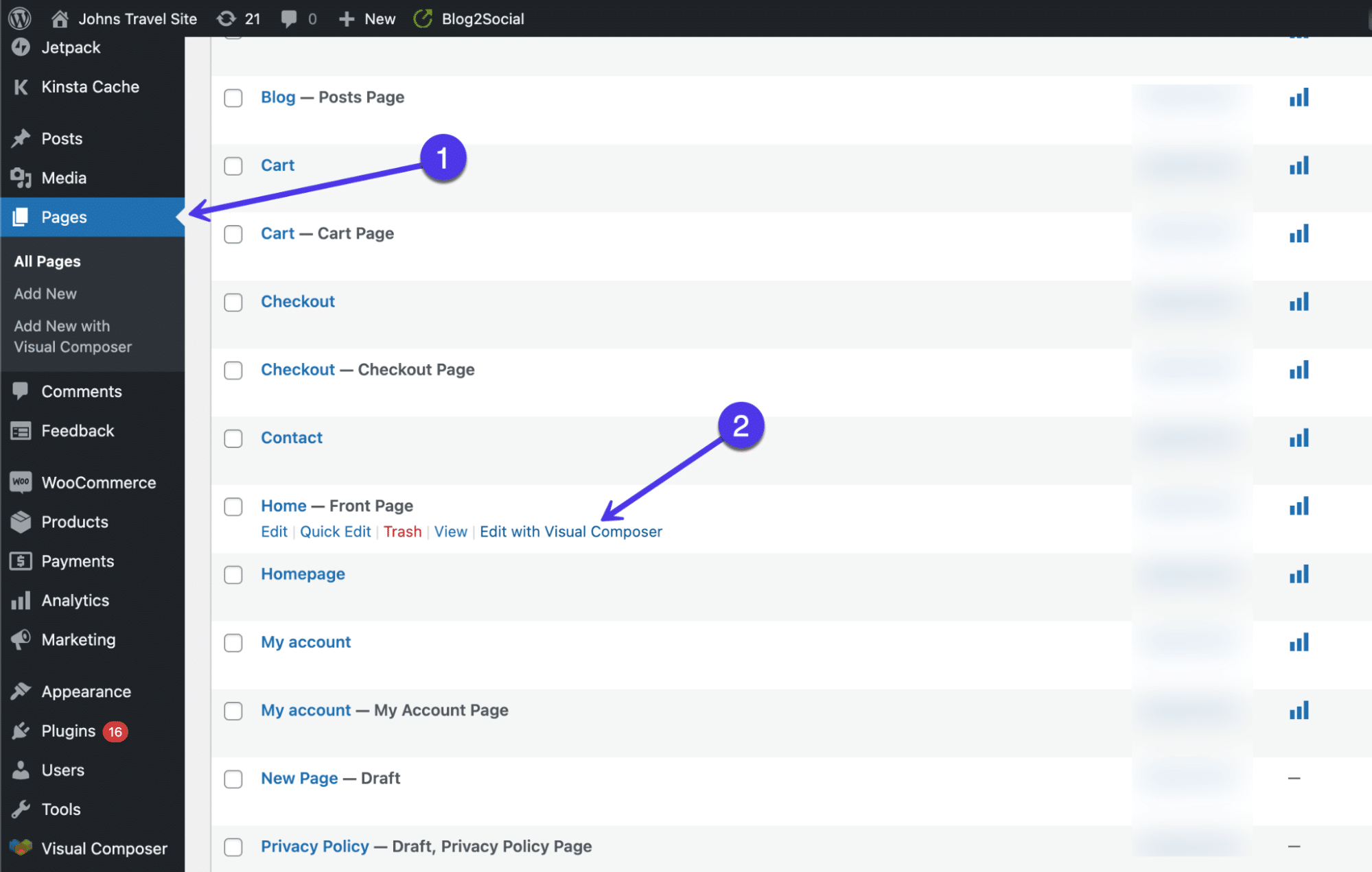
That brings up the Visual Composer designer, with a live preview of your webpage on the right side and drag-and-drop design tools like elements and templates on the left.
One of the easiest ways to implement a beautiful footer is to only choose a template (many of which are free). These templates provide professional person designs for your unabridged site, along with a nice footer that's customizable.
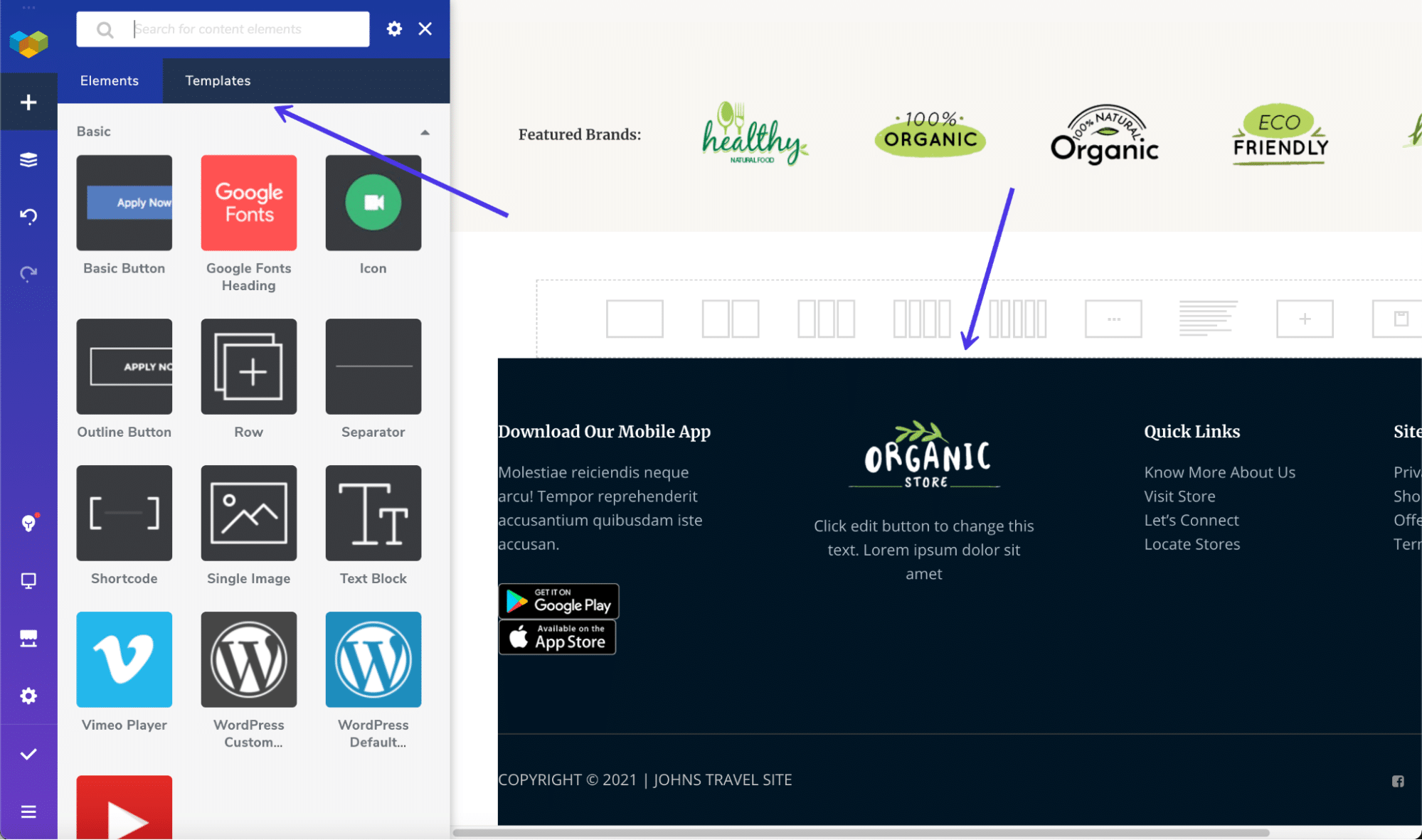
To see what's available, you lot can click on the Templates tab, then the Go More Templates button. Visual Composer offers templates for all aspects of your site, including headers, footers, and sidebars.
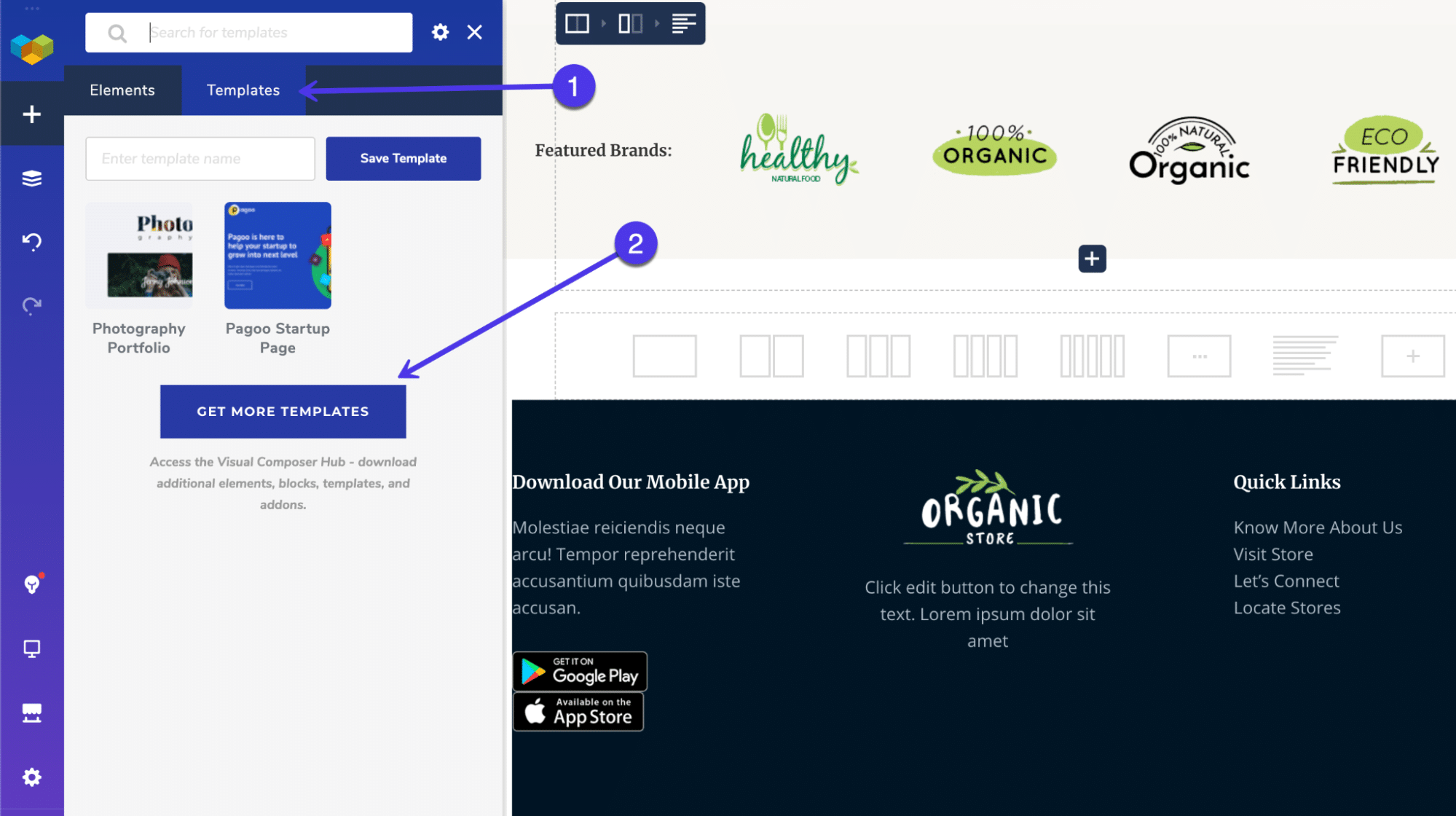
The next window shows a big library of templates, all categorized under filters for things like Elements, Templates, Blocks, and Footers.
Choose the Footers tab to show all premade footer templates.
One time again, this part of Visual Composer requires the Pro version. Once active, yous tin curl through the dozens of footer templates to implement them on your website and edit them as you please.
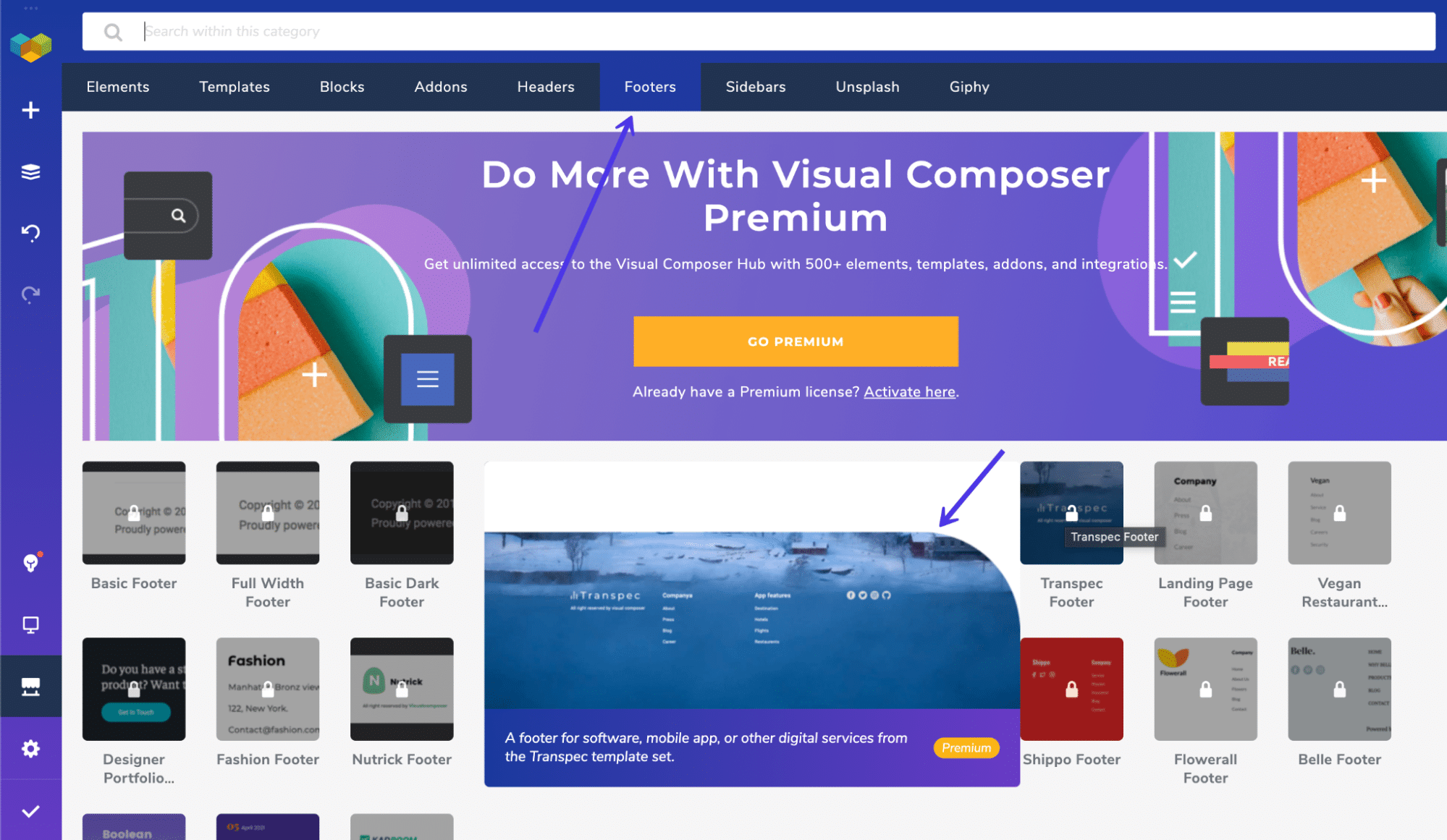
One of the other page builders with footer editing tools is chosen Elementor. Much similar Visual Composer, Elementor provides a full website builder for constructing homepages, production pages, footers, and more.
Continue in listen that yous exercise receive footer content blocks for gratis with this method, simply the actual footer builder uses the Pro version of Elementor. Like Visual Composer, you need to upgrade for total functionality.
To get started, install and activate both Elementor and the Elementor Header Footer and Blocks Template plugins.
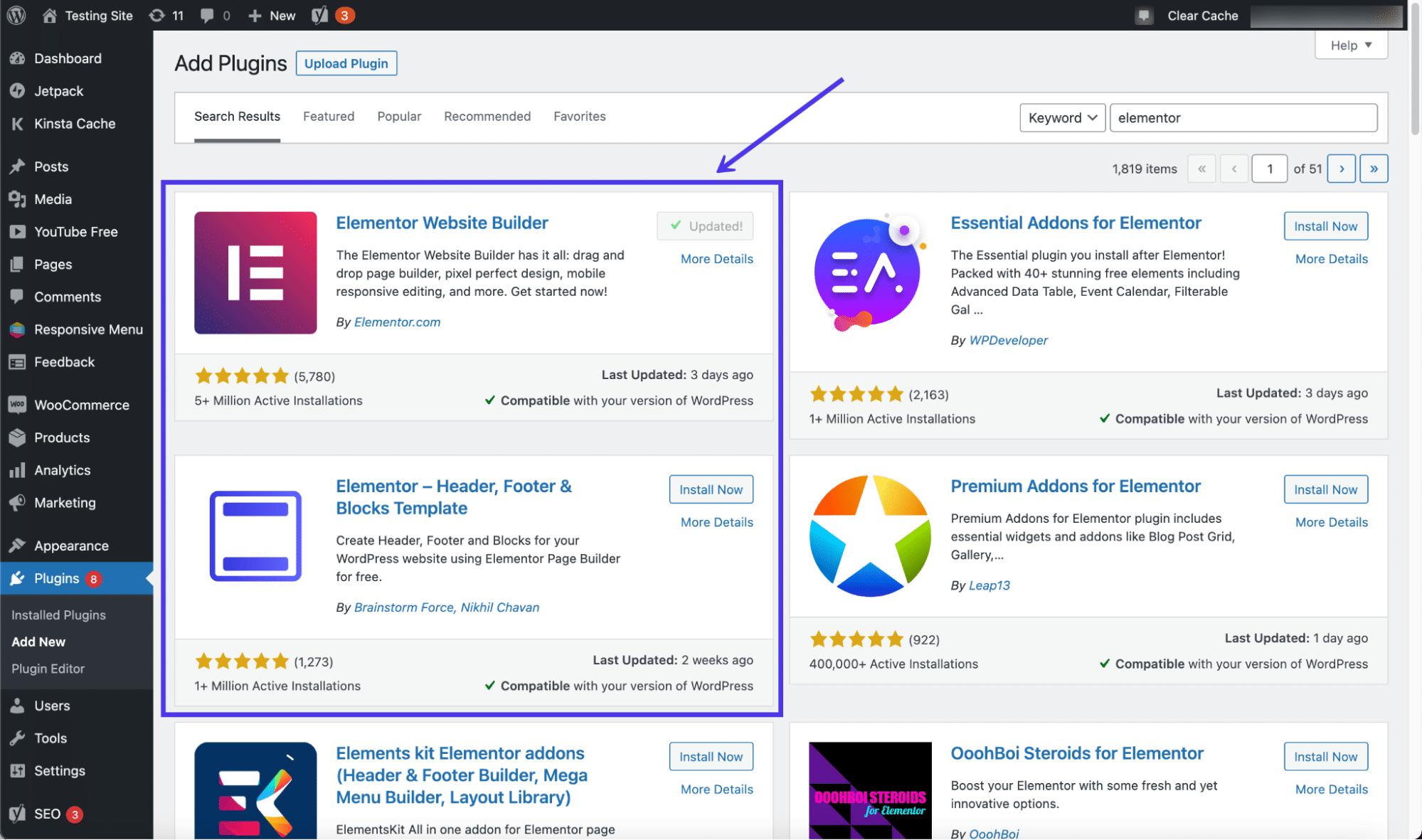
Click on Templates > Theme Builder to open the complete website builder from Elementor.
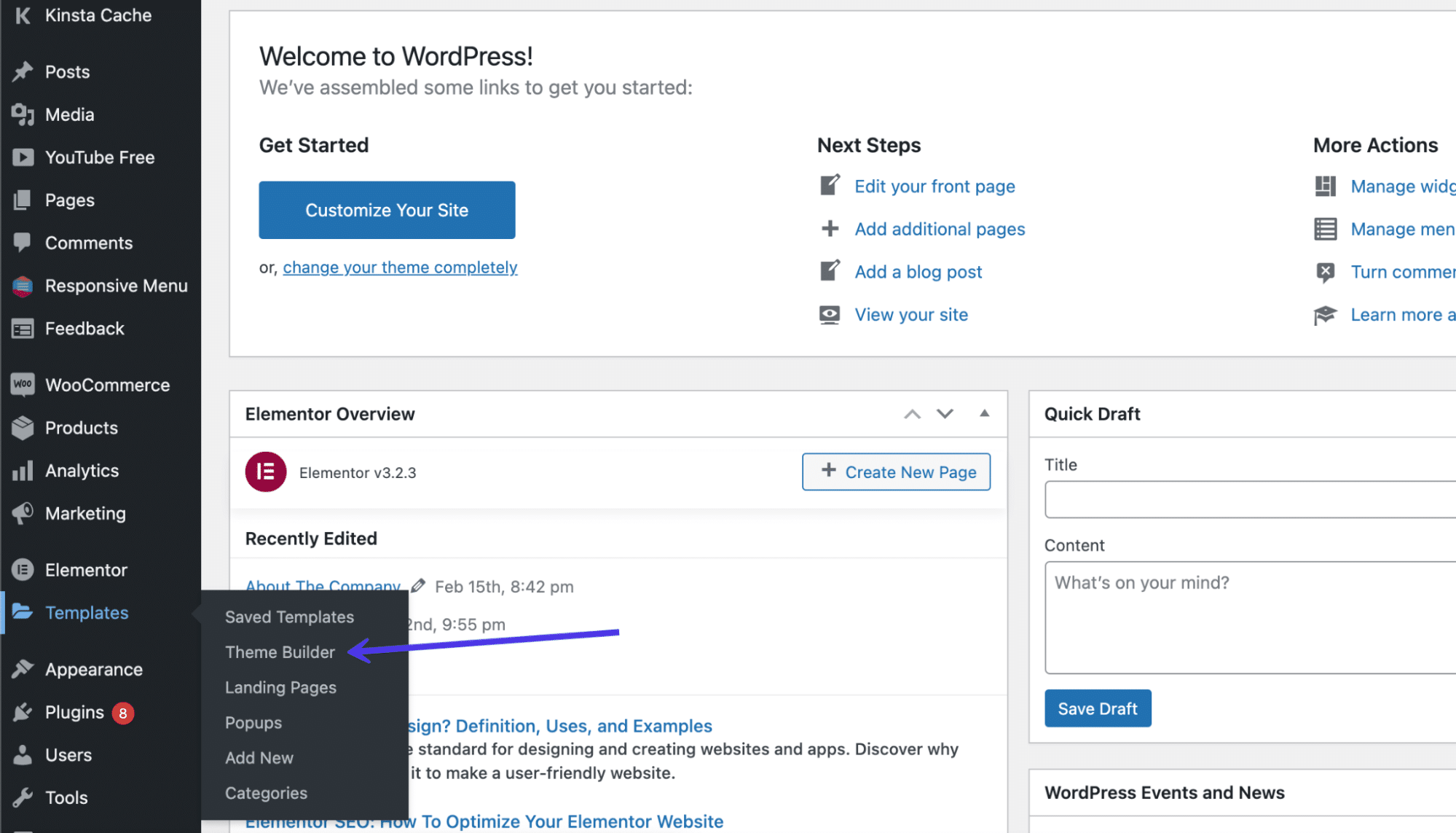
Here, you lot'll meet a menu to edit diverse parts of your site such as the header, footer, and single pages.
Select the parts of your site you want to customize on the left side bill of fare or with the icon buttons in the center of the page. As you lot can see, there's a Footer link in two places.
Subscribe At present
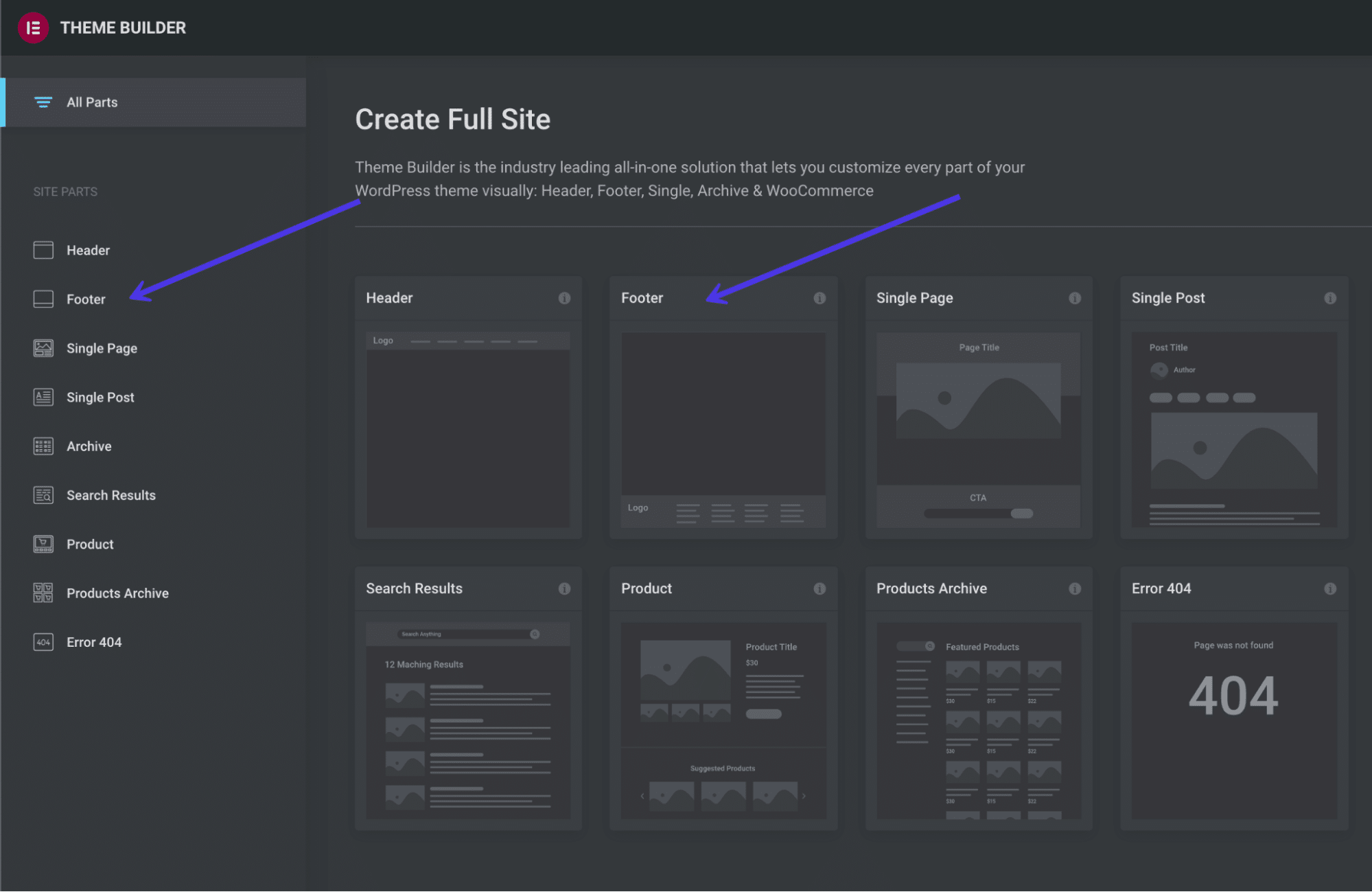
The footer editor works similarly to every other editor in Elementor: You can change the layout, adjust the mode, and click on the block to blazon in new content. Every aspect of the footer is customizable when using Elementor, making it ane of the more flexible and desirable options when it comes to footer command and learning how to edit a footer in WordPress.
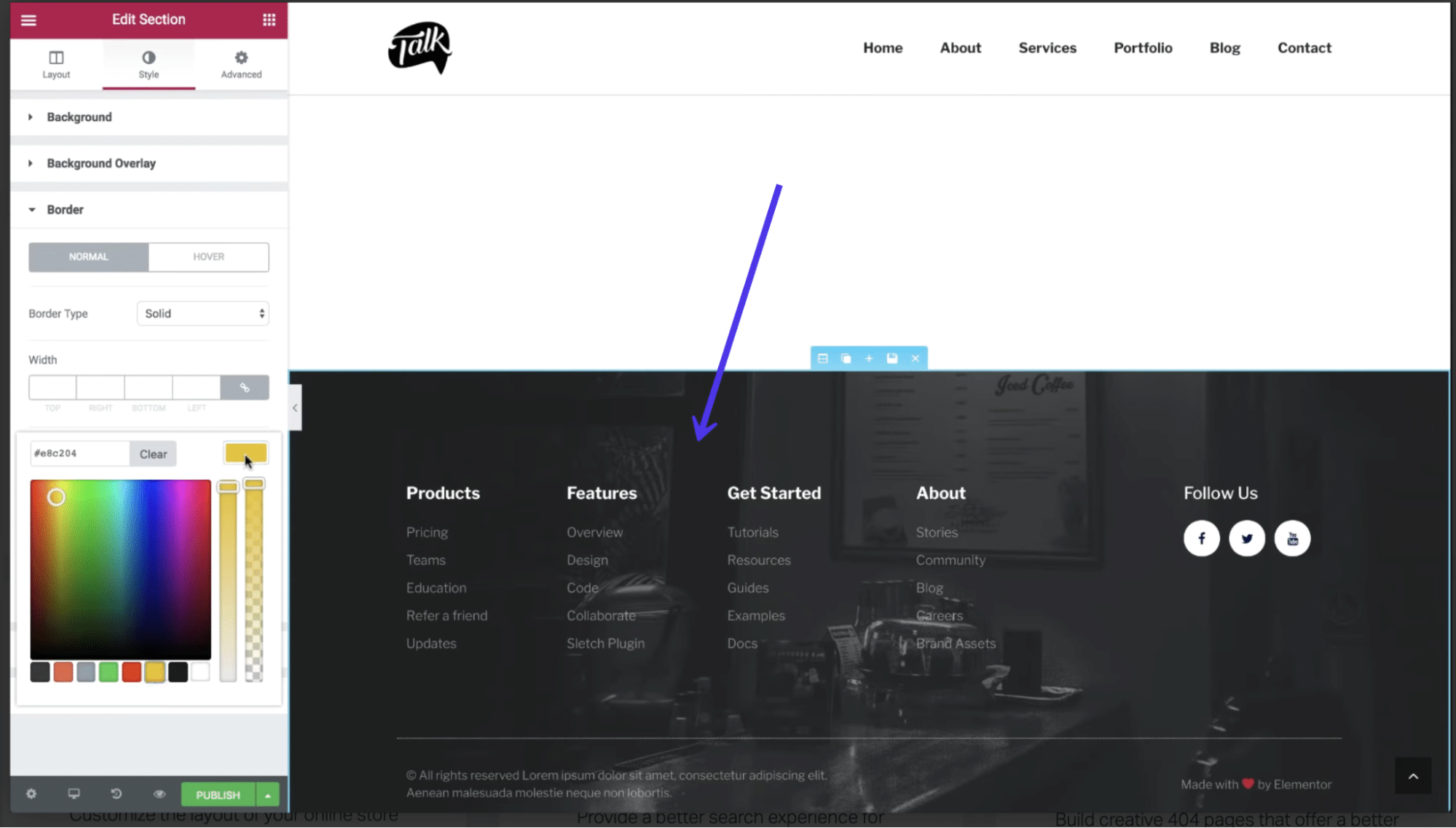
The Header Footer and Blocks plugin provides content modules made specifically for headers and footers. In terms of the footer blocks, you can choose from modules like copyright data, images, site titles, and taglines.
To employ these blocks, get to Appearance > Header Footer and Blocks in the dashboard.
You tin also make a unique block and choose to edit information technology in the Elementor page architect. In one case in Elementor, ringlet downward to the block drove for Headers Footers and Blocks, then elevate any of these elements into your current pattern to actuate some of the more than mutual content items within a footer. Equally mentioned, y'all can observe everything from search bars to site logos and cart icons to copyright text in these blocks.
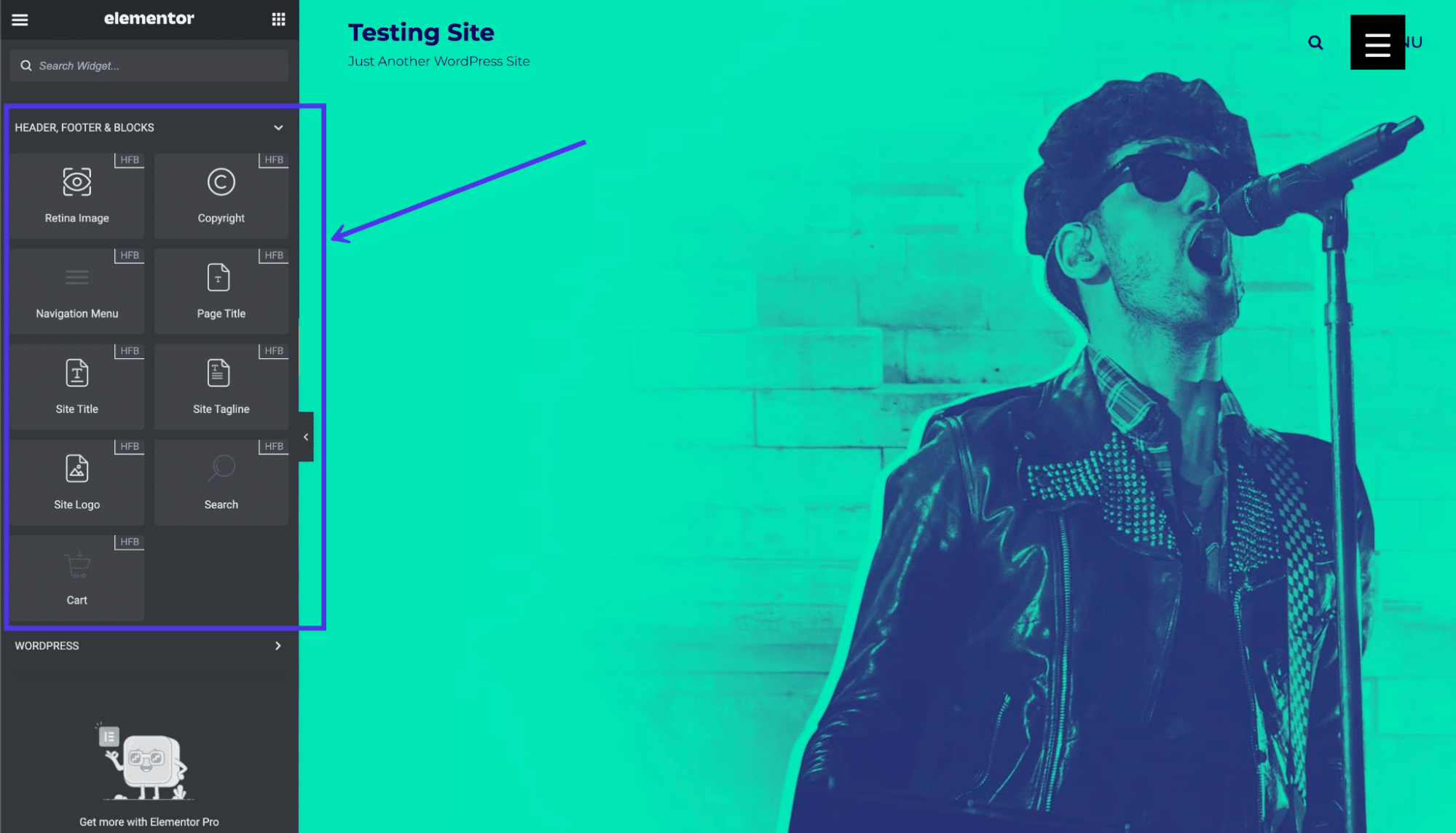
How To Edit a Footer in WordPress.com
WordPress.com, the hosted version of WordPress, includes footers for many of its themes, with options to remove or change the footers with a few clicks. The methods for editing footers in WordPress.com are somewhat similar to how information technology's washed in the self-hosted WordPress.org version, simply with a few differences.
First of all, the interface doesn't look exactly the same.
You must log in to your WordPress.com dashboard and manage your footer in the Theme Customizer. Luckily, many of the themes offered for WordPress.com are similar or exactly the same as what you'd observe for WordPress.org. However, that also means the mode in which you edit the footer in WordPress.com depends on which theme you install.
To begin, go to Appearance > Customize in the dashboard.
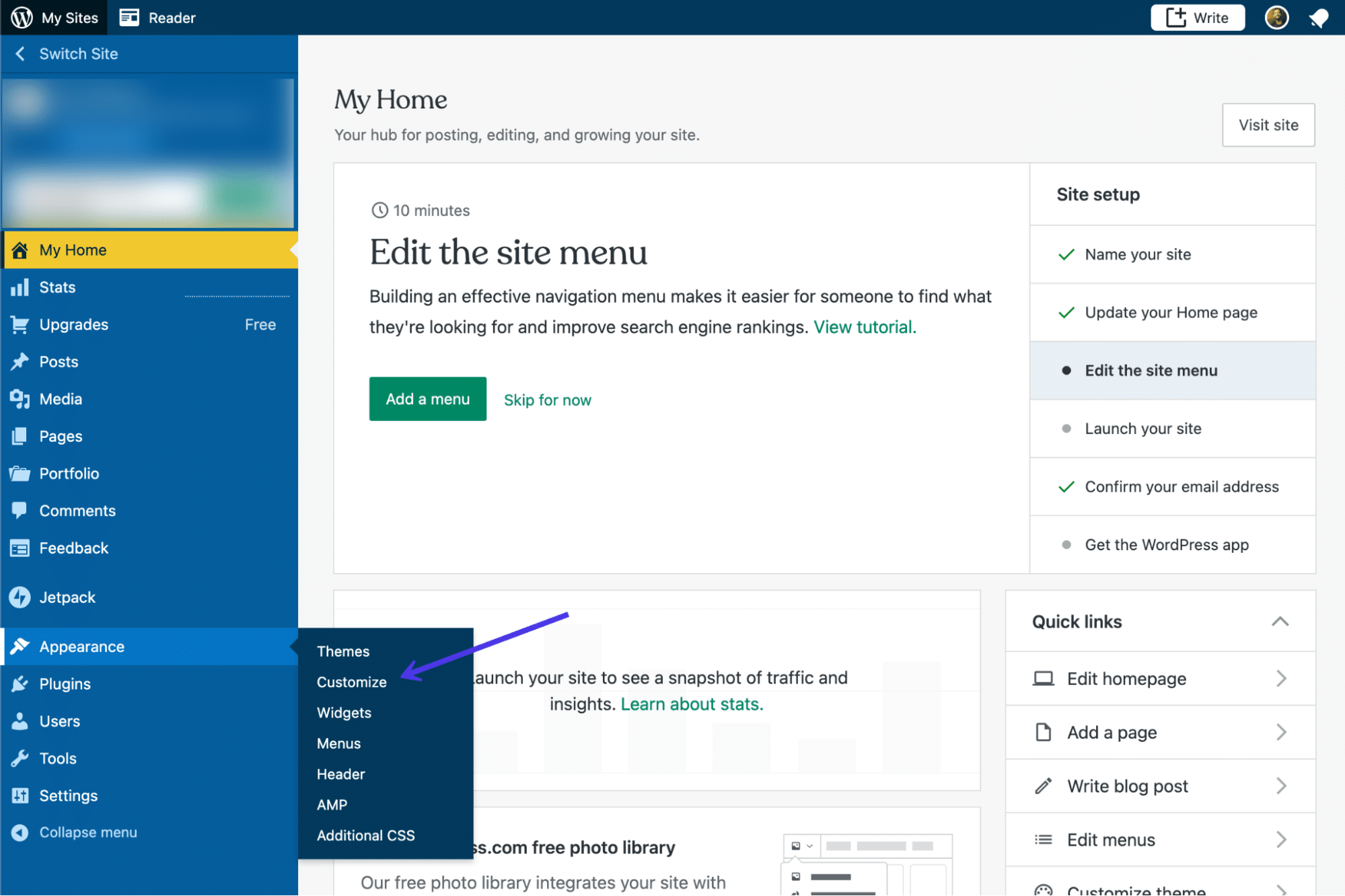
Look at the Theme Customizer tabs available for that particular theme. Most themes have a Widgets tab, but you must figure out if a footer expanse for placing widgets is provided with your theme. Click on the Widgets tabs to find out.
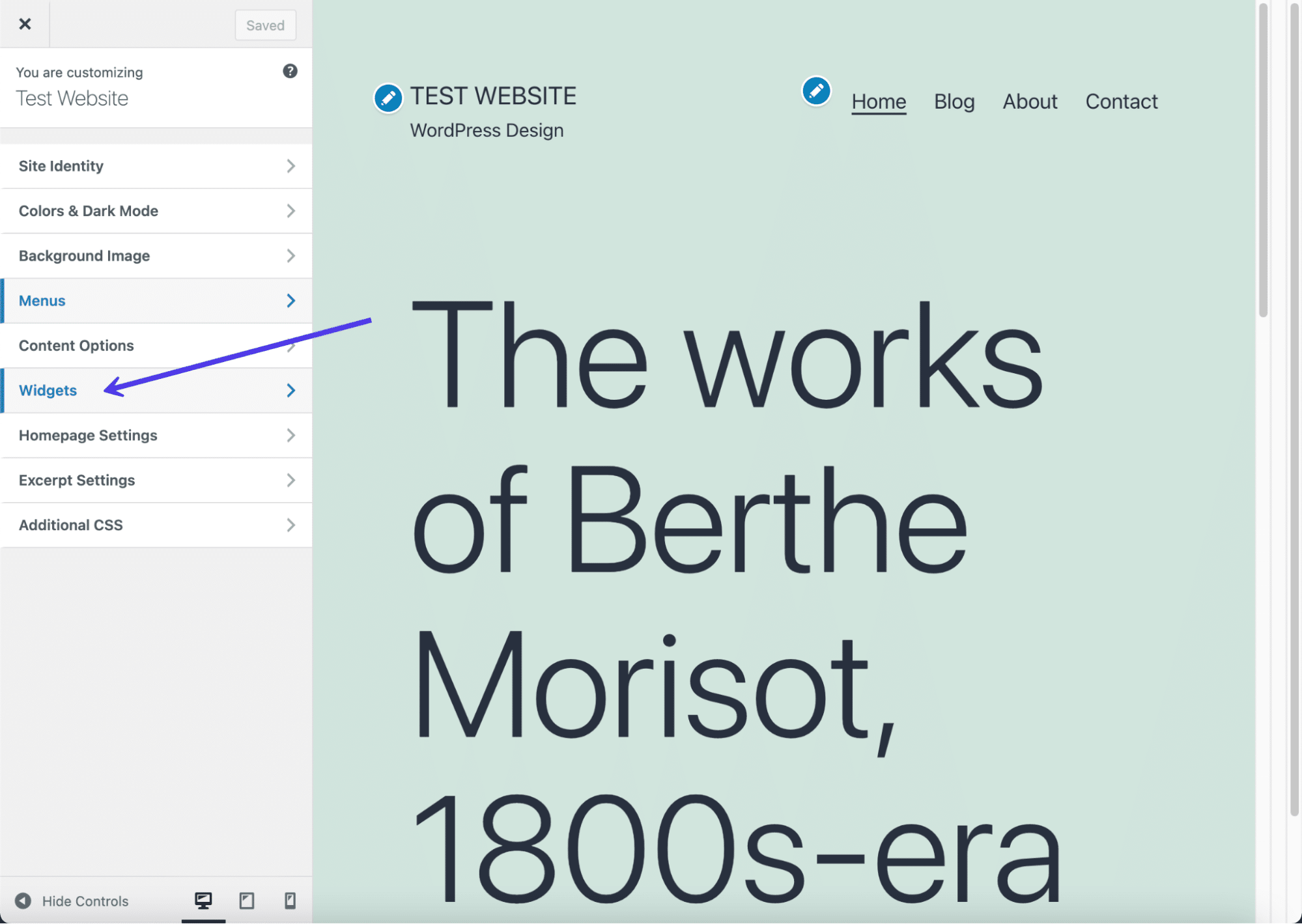
This current theme nosotros're using provides a Footer Widget module. If yous don't encounter an option to put widgets in the footer, consider trying a new theme, or use menus instead of widgets.
For this example (with a footer widget area), click on the Add A Widget push.
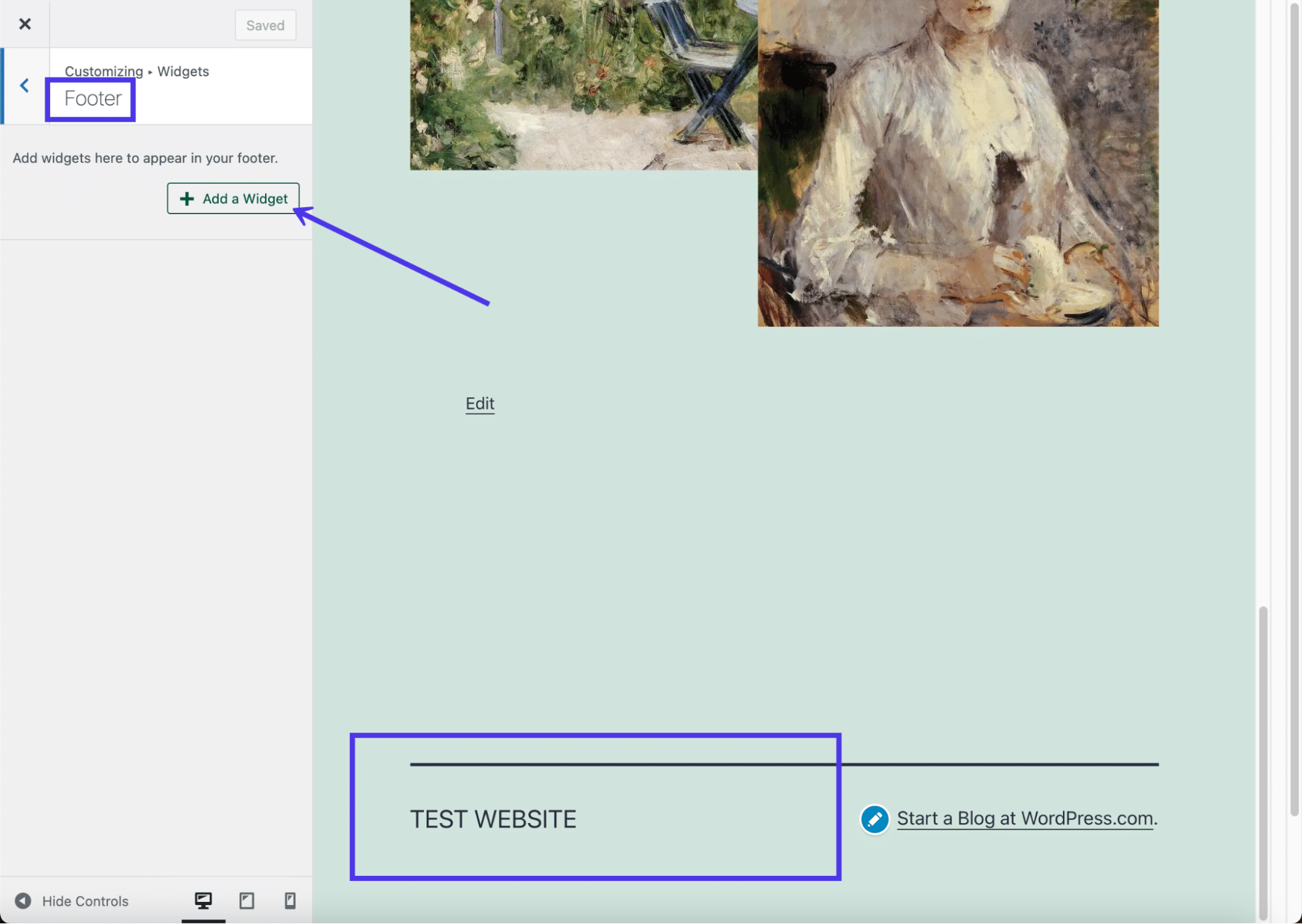
A slideout menu appears with a collection of widgets. You lot tin select whichever widgets make the virtually sense for your visitor.
Again, the theme dictates how many widgets you lot can fit into the footer without it looking likewise cluttered. It appears this particular theme allows for well-nigh three columns of widgets before the design starts looking messy.
For our example, we'll choose a Contact Info and Map widget, along with a Follow Blog widget, which prompts visitors to sign upward with their email addresses.
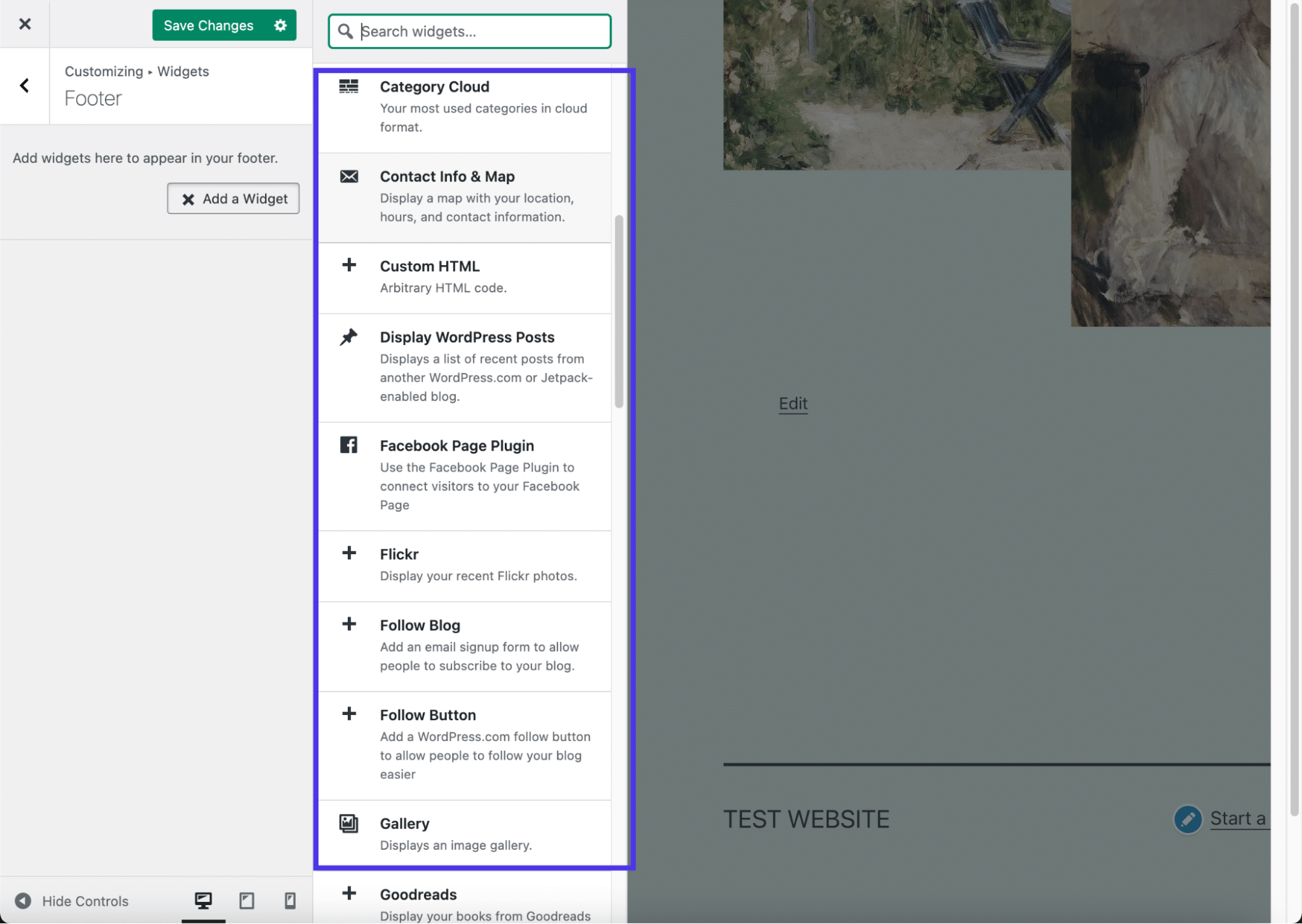
The preview on the right shows the widgets in action. We recommend going through each widget settings panel to configure individual elements similar the display text and cull which fields y'all want to prove in each widget.
Make sure you click on the Save Changes button so the widgets appear on the front finish of your website.
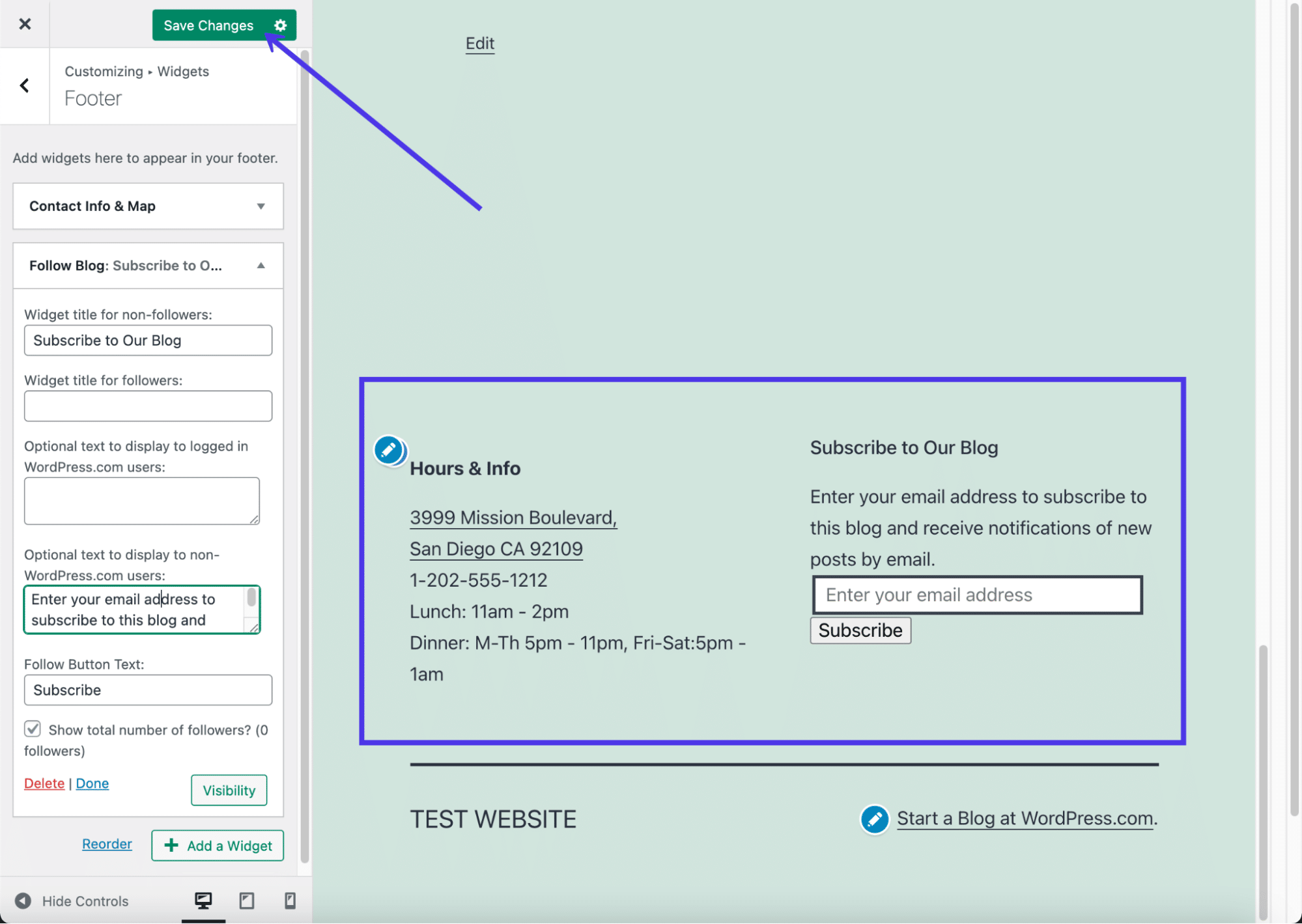
You also may find that WordPress.com automatically adds your site title and a WordPress credit at the very bottom of your footer. Y'all tin commonly get rid of the site championship if you lot want, but the WordPress credit removal requires you to pay for the Business Plan.
To modify both of these elements, click on the Site Identity push button.
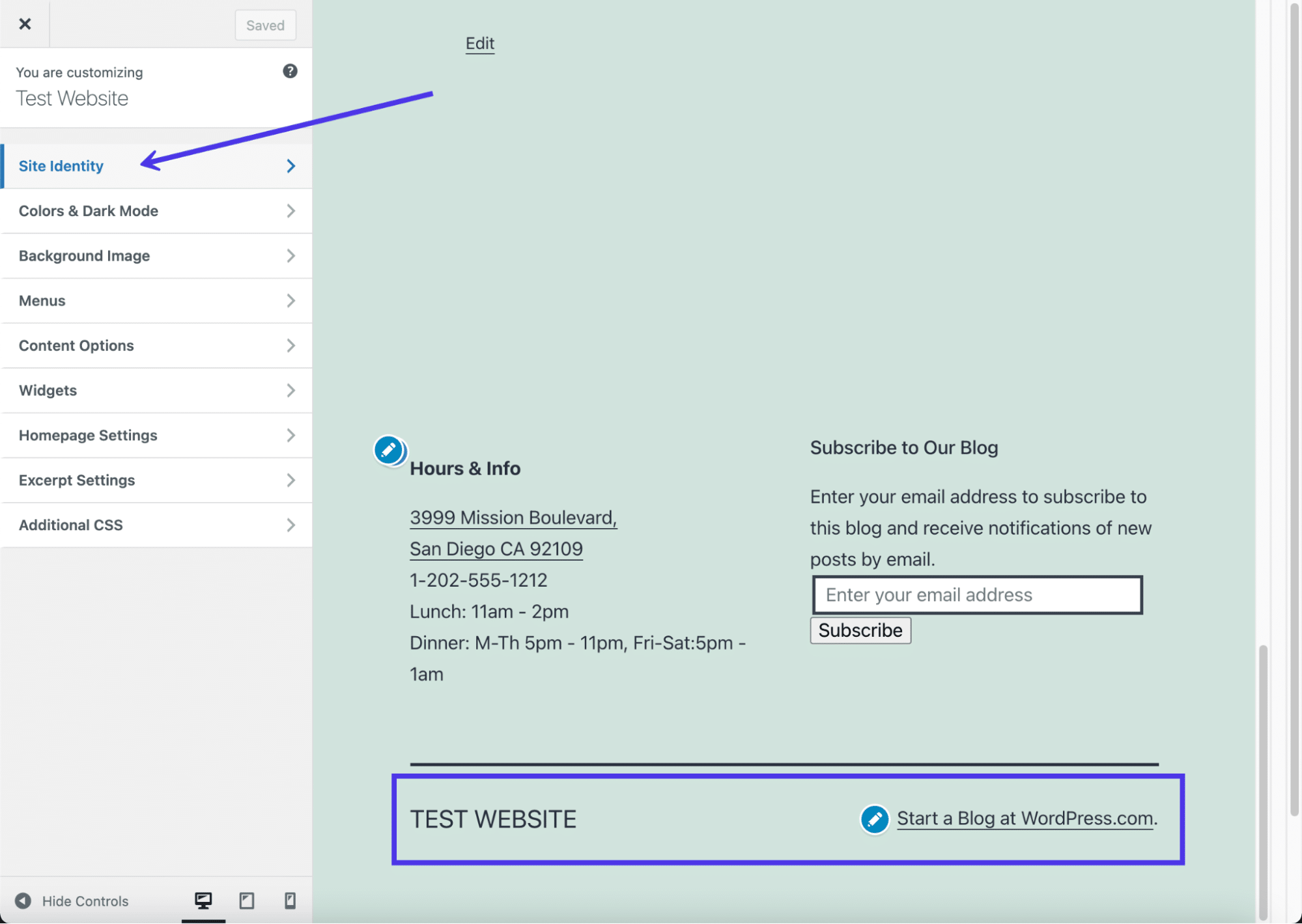
Kickoff off, become to the lesser of the settings to observe the Footer Credit field. Click that dropdown to reveal all possible options.

Every one of the credits has some sort of reference to WordPress. A WordPress credit isn't a big deal if you're running a personal blog or online journal, only nosotros suggest you upgrade to the Business Plan and remove the credit if your site is for a legitimate business organization.
Afterward that, yous tin click on the dropdown menu and choose the Hide choice to get rid of the credit completely.
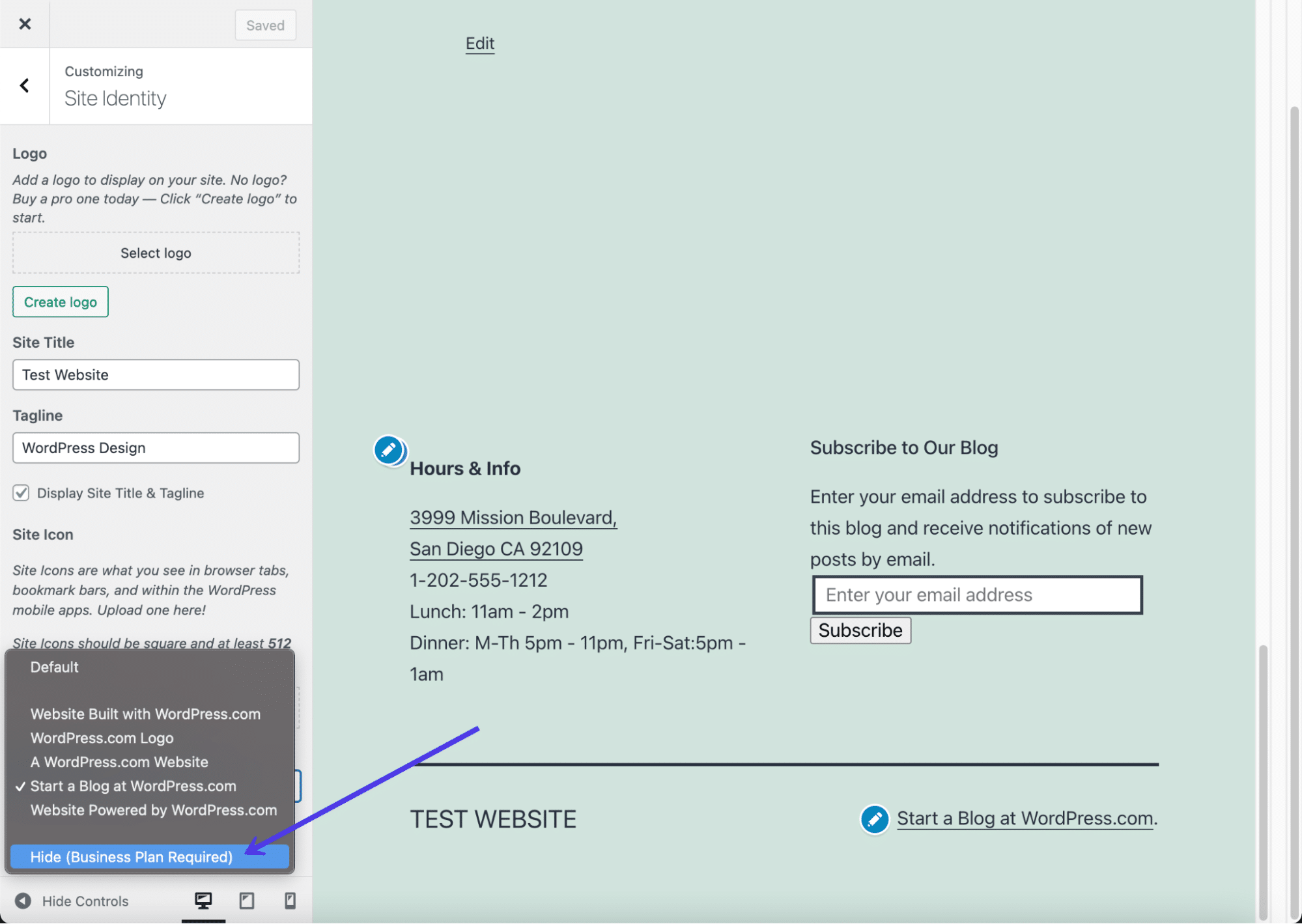
The credit so disappears in the preview, leaving whatsoever widgets you added to the footer along with the site title.

Some themes accept the power to remove the site title from the footer as well. The easiest way is to uncheck the Brandish Site Title and Tagline box. That gets rid of the site title in the footer and potentially the header. For the header, nosotros recommend uploading a logo anyway.
Other themes take unlike ways of removing the site championship and tagline. Sometimes it'southward not possible at all, while other times the site championship isn't included in the footer, to brainstorm with. When in uncertainty, endeavour deleting what'southward inside the Site Title field if you don't have the Brandish Site Championship and Tagline check box.
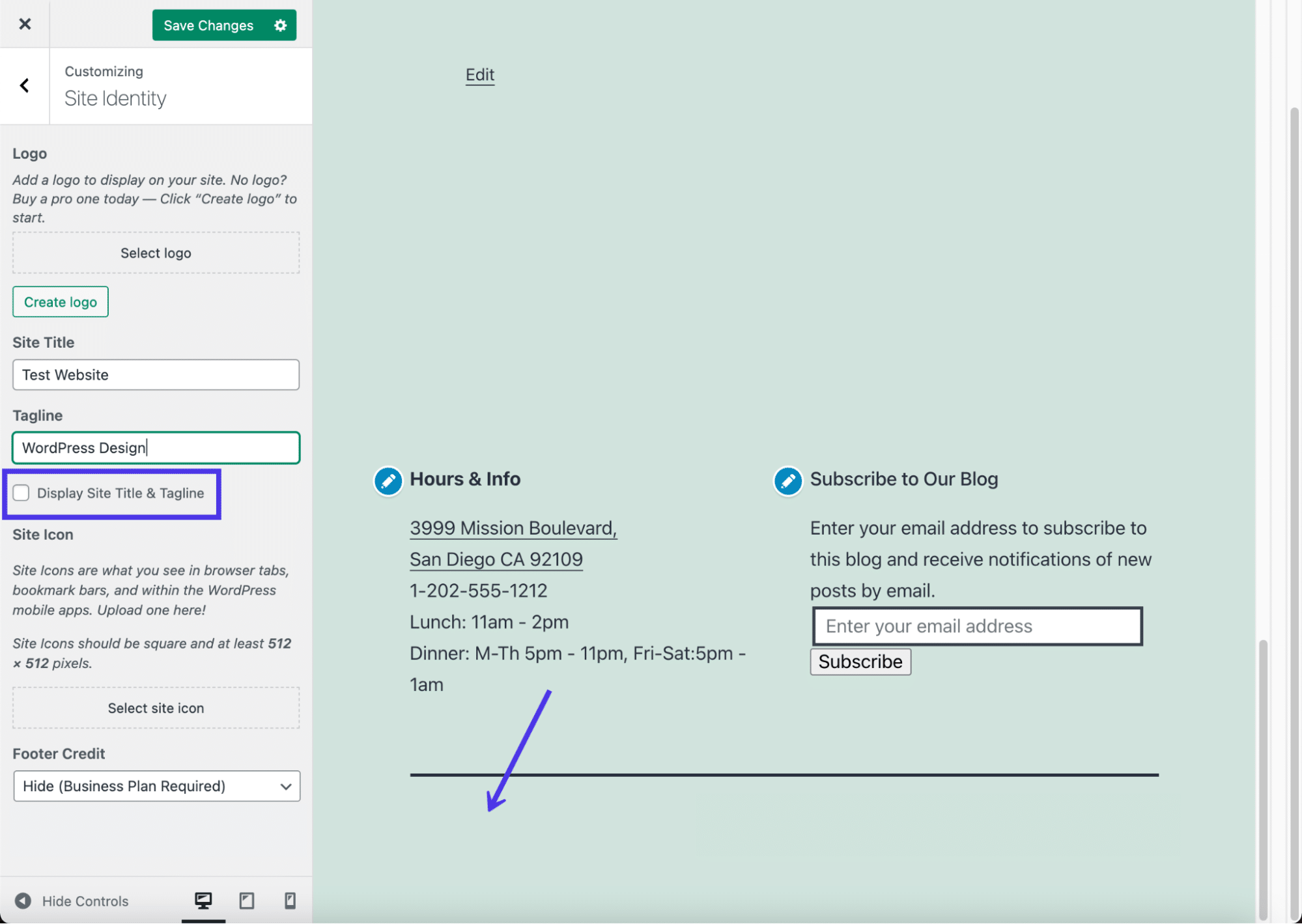
Another way to insert content in your WordPress footer is past utilizing the Menus panel. Not all themes let for menus in the footer, only information technology's a practiced idea to at least bank check.
Click on the Menus tab to continue.
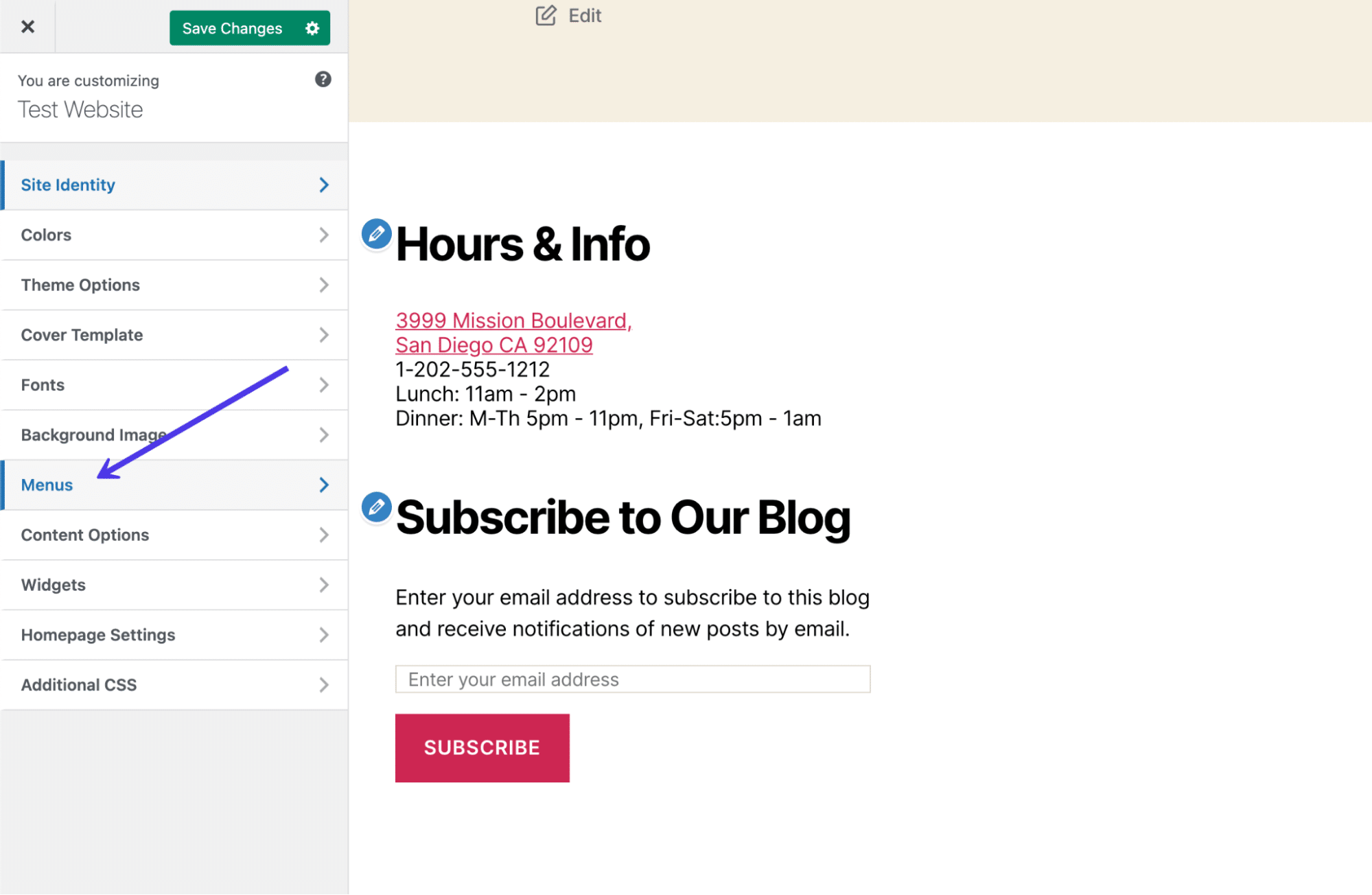
Select View All Locations. This brings upwards a list of where y'all're allowed to place menus in this particular theme.

For our case theme, we accept quite a few card location options, one of which is for the footer. You won't be so lucky with every theme you come across, and then exist prepared to either swap them out or consider using the widget technique for editing your footer instead.
With themes that support footer menus, click on the Footer dropdown field.
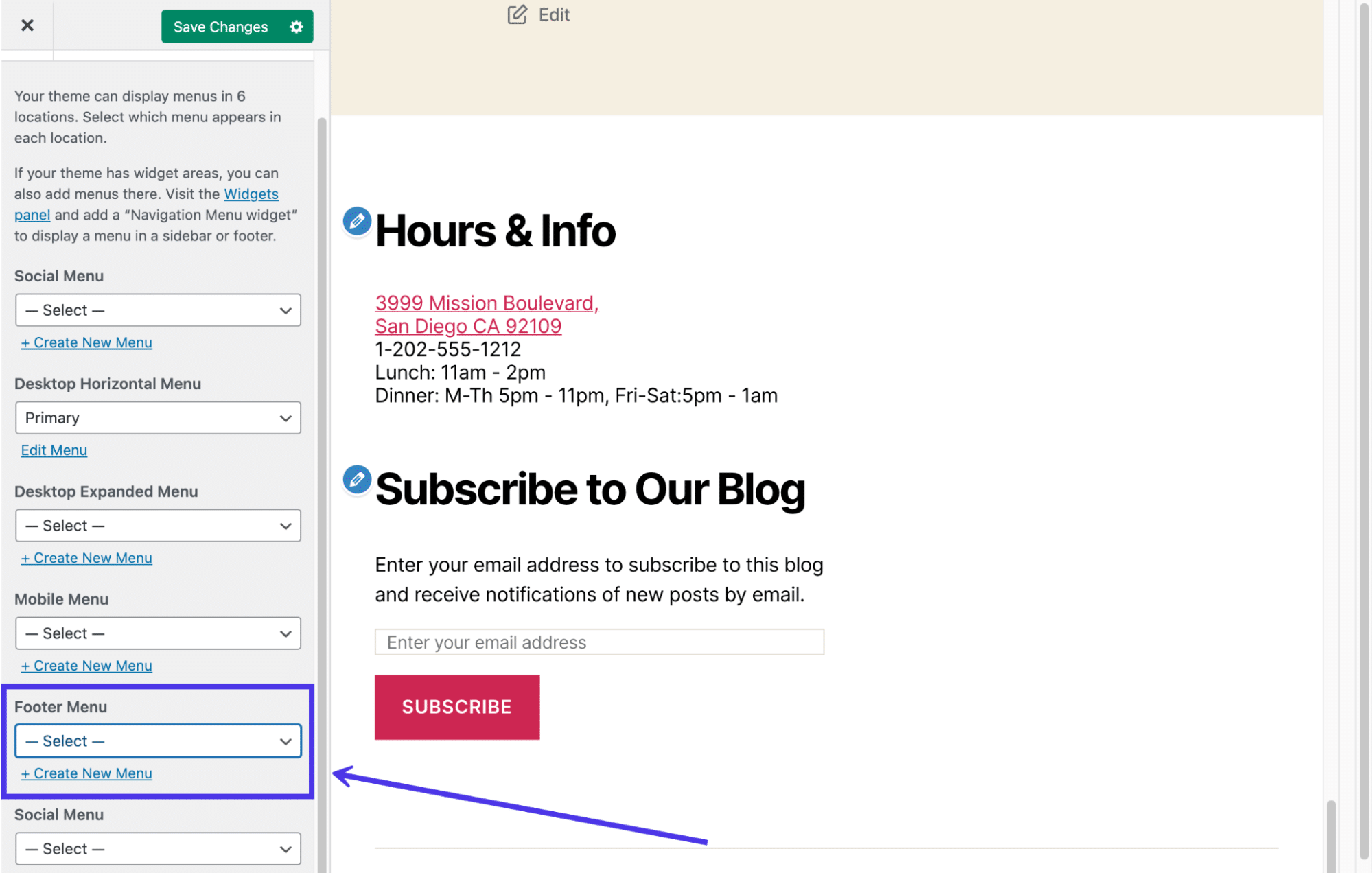
We chose a premade Social bill of fare for the footer. Feel free to select the Create New Menu link if you don't already have a suitable menu.
The result is a simple text/link carte du jour that appears above whatever widgets you already added to the footer. It's possible you're unable to add widgets to your theme, and so yous may not see the verbal same format.
Continue in heed that all menus are only lists of text and links, so you won't be able to incorporate something like a social media icon card unless yous consider a separate plugin that supports that.
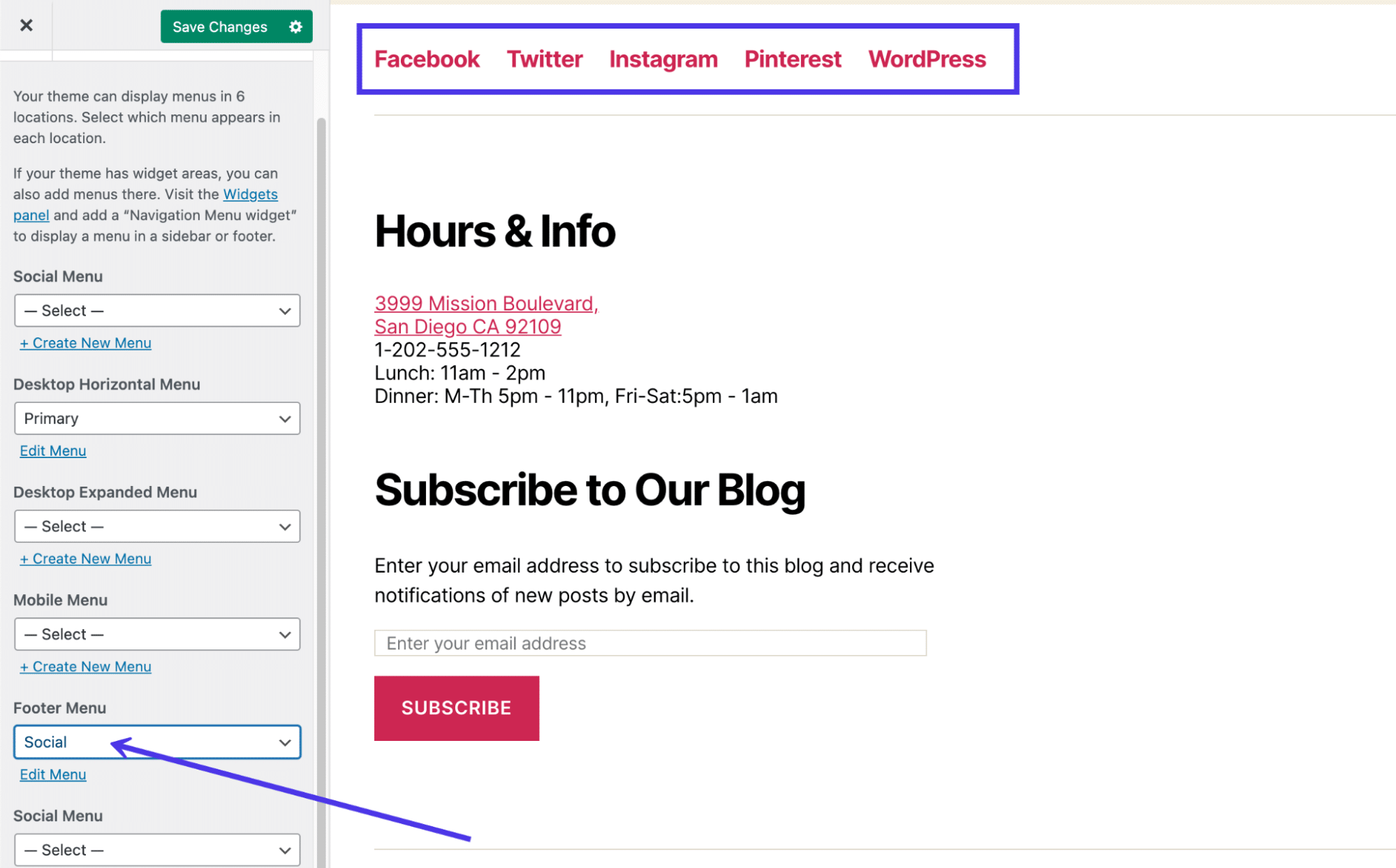
How To Add Social Media Icons to WordPress Footer
A mainstay of the footer area is the classic listing of social media buttons. Many websites add them in their primary menus, but it's also a wonderful idea to have them at the bottom of your website also, or every bit an alternative to placing the social buttons at the peak of your site. In general, if yous feel the header is already cluttered, become for footer placement instead.
Quite a few plugins provide widgets to add social media icons and links to your footer and header. Therefore, we suggest straying away from any custom coding here.
Although many social icon plugins be, the goal for our purposes is to discover one that specifically provides a quick widget for adding your links and customizing the buttons.
A pop, highly-rated solution is called Social Icons Widget & Block by WPZoom. It has over 400 icons for social media and other platforms, along with a widget to place your icons directly into your footer. Not only that, but you tin upload your own custom icons and switch settings for colors and sizes.
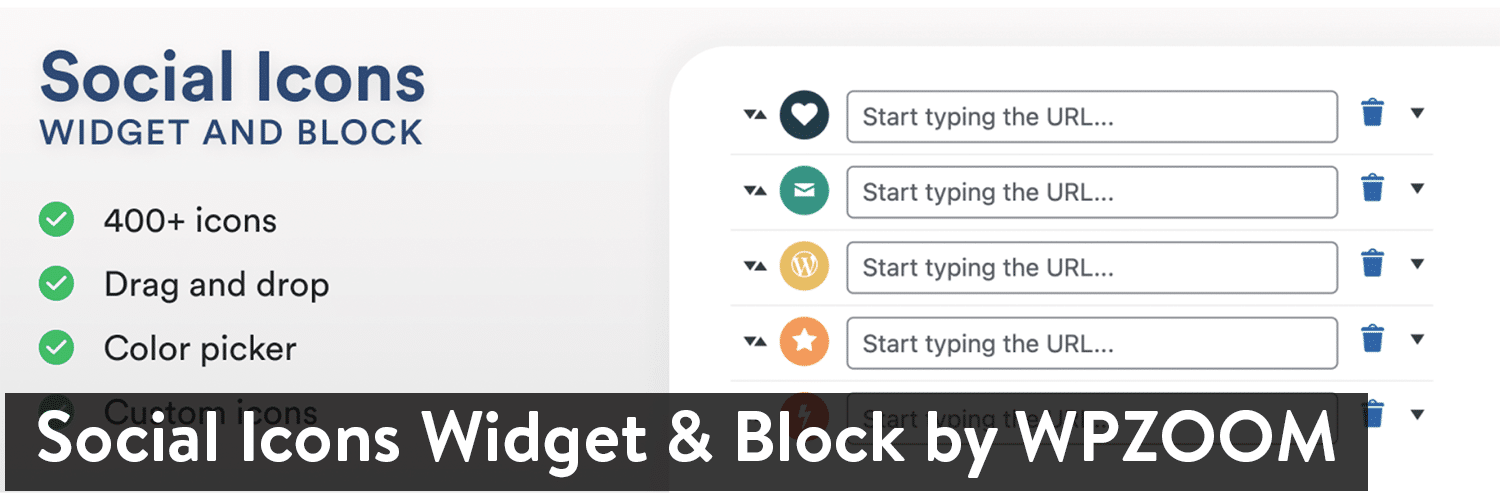
Subsequently installing the plugin, y'all can get to the Settings page and disable sure font packages if you don't desire them. Nevertheless, all of them are already active, and then skip the settings if yous'd rather have everything available to yous.
To add social icons to your WordPress footer, become to Advent > Customize.
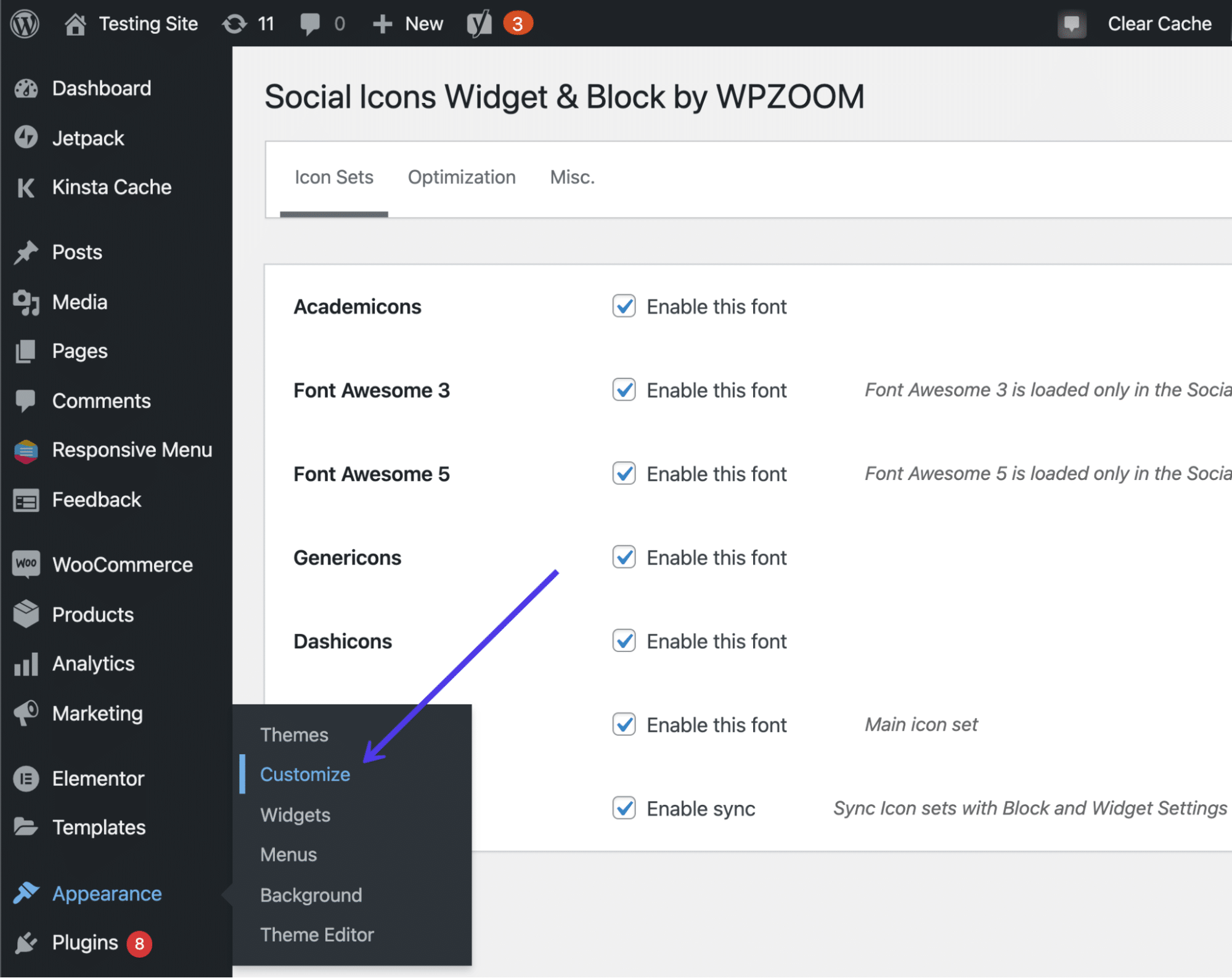
This brings you into the WordPress Theme Customizer, where you're able to add widgets to the footer (as long as your theme supports widgets in the footer). As we've mentioned earlier in the article, the but manner to get around a theme that doesn't accept a footer widget is to detect a new theme or custom code the footer yourself.
Find and click on the Widgets tab to proceed.
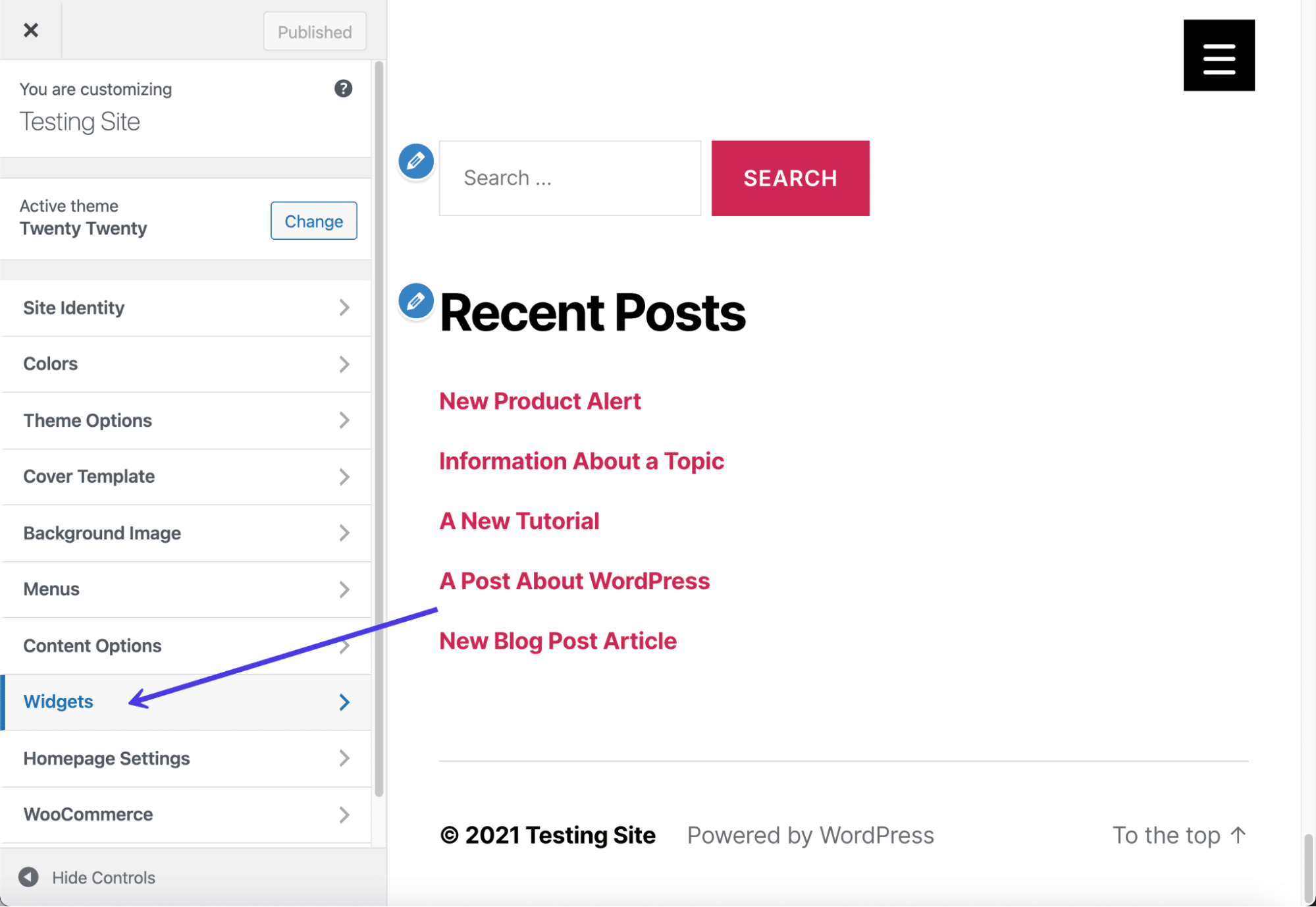
This theme has two areas to add widgets to the footer. That's not the case with all themes, and so you may find that your theme has no footer widgets areas. On the other hand, you might get lucky and accept four or five spots to identify widgets in your footer. It all depends on the theme you install.
Click on one of the Footer tabs.
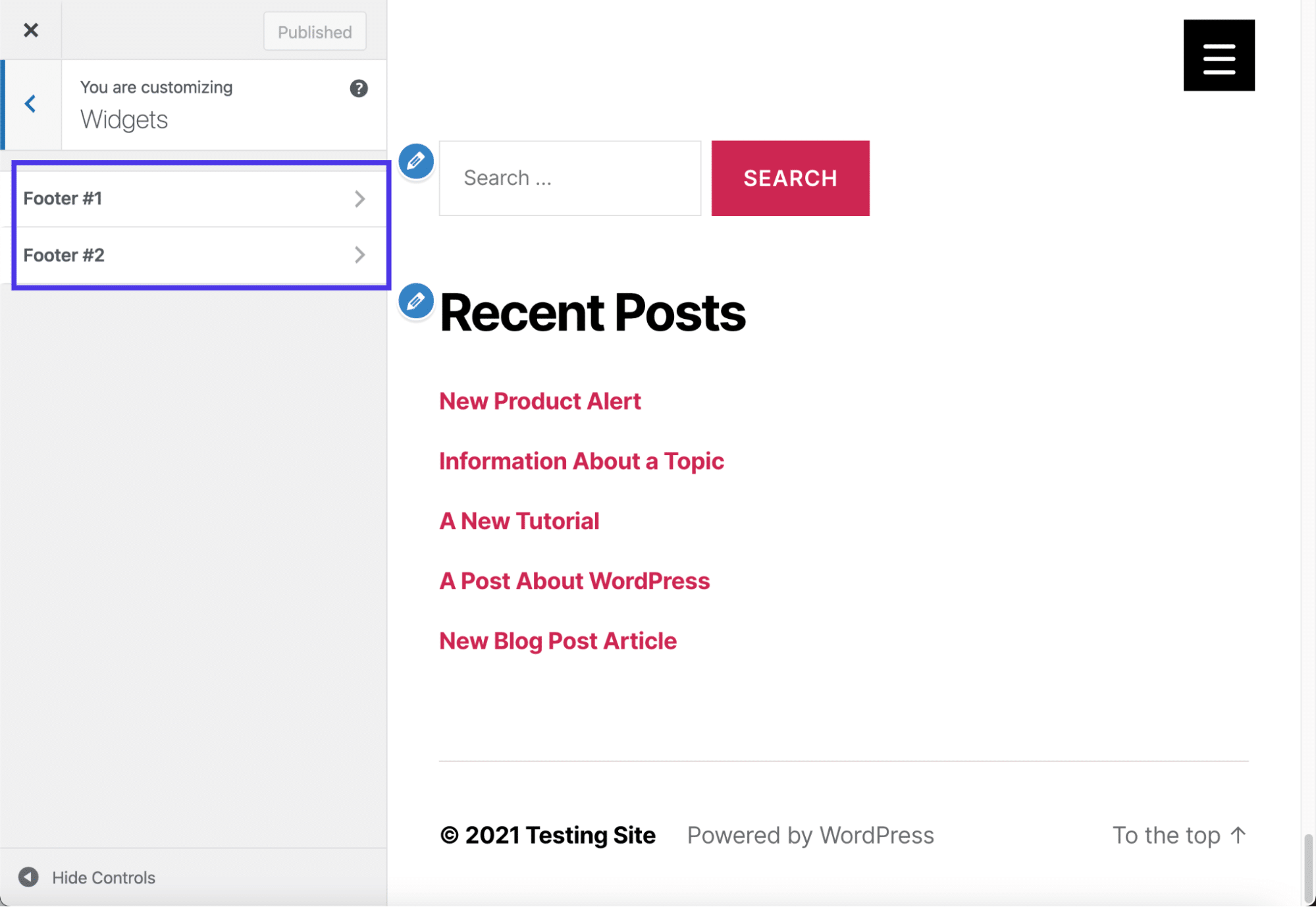
Information technology's possible to add a myriad of widgets — or at least whichever widgets you lot take installed — to the footer.
Click on the Add together A Widget button to show the carte du jour of widgets available to yous.
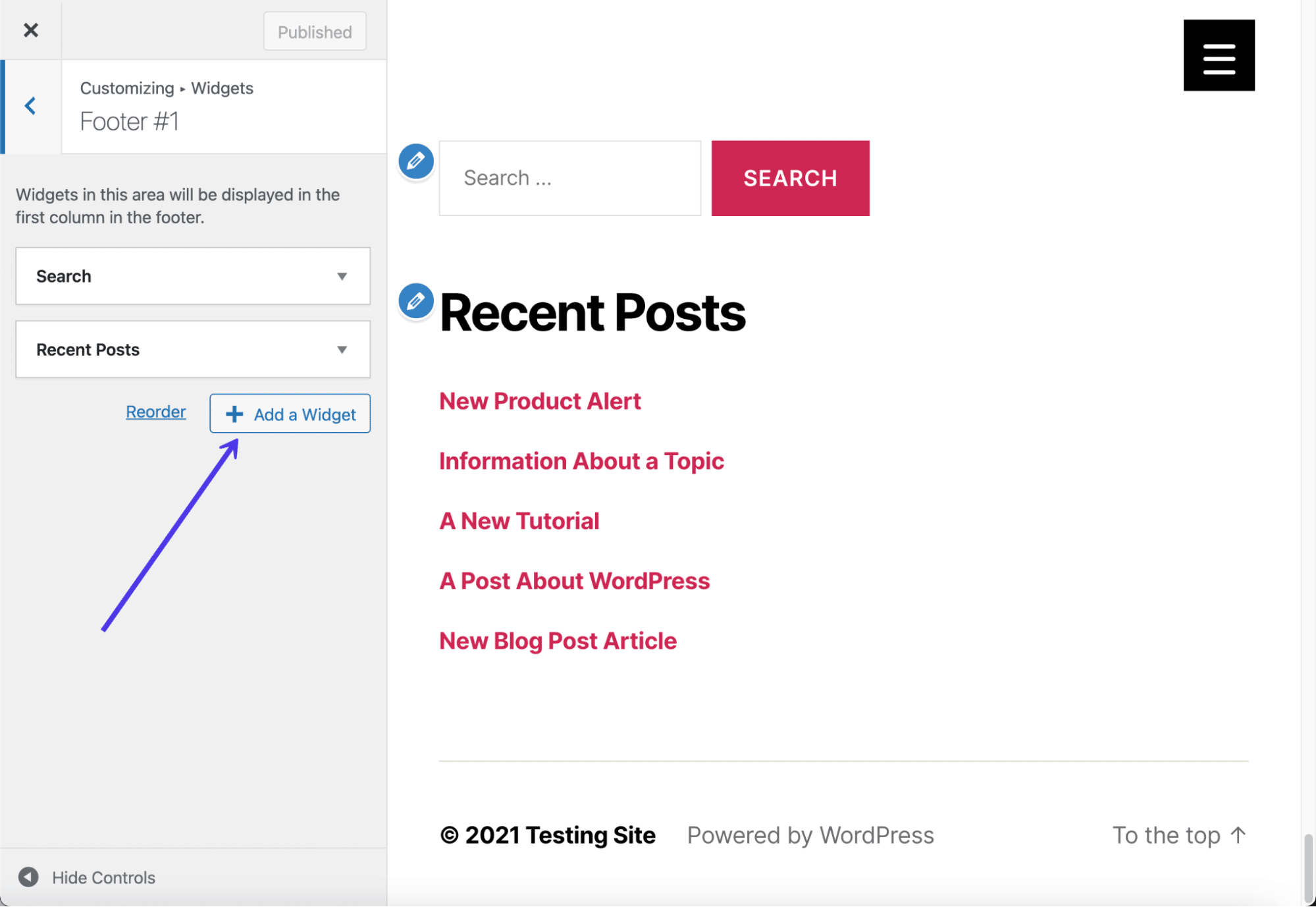
The slide-out menu provides a search bar and a list of possible widgets. Scroll down to locate the widget called Social Icons By WPZOOM.
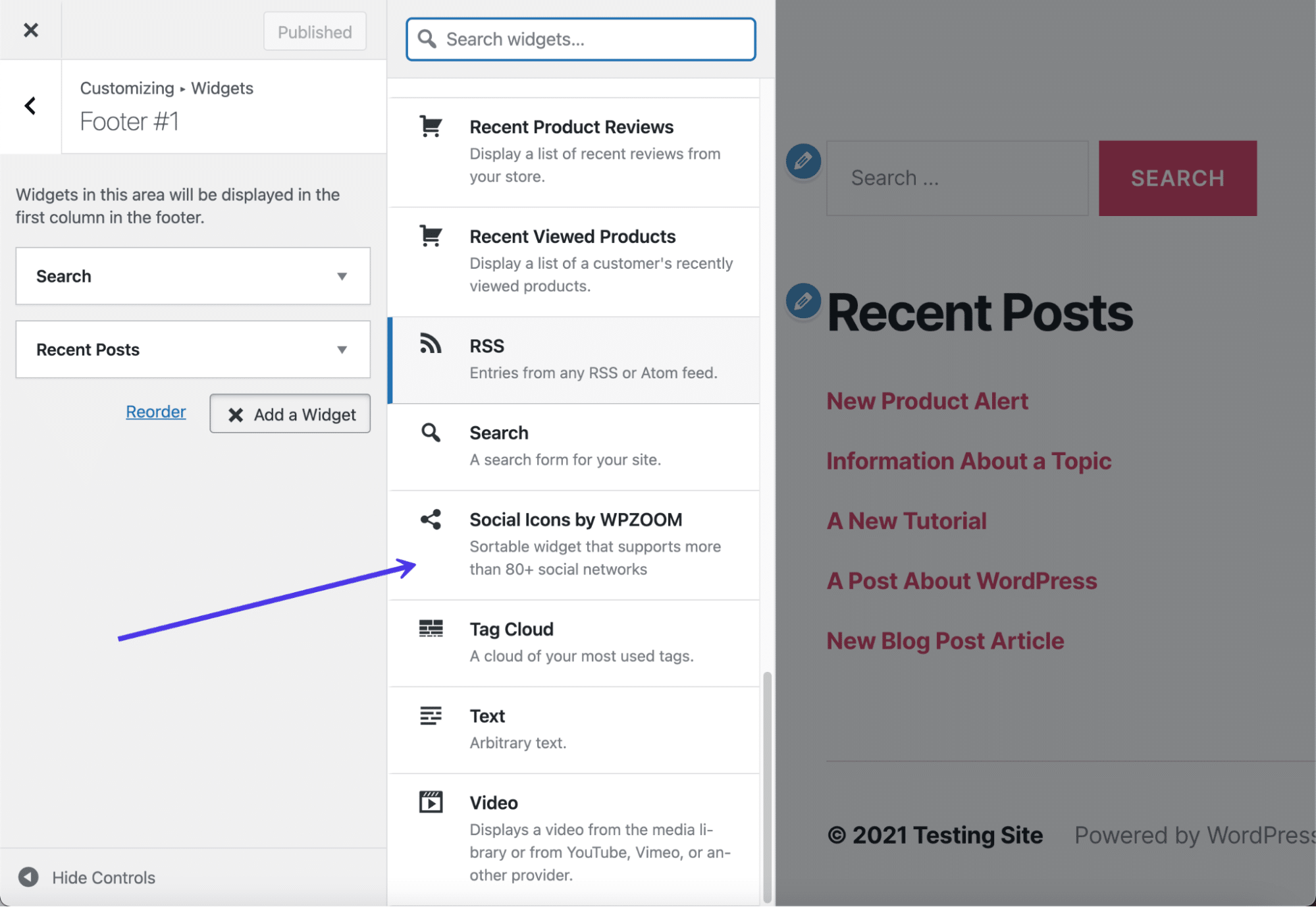
You should now see the default social media icons and buttons in the preview for your website.
However, you lot'll still need to customize the settings for these buttons to settle on the size of those buttons, coloring, and which links you want them to lead to.
Start by typing in a title for the widget, which appears in the footer (you can also go out this blank if yous'd like). Continue past specifying settings like whether y'all want icon labels, nofollow links, and specific icon alignments.
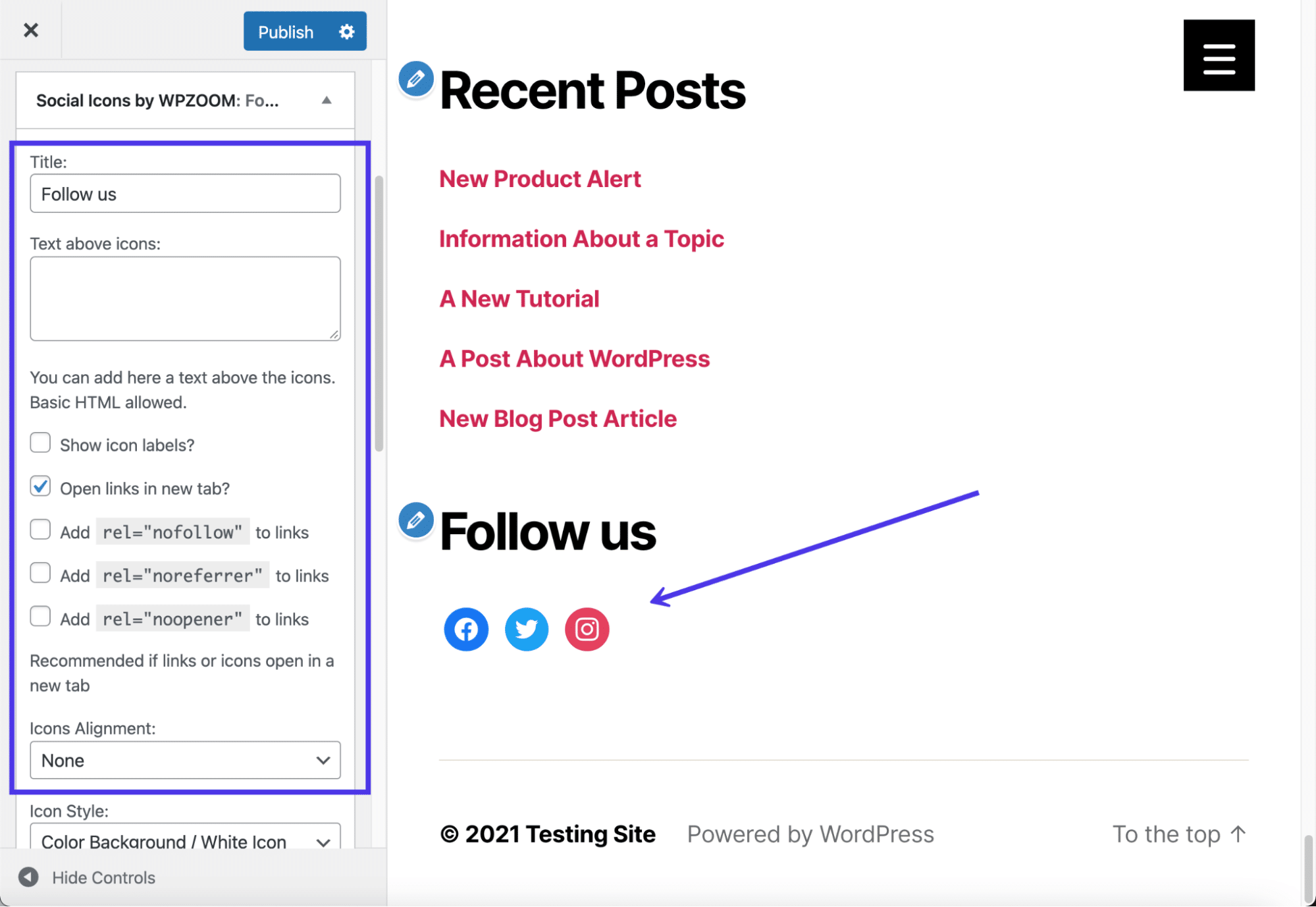
Continue on with the settings to specify the icon style, background style, and padding. You tin can also choose an icon size and color. Keep in listen that you need to click on the Relieve button at the lesser of the widget customization module in lodge to see the results of your changes in the preview.
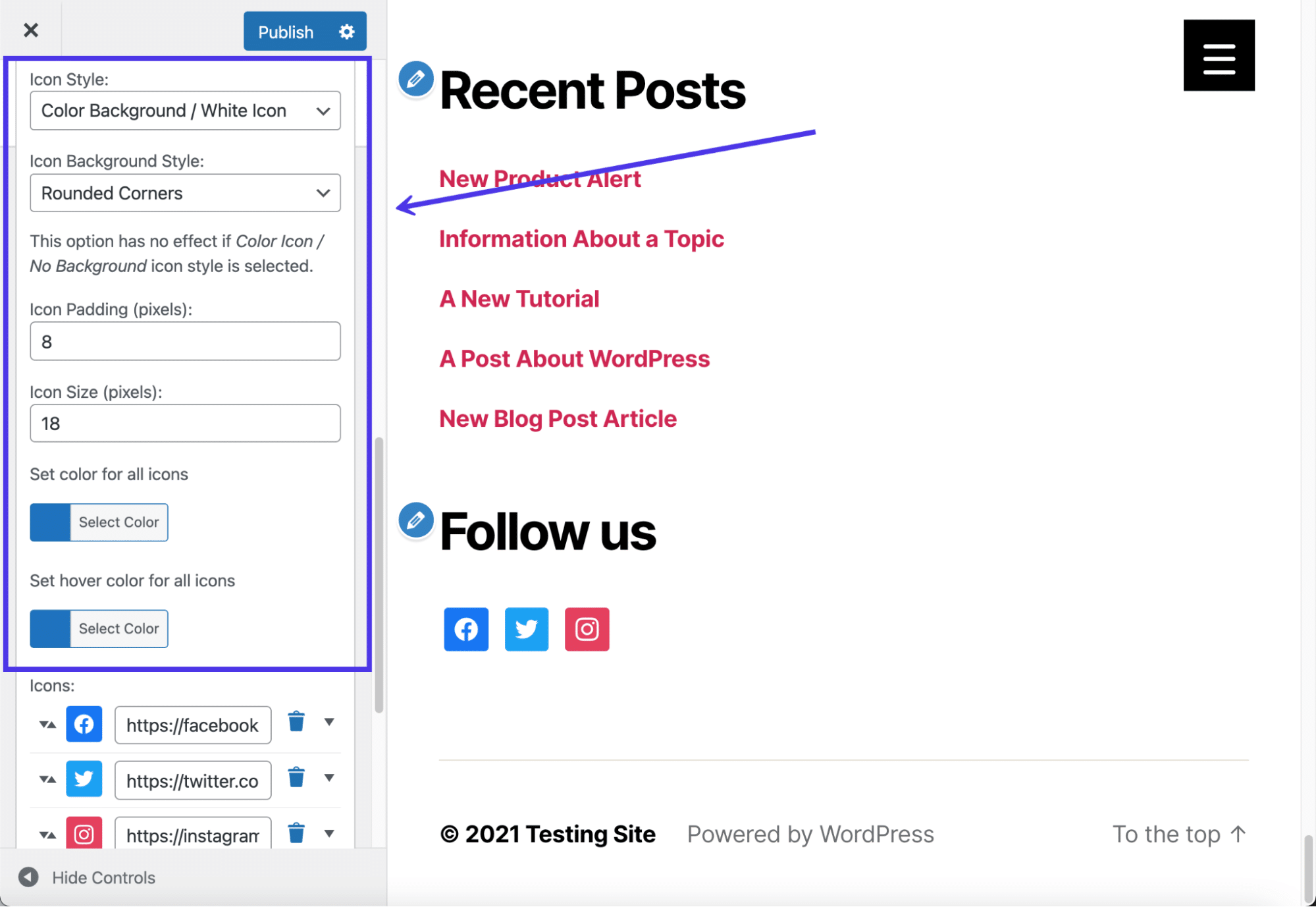
The Icons field already has some default social icons in there for you. Make a list of the social media sites you run for your company, and re-create and paste the links into the corresponding fields. Remove any icons that don't brand sense for your business.
To open upwards the icon library and add more icons, click on the Add More button at the bottom of the field list.
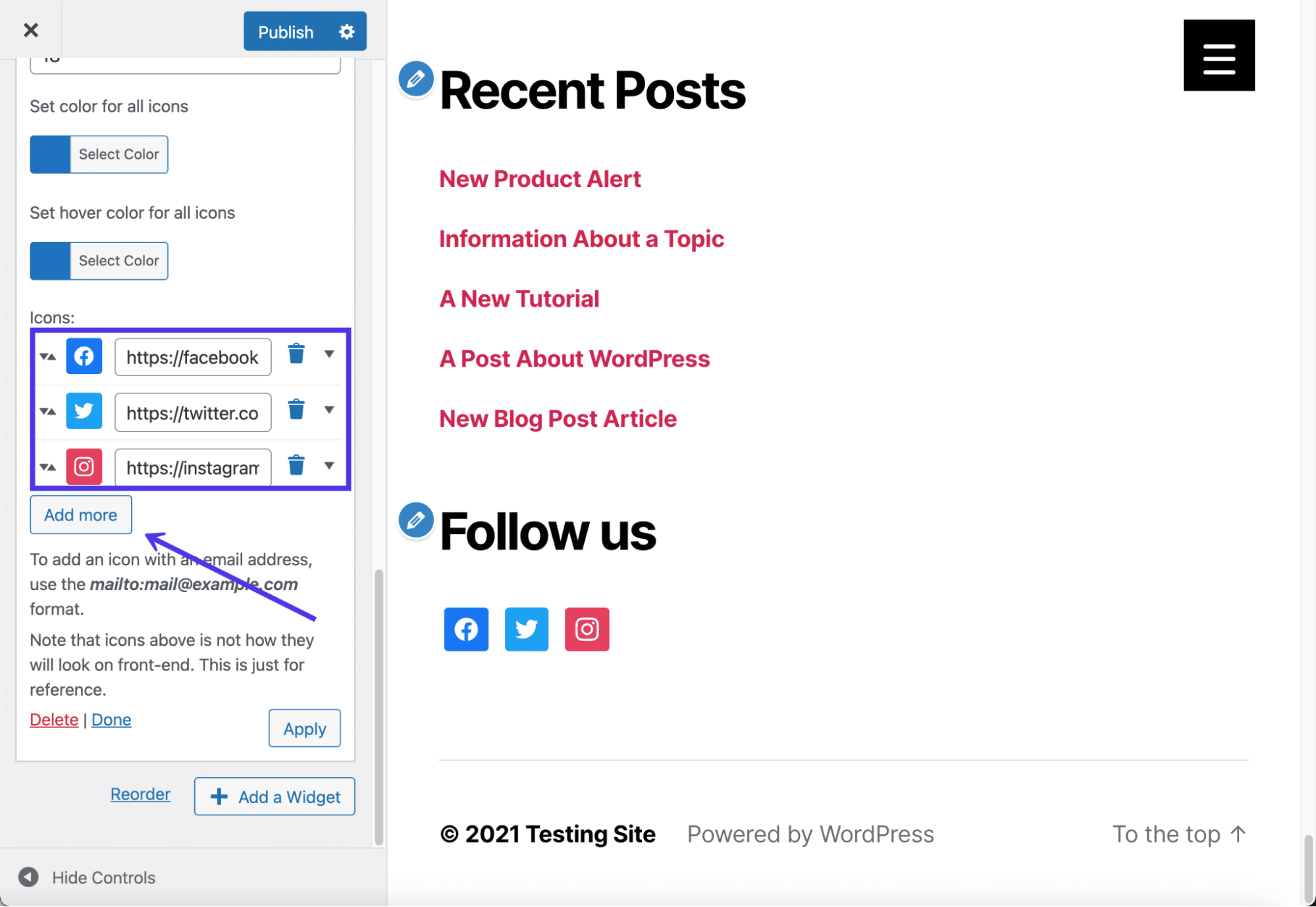
The plugin offers a large drove of icons, with options to set icon colors, hover colors, and the icon kit source. The primary kit is called Socicons, merely several other kits come up with the plugin for free. Click on the Select Icon Kit dropdown to come across your options.
Finally, browse through the icons provided with each kit. Many of them you may not fifty-fifty recognize, so merely stick to the ones that you actively run and which will provide value to your customers.
In our example, we'll choose the YouTube icon to add together to our footer besides.
Click on the Salve button to place information technology into the list, and then click the side by side Save button at the bottom of the widget box to meet your changes.

Every bit you lot can see, we've made changes to the size and shape of the icons, while also calculation an actress social icon. If your alterations don't look quite correct, go dorsum into the widget settings to resolve the issues.
Always remember to hit the Publish button in order for the widget to take effect on the forepart of your website. Nosotros also recommend checking the frontend yourself to ensure the social icons announced the correct way.
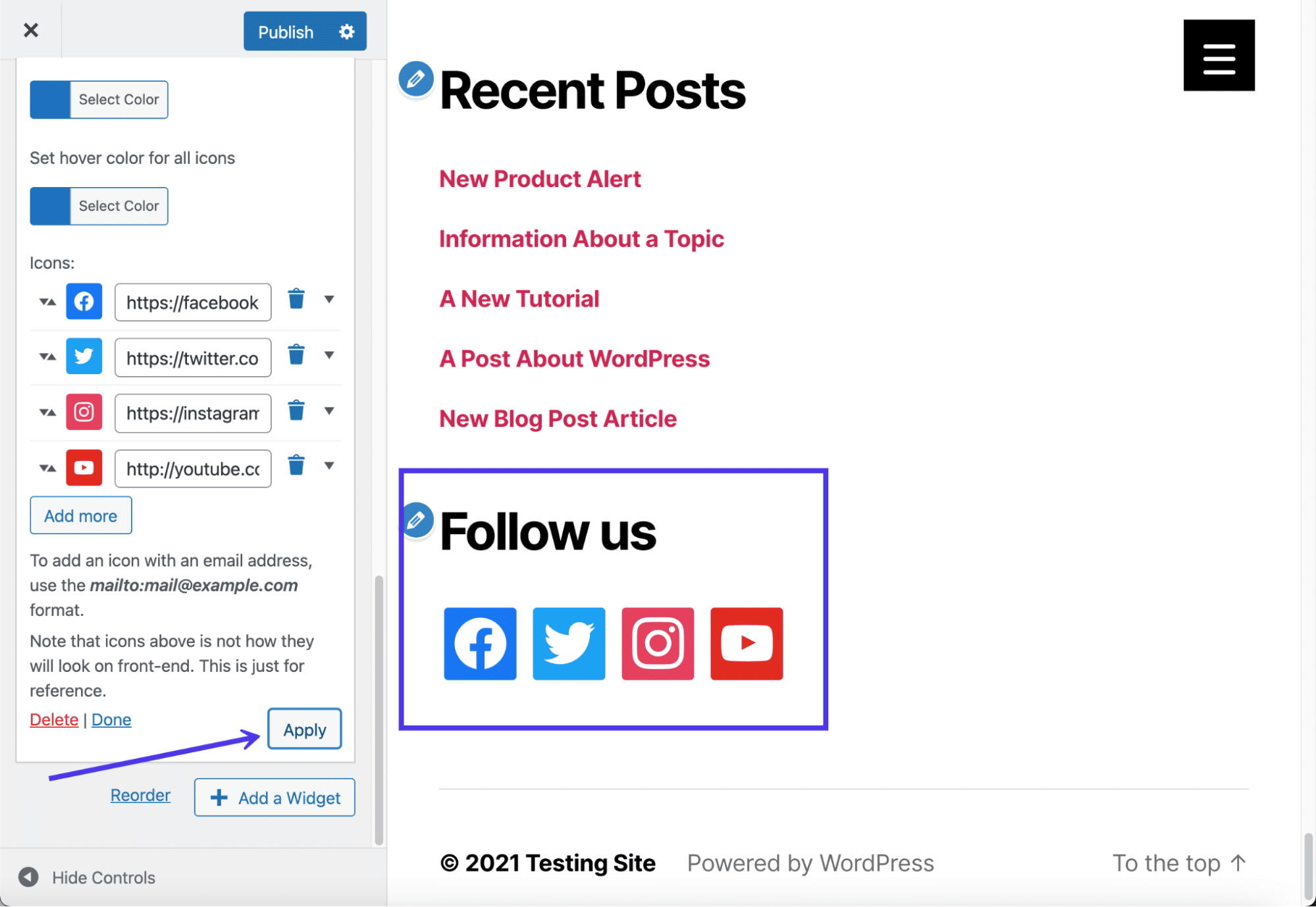
How To Add a Background to Your WordPress Footer
Footer backgrounds are possible with the help of some footer plugins and page builders. Even so, you besides have the ability to place an paradigm or color groundwork behind your footer by using the basic settings that come up with your theme.
In case all else fails, nosotros'll show you how to insert CSS code to add a background to the WordPress footer.
Before anything, cheque your theme settings to see if footer background capabilities come up standard. The Abletone Theme, for instance, offers a Footer Background Prototype tab inside the Theme Customizer.
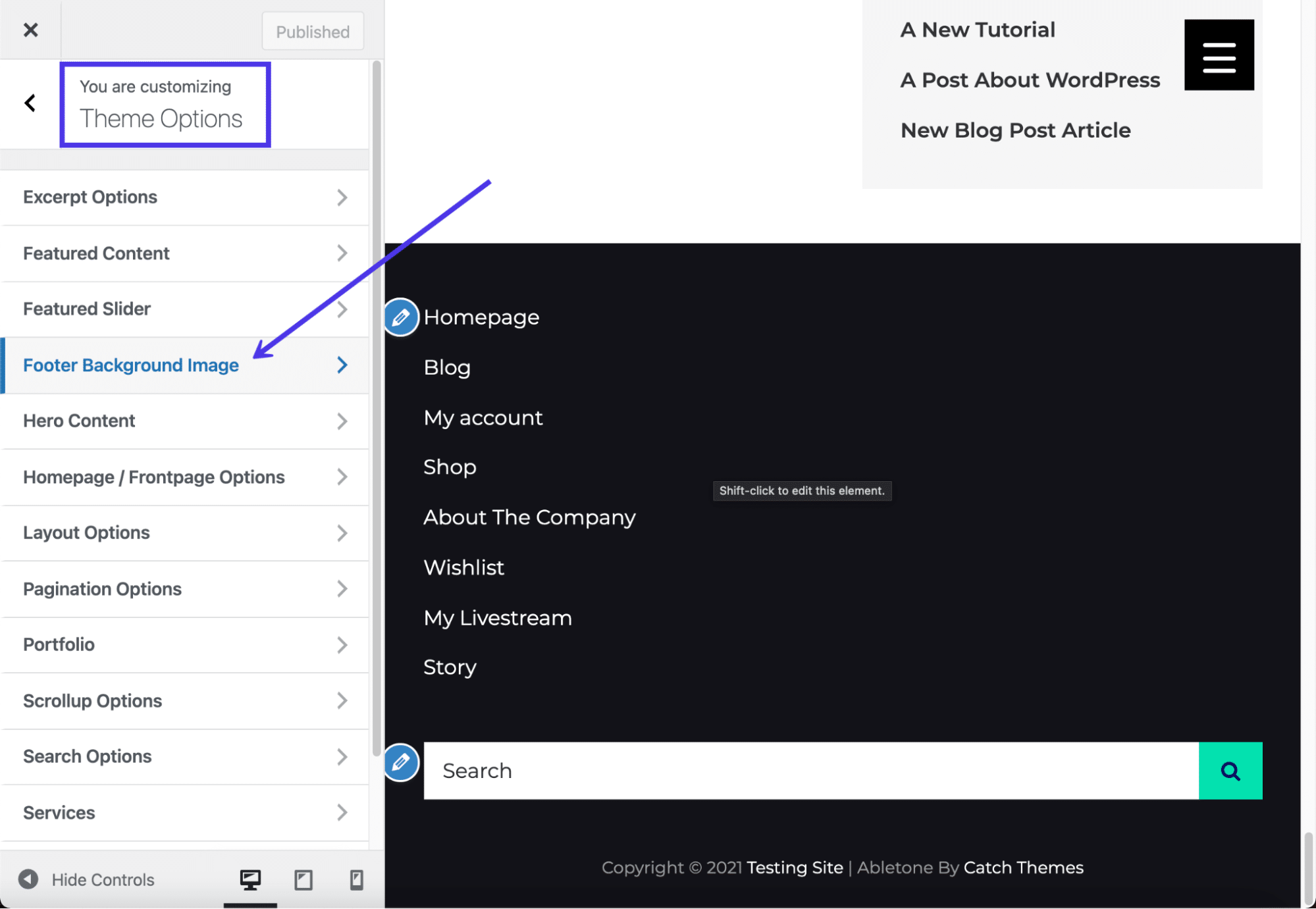
All that's required is for you to click on the Select Image button and search for an image in your Media Library, upload a new ane from your estimator, or look for a stock photograph that will adapt your needs.
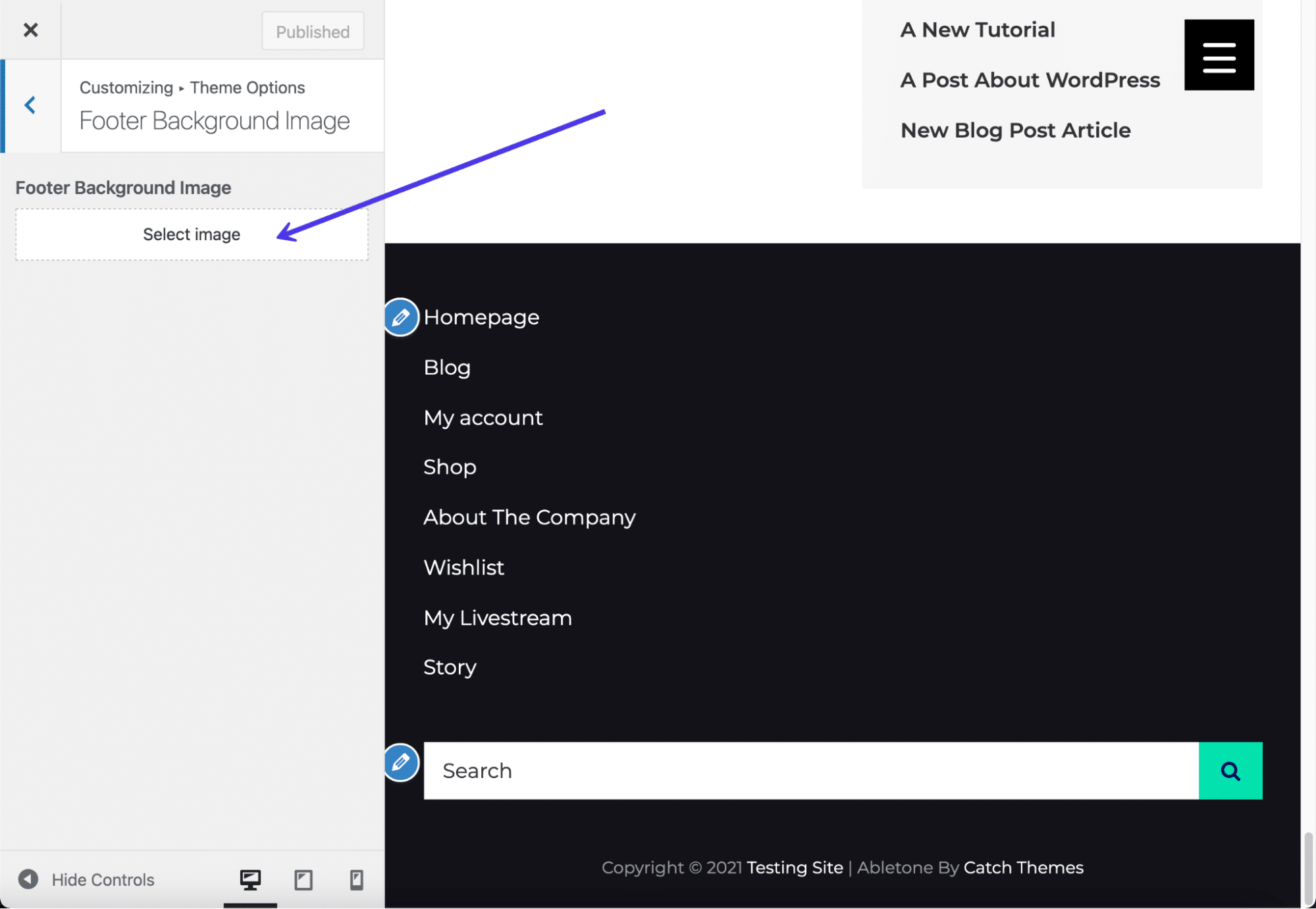
In one case uploaded, the paradigm appears as the groundwork for your WordPress footer. Some themes offer additional settings for stretching or tiling the epitome, just without editing the CSS yourself, you're stuck with whatever settings come up with the theme.
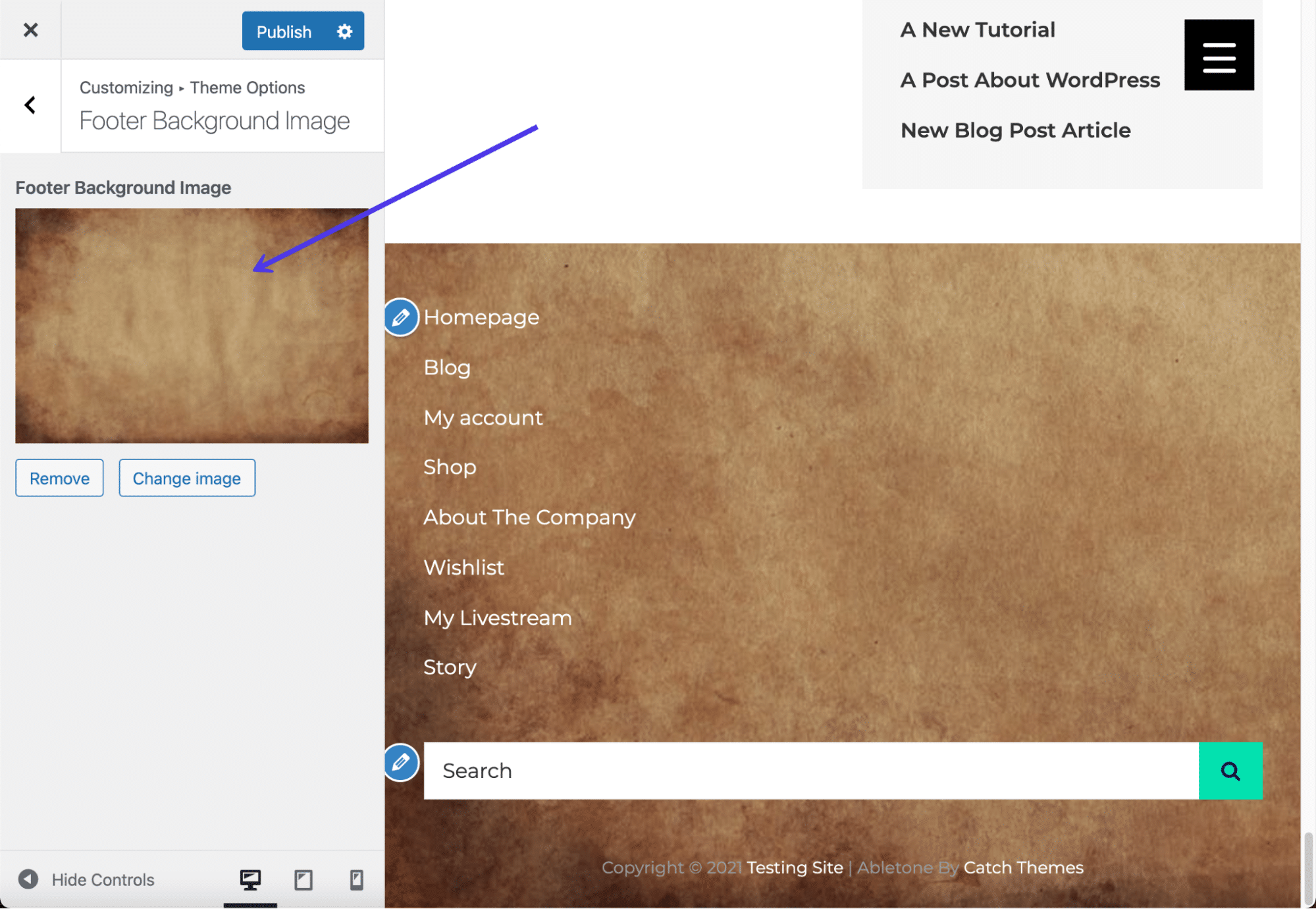
If you don't take a theme, page architect, or plugin that does the trick for calculation a footer background, though, adding CSS code handles this job regardless of your theme or folio builder.
Get to the Theme Customizer in WordPress, and so click on the Additional CSS menu item.

Paste this CSS code into the field, but replace the YOURIMAGEURL with the URL of your desired epitome:
footer { groundwork: url(YOURIMAGEURL) repeat; } You can find the URL for whatsoever image in its details view after it'south been uploaded to your Media Library.
Be sure to click on the Publish button to run across information technology on the front cease.
You lot tin can likewise insert other bits of code to change elements similar sizing and groundwork stretch size or repetition. As y'all may imagine, calculation the CSS code is a fiddling less elementary than clicking on plugin buttons, merely a quick search online can help you observe the correct code for your needs.
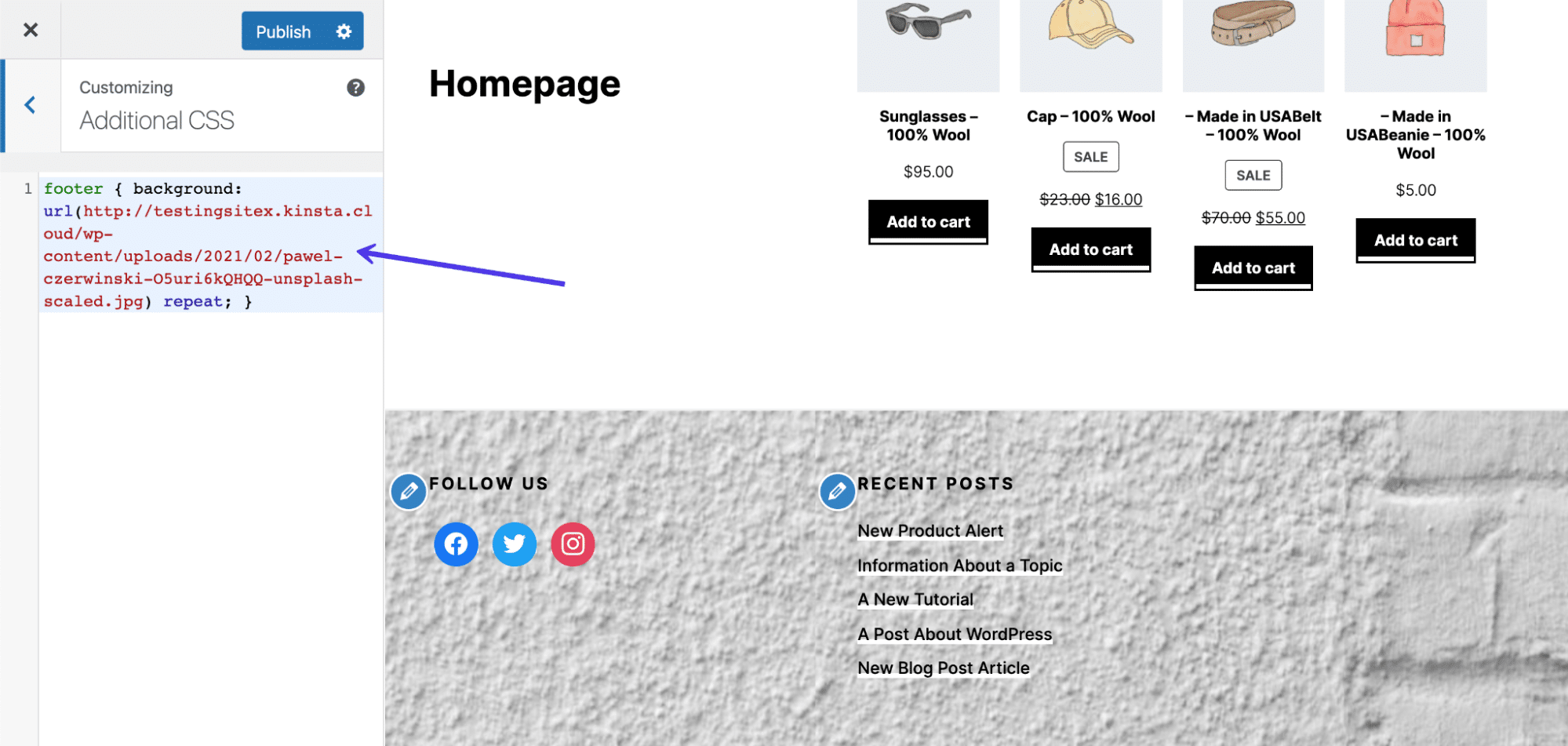
Removing "Powered by WordPress" Text
In the previous section, we covered how to remove the WordPress credit in your WordPress.com footer. Information technology'south a little tricker on a self-hosted WordPress site since most themes don't offering a manner to remove the credit in the Site Identity section of the Theme Customizer.
Therefore, nosotros must expect at other ways to remove the "Powered by WordPress" text in the footer.
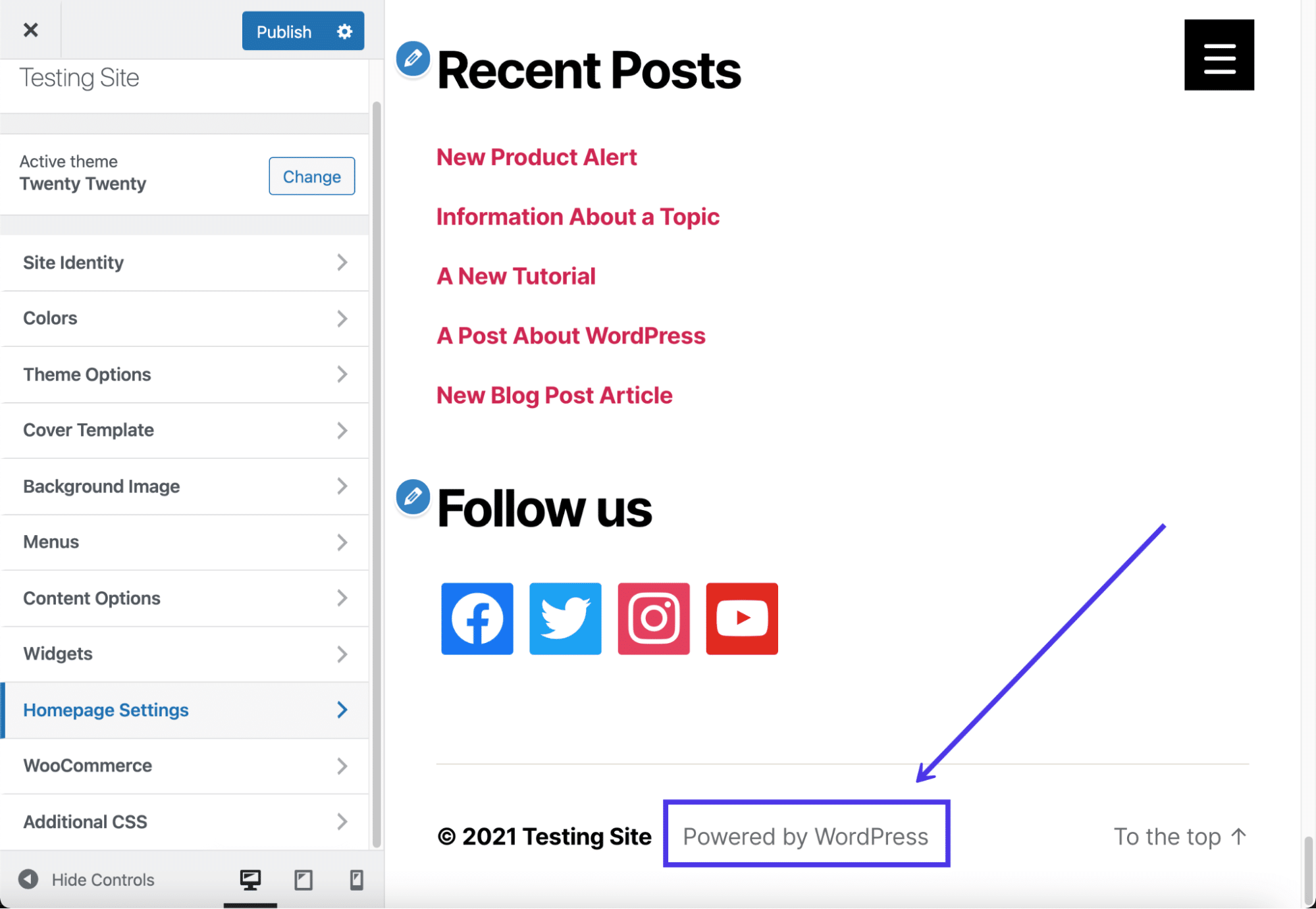
To tackle this process, read our in-depth guide on removing the "Powered By WordPress" tag in your footer. This noesis base of operations article covers all of the post-obit topics:
- Why you may want to remove the "Powered By WordPress" message
- When you might not want to remove information technology
- Methods to avoid when trying to remove the credit
- How to remove the credit with a plugin
- How to manually remove the "Powered By WordPress" credit
- Replacing the footer credit with your own lawmaking
Editing the footer credit with a plugin is significantly easier for the average WordPress user. However, going the manual route ensures you lot have total command over the footer, and it eliminates the need to accept another plugin installed on your dashboard.
Is It Legal to Remove "Proudly Powered past WordPress"?
Considering that WordPress makes it a fiddling tricky to remove the "Proudly Powered by WordPress" text from your footer, you may wonder whether it's kosher to get rid of the message.
The answer is that you're more than than welcome to have out the "Powered by WordPress" text in your footer without having to worry nearly any legal repercussions or violations of the WordPress Terms of Service. This is because WordPress employ falls nether a GPL (General Public License), meaning anyone can redistribute and modify WordPress in whatsoever way they meet fit.
Overall, we highly recommend removing the "Proudly Powered by WordPress" text since it has aught to do with your make and simply promotes another organization. Yes, it's squeamish to get the word out about WordPress, but not at the expense of your ain branding and valuable website space.
Now, footer messages shown by your theme developer are a unlike story. We'll talk nigh that in the next department.
How to Remove "Powered by XYZ Theme" Text in WordPress Footer
We now know that you'll have no problems with the police or WordPress when eliminating the "Proudly Powered by WordPress" footer message. Only what about some of the theme developers who put "Powered by XYZ Theme" in the footer?
Luckily, the vast majority of WordPress themes as well fall under a General Public License, making it entirely acceptable to cut out that text and replace it with something more than suitable for your business. However, information technology's prudent to double-cheque with your theme programmer to ensure they don't have a requirement in their terms and conditions that stipulates that you proceed the development credit in the footer.
You tin can practise this by only request the developer if the theme falls under a General Public License. And if it doesn't, or their terms and conditions make information technology a requirement to exit the credit, we suggest seeking out some other theme, as that's non exactly a desirable item to have on your website.
So how do you go about removing the "Powered past XYZ Theme" text in your footer?
Some plugins that remove the "Powered past WordPress" message also can fleck any messaging inserted past the theme developer. Notwithstanding, this isn't a certain affair.
Therefore, we suggest opting for one of the following methods:
- Edit the footer site files directly to eliminate the credit message.
- Ask the developer to remove it for y'all.
- Upgrade to the premium version of the theme.
Editing the footer site files takes a bit of technical knowledge, merely you can ofttimes get this done in a matter of minutes. Asking the programmer to remove the theme programmer credit could stop up working, but you're essentially hoping y'all'll get a friendly programmer who's willing to walk you lot through the procedure. Usually, they won't offer this if you're only using the free version of their theme.
The easiest option is to upgrade to the premium version of that theme. Many premium theme developers give abroad simplified, gratuitous versions of their themes in the hopes yous'll upgrade for improved features and increased command.
Since upgrading to a premium theme and speaking with the developer tin be done on your own, we'll mainly talk about how to edit the theme site files to become rid of that credit message.
To begin, bank check out your theme'south footer to confirm if you have developer credit on the lesser. If so, have note of the exact text being displayed, as this could help seek out the message in your site files.
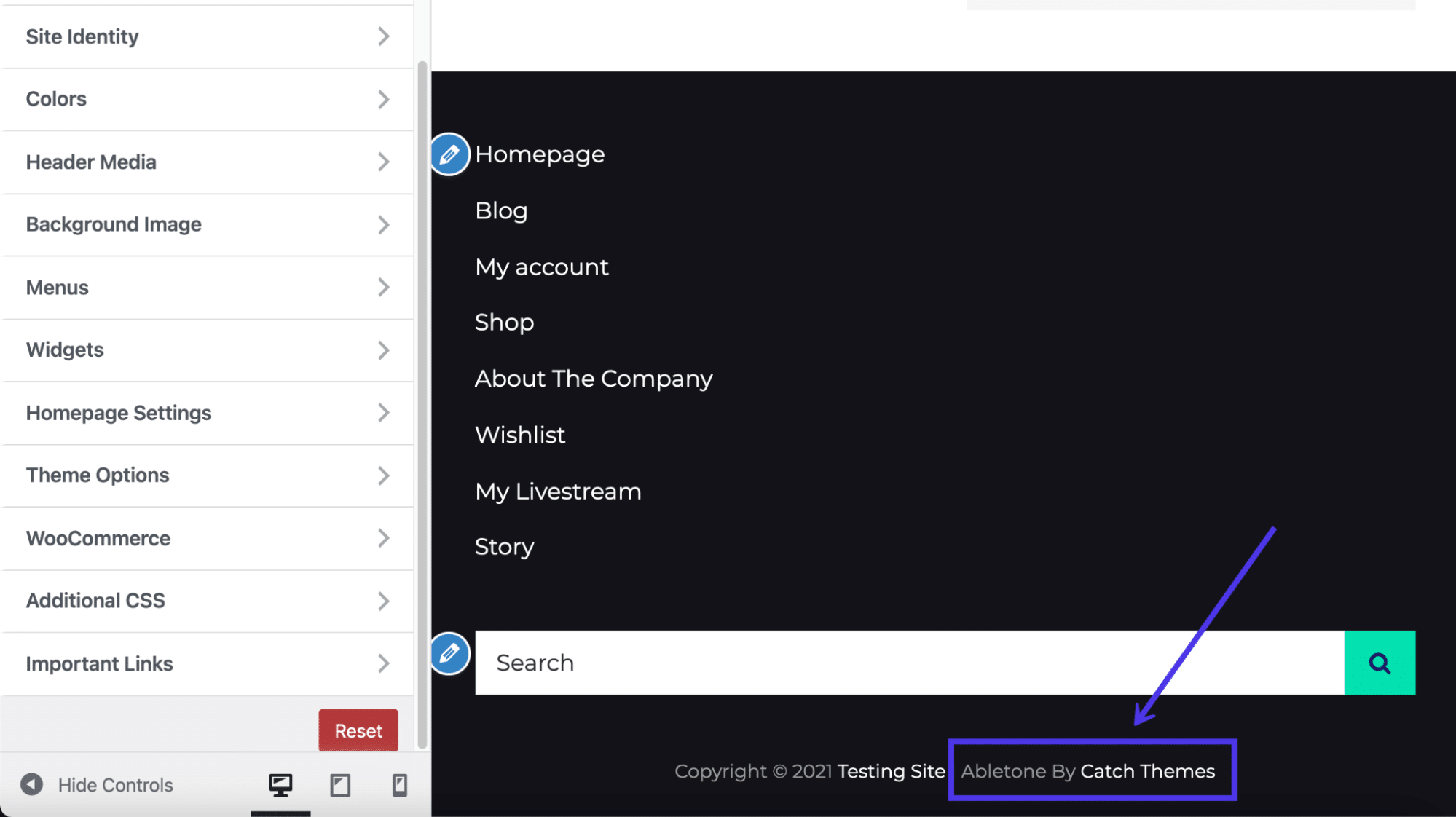
Connect to your site files using an FTP client, as discussed earlier in this article. Each theme developer differs on where they put the footer credit, but a good place to start is going to /public/wp-content/themes.
Choose the theme you take activated on your website.
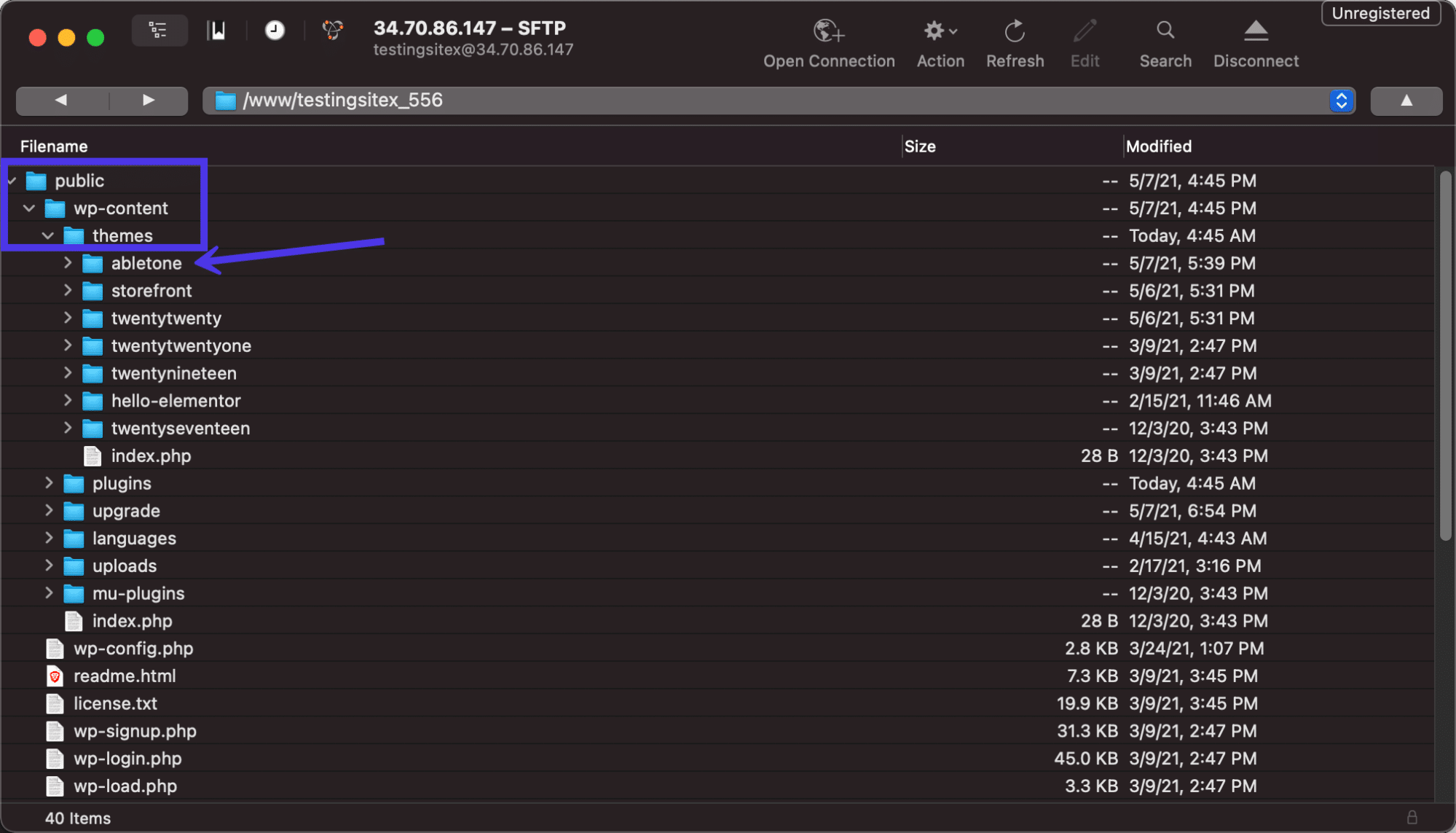
From here, one option is to open the main footer.php file in a text editor or PHP IDE and search for references to the footer credit. Apply the Find part in your chosen editor to type in and search for the exact text that appears as the credit bulletin in your footer.
Every bit with all themes, this may not be the right file for removing the footer credit; it entirely depends on how the theme was built. If you take no luck with the footer.php file, continue looking elsewhere.
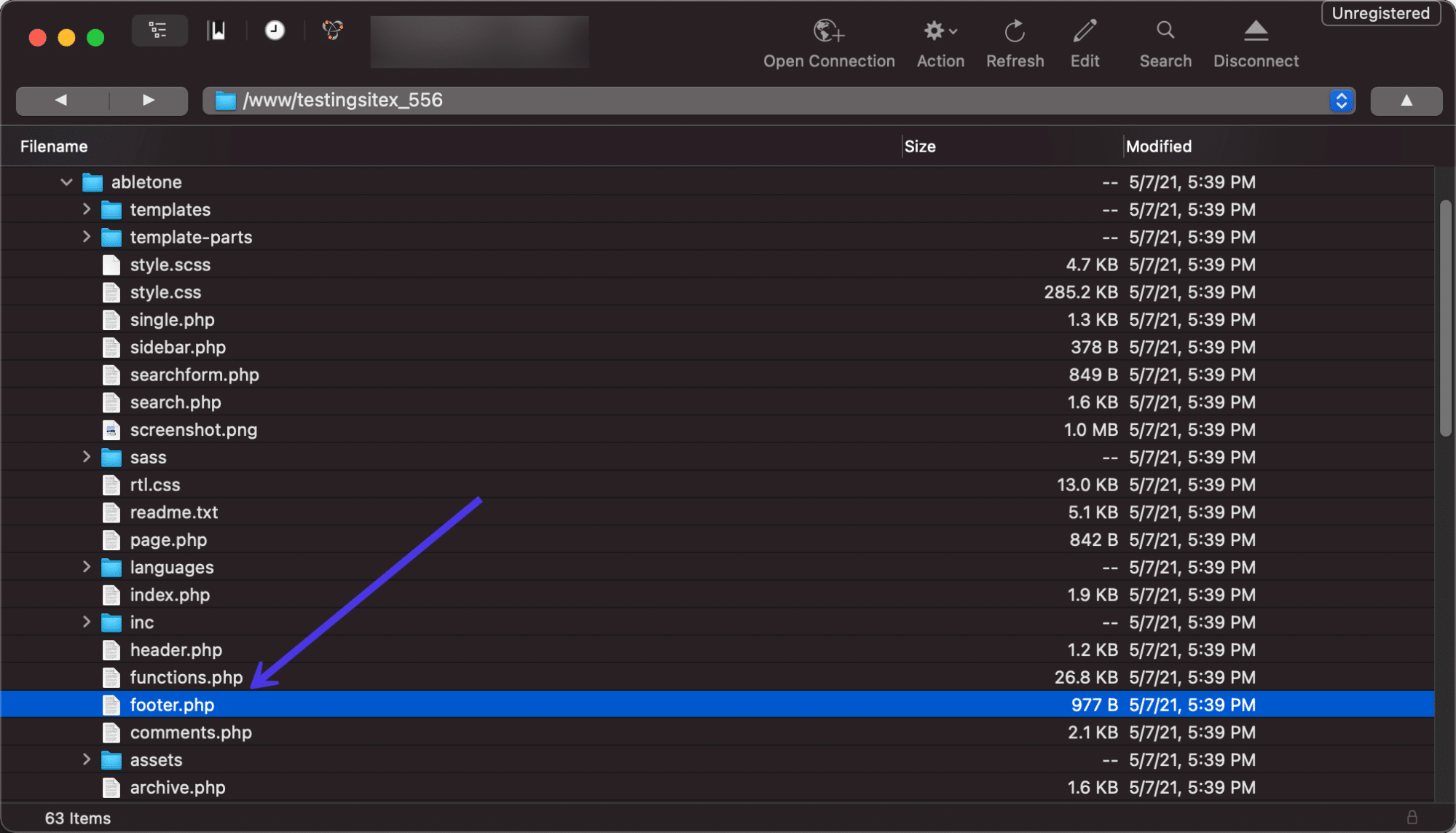
One of the well-nigh common places to discover the footer credit data code is in the /template-parts folder. We establish this was the case for the current test theme we take installed for this tutorial.
Nosotros can become to the /footer binder, then click on the site-info.php file. That site-info.php file (or some variant of that) is a common identify for storing the theme'due south footer credit information.
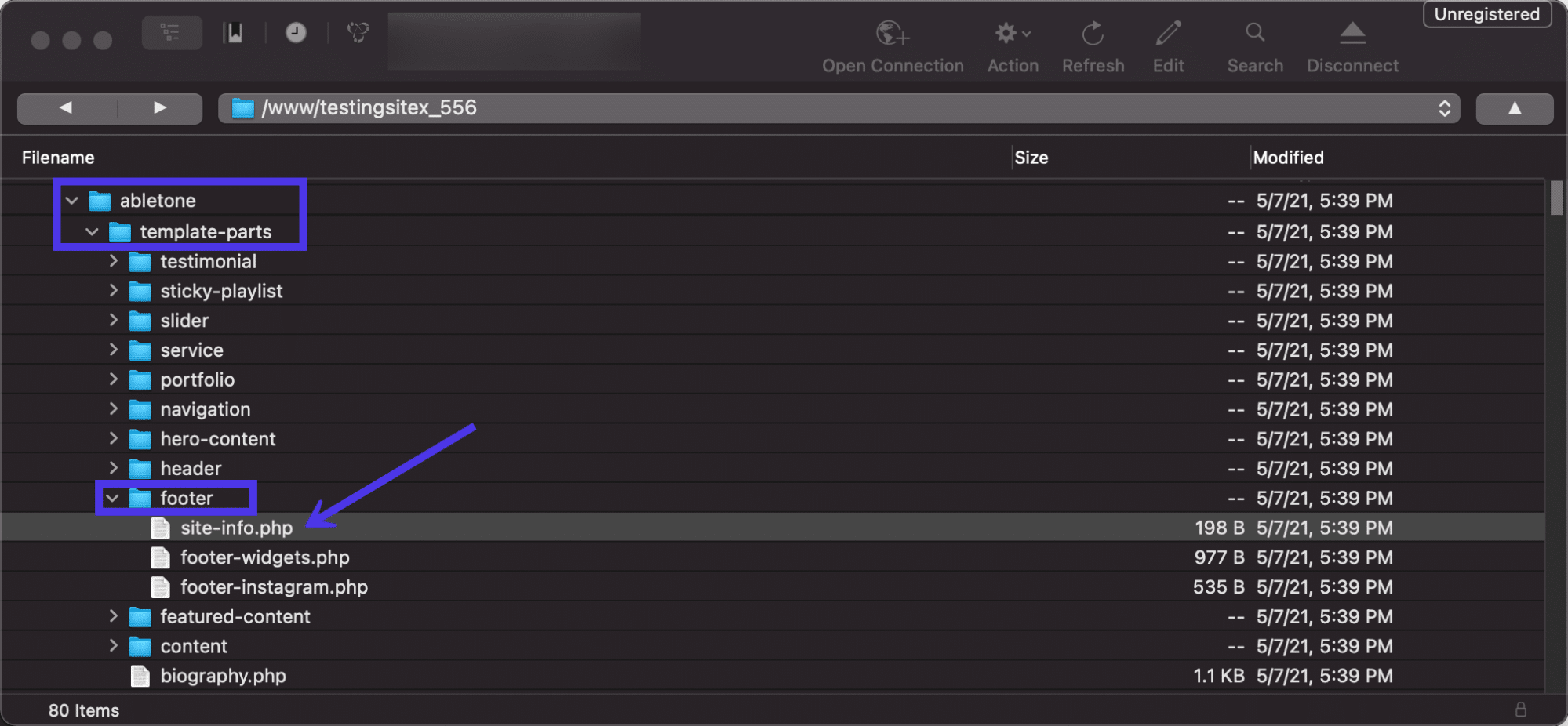
Feel free to either delete the footer credits or replace them with something else. For this situation, we'll only remove the credits claw and the do_action credits code at the lesser.

And that'southward successfully removed the entirety of the credit existence shown for the theme programmer. It also didn't have any issue on the footer content, like our widgets and menus.
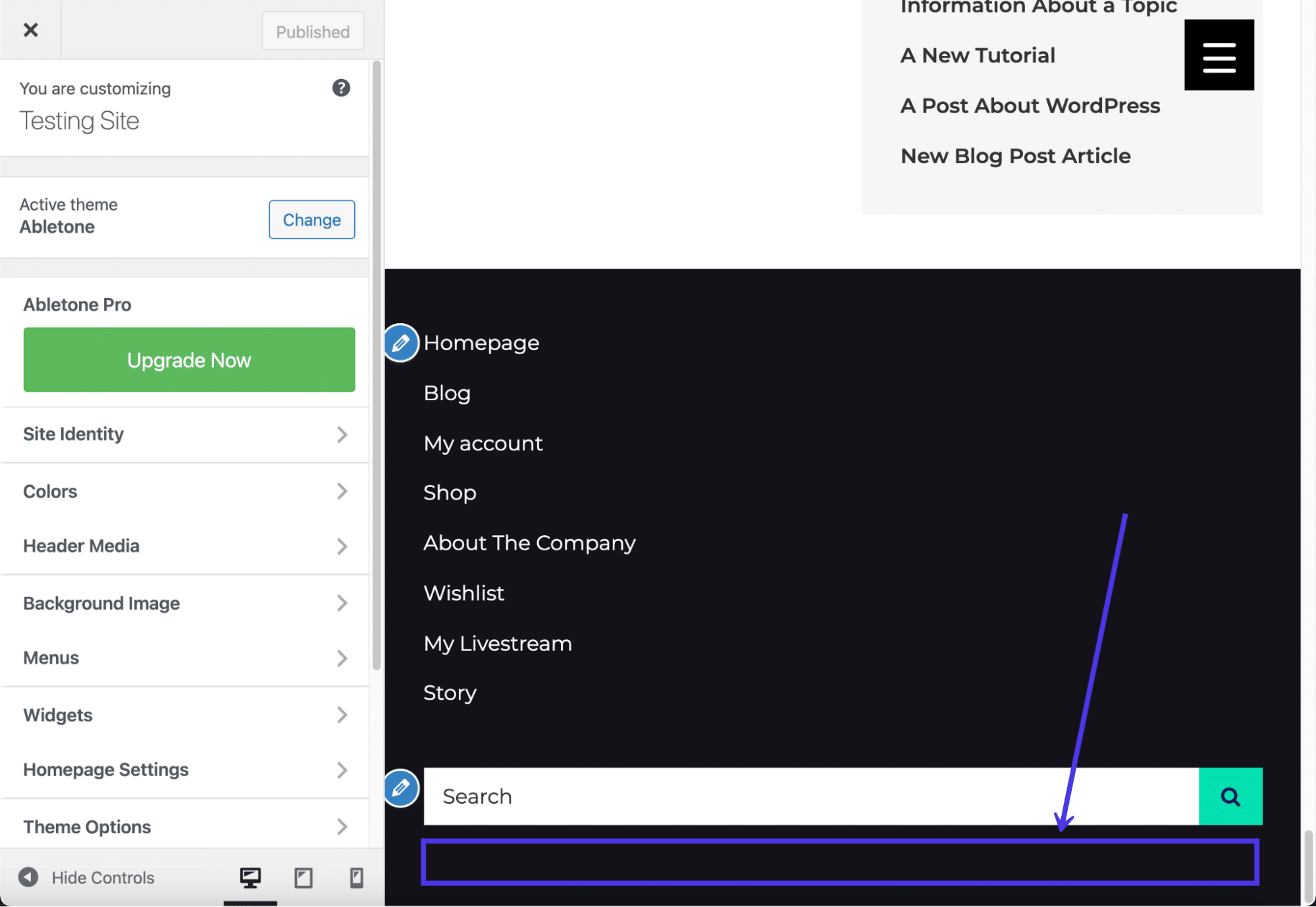
As mentioned before, one way to hibernate the footer credit, while too supporting the theme programmer and receiving far amend features, is to upgrade to the premium version of the theme. Keep an eye out for a button in your dashboard to upgrade to a Pro version, or go to the developer's site to make a payment.
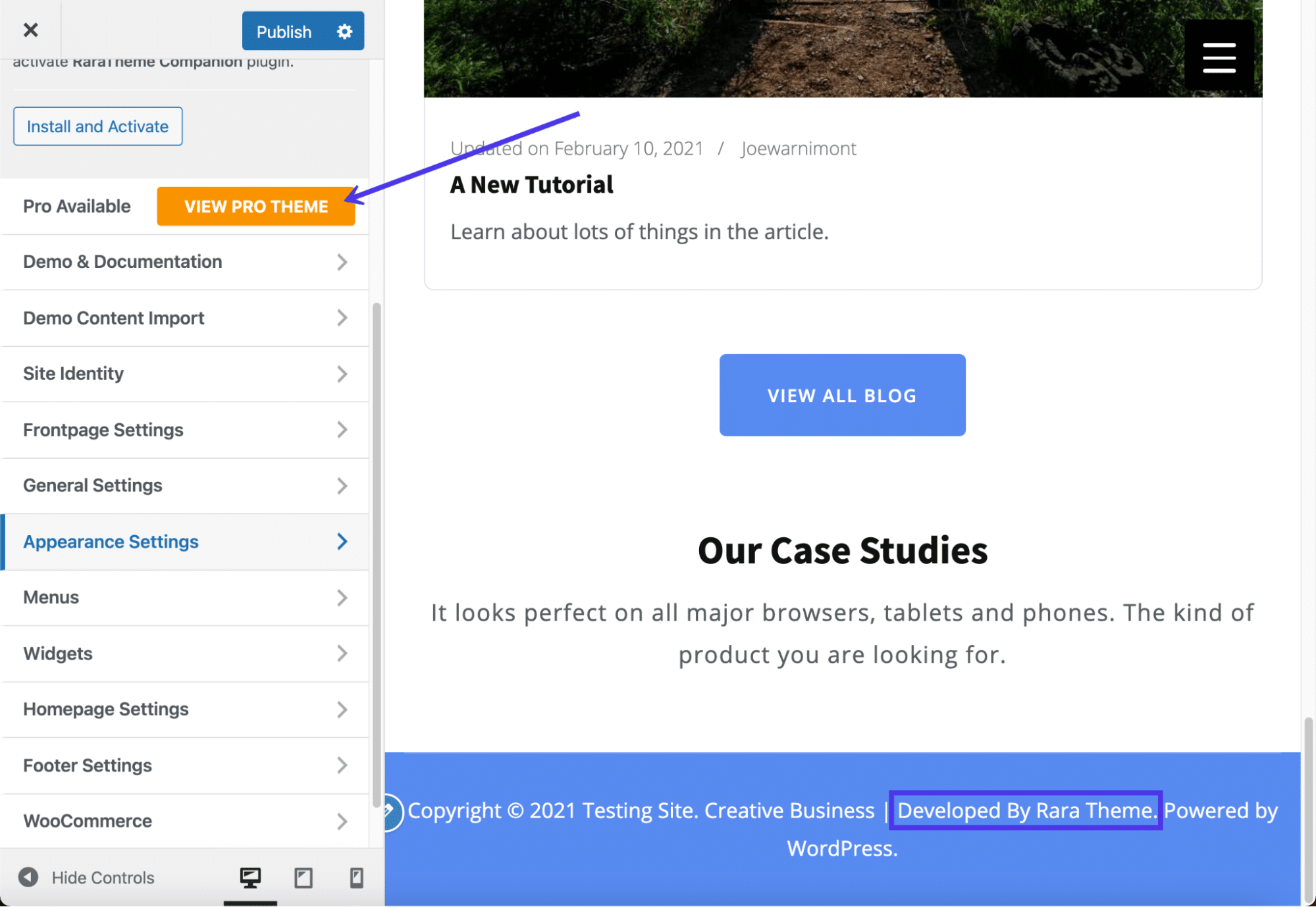
How To Remove the WordPress Footer Entirely
Although not recommended for most sites, it sometimes makes sense to remove the WordPress footer in certain situations altogether.
If you lot find that a WordPress footer causes also much clutter (which is common with landing pages), or if you'd instead the footer didn't get crawled by search engines, taking the footer out of the equation entirely may not be a bad option.
Keep in listen, however, that yous're non deleting the footer from your WordPress files. The footer.php file is a core part of the WordPress files, so y'all must leave information technology. However, nosotros can apply CSS code to tell WordPress non to brandish the footer and its content.
To hide the WordPress footer completely, go to the Theme Customizer and click on the Additional CSS tab.
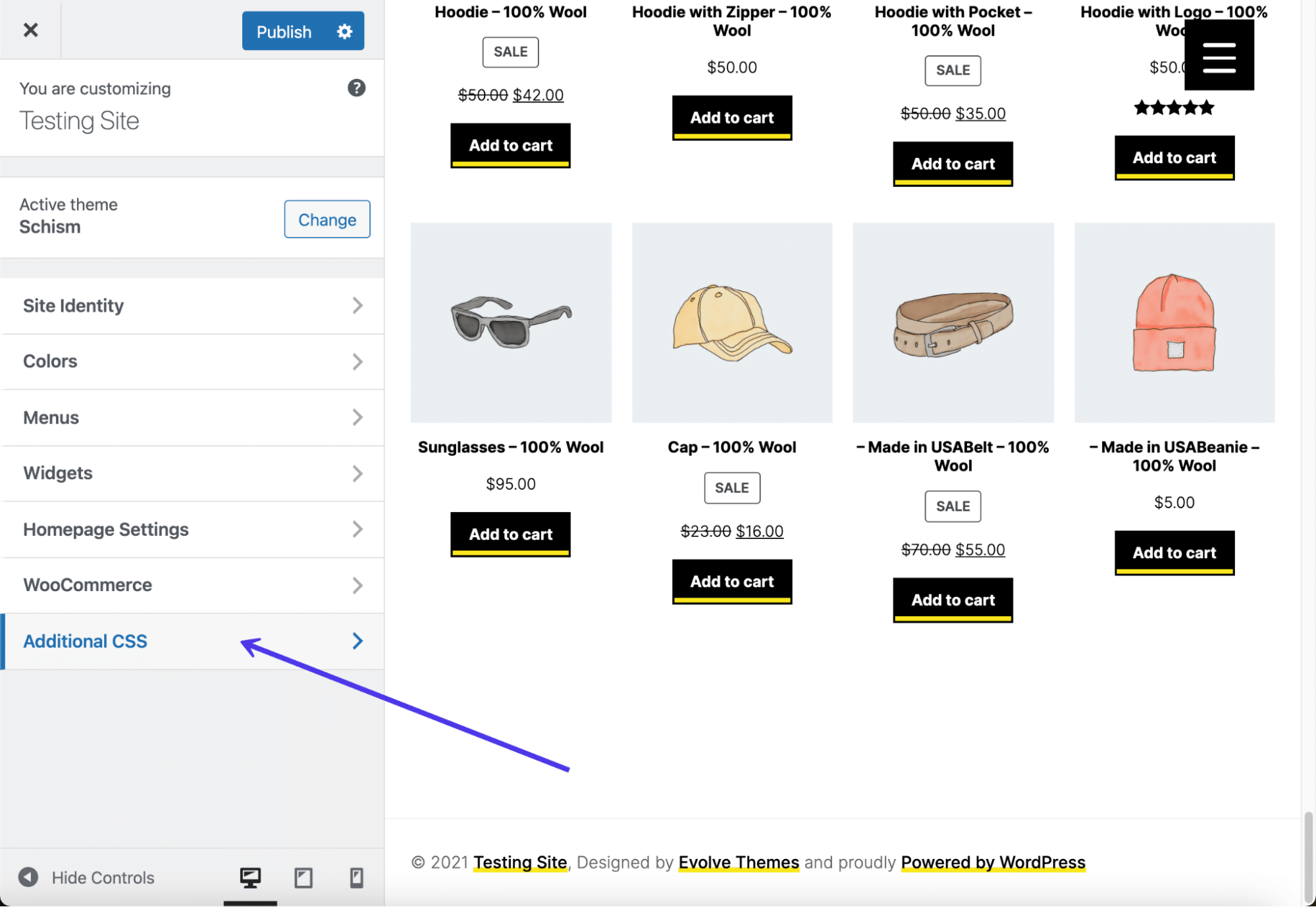
The goal is to paste CSS to tell WordPress that we don't desire to run into the footer on our website.
We're trying to hibernate everything in this instance, from the copyright information to the WordPress and theme developer credits. You lot tin can too use this method to hide items similar widgets and menus within your footer.
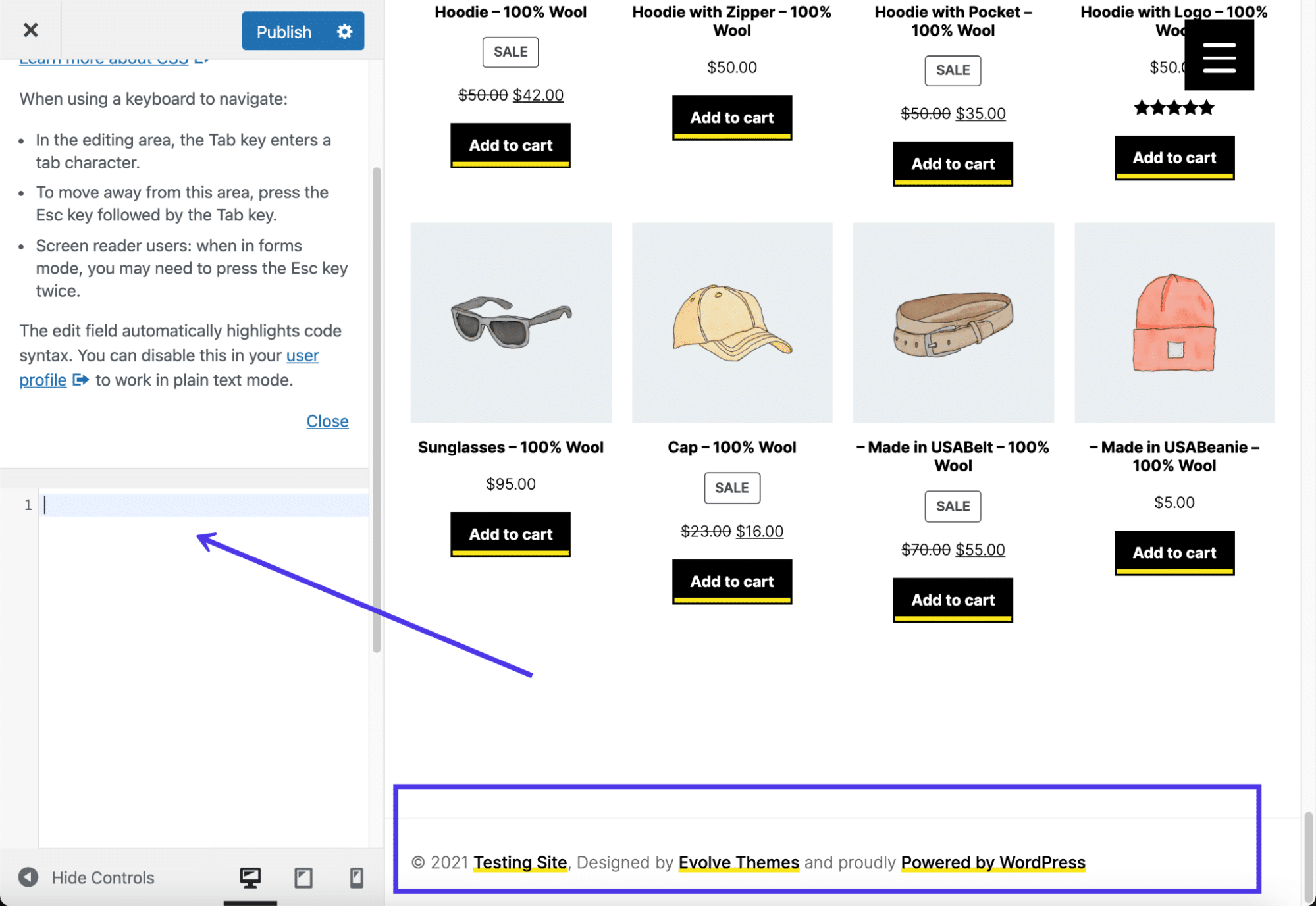
Go ahead and paste the following code in the CSS box:
footer{ display:none; } This tells WordPress to hide everything within the footer.php file. The file remains inside your file directory, only in instance yous'd like to re-add content in the future.
The Theme Customizer preview should at present show a bare infinite. Brand sure you hit the Publish button to see the results on the front end.
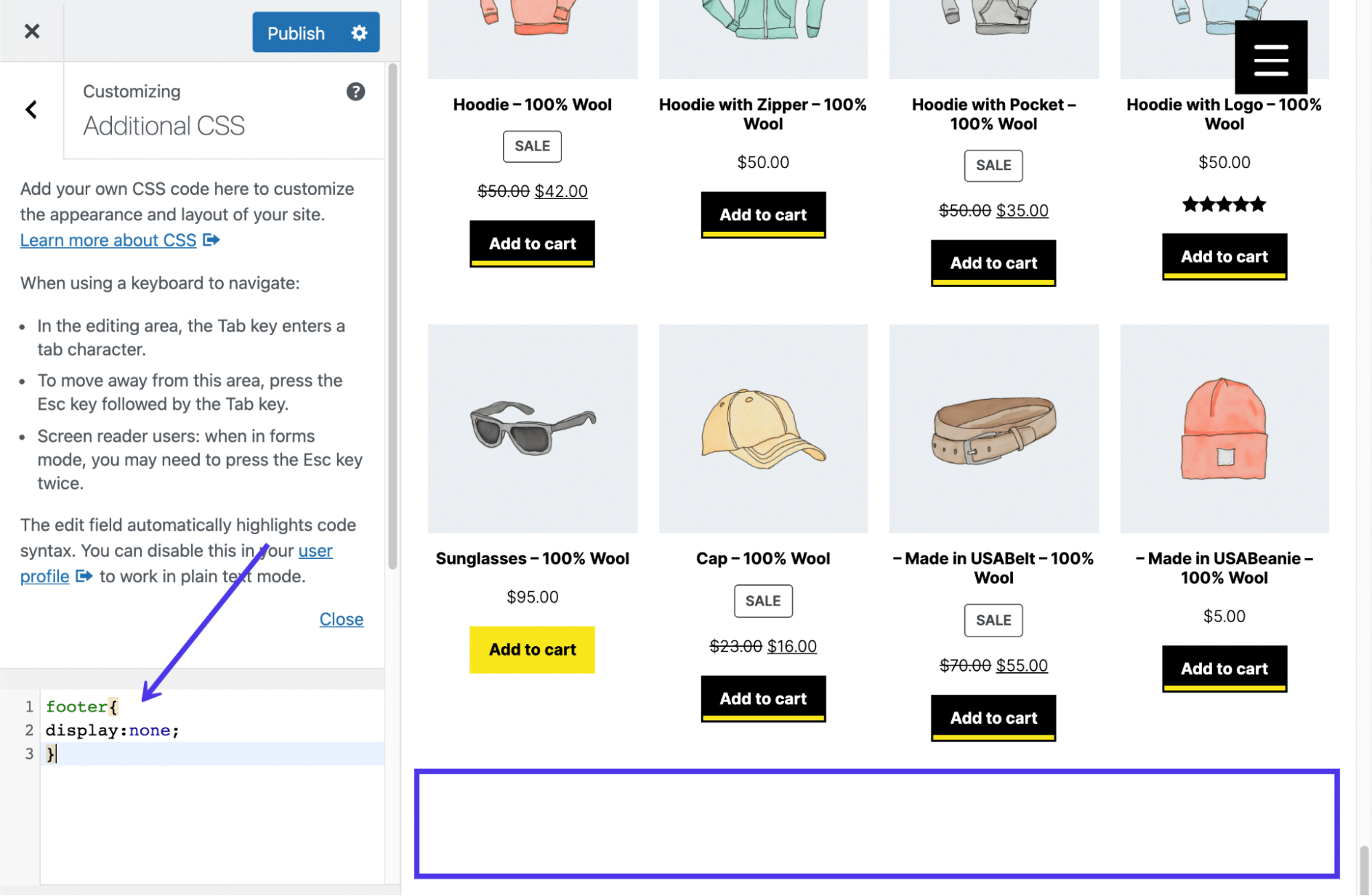
Although that CSS should work for nearly themes, you may find that the theme developer has a different file configuration. Some other fashion to potentially remove nigh of the footer content is by using the following lawmaking instead of the previous code discussed:
.site-info { brandish:none; } This option is less likely to work, merely it'southward non unheard of for theme developers to make a file called site-info.php in a footer's template-parts folder.
Summary
WordPress footers take many purposes, from adding social media buttons to displaying contempo weblog posts, support pages, and forms. The goal is to accept advantage of this extra infinite, since it's not wise to pack your main menu with too many links or try to make full your sidebar with an onslaught of content.
You've learned many ways to edit a WordPress footer. We promise you tin can now successfully edit and customize footers on any WordPress site!
Let us know in the comments below if you have whatever questions about editing the footer in WordPress!
Save time, costs and maximize site operation with:
- Instant help from WordPress hosting experts, 24/seven.
- Cloudflare Enterprise integration.
- Global audience reach with 29 information centers worldwide.
- Optimization with our congenital-in Awarding Performance Monitoring.
All of that and much more, in ane programme with no long-term contracts, assisted migrations, and a xxx-day-money-back-guarantee. Bank check out our plans or talk to sales to find the plan that's right for you.
Source: https://kinsta.com/blog/how-to-edit-footer-in-wordpress/
Posted by: serafinmotionve.blogspot.com


0 Response to "How To Update Footer In Wordpress"
Post a Comment